
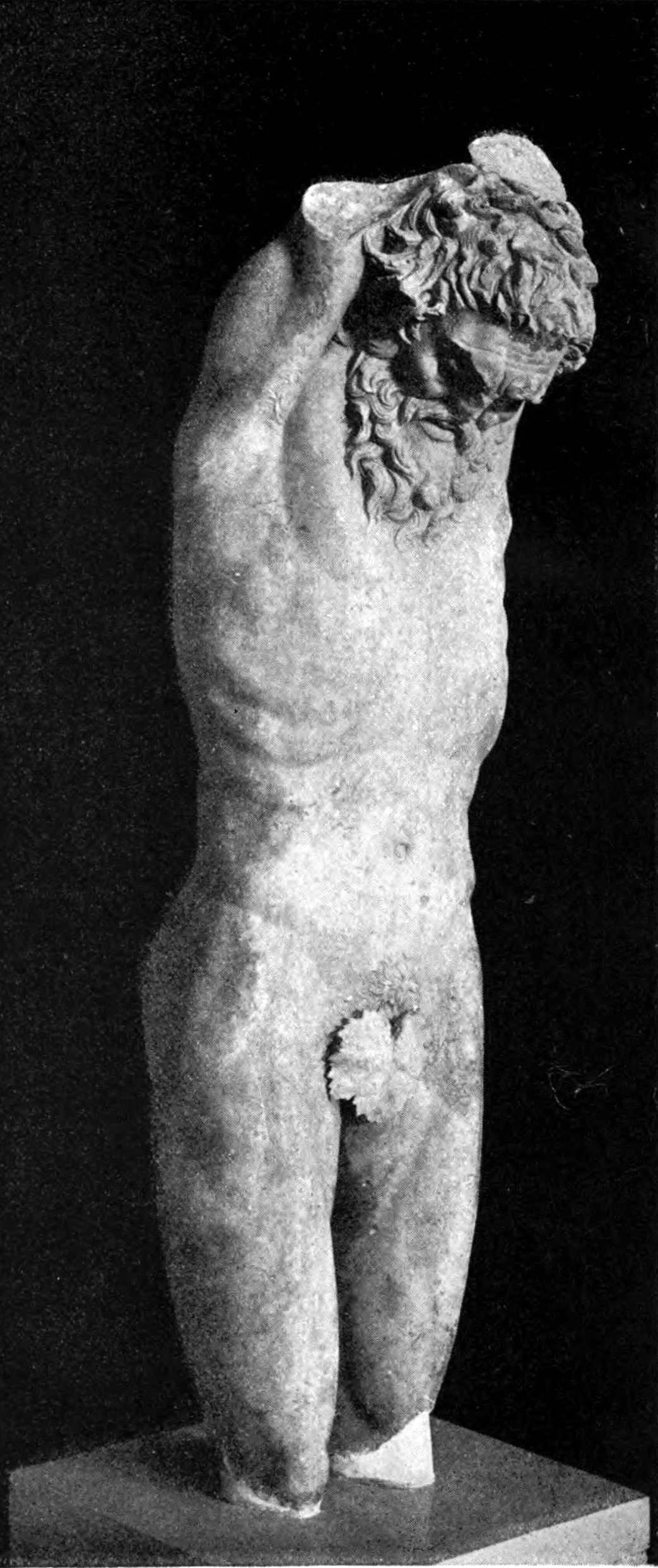
The Project Gutenberg EBook of Hellenistic Sculpture, by Guy Dickins This eBook is for the use of anyone anywhere in the United States and most other parts of the world at no cost and with almost no restrictions whatsoever. You may copy it, give it away or re-use it under the terms of the Project Gutenberg License included with this eBook or online at www.gutenberg.org. If you are not located in the United States, you'll have to check the laws of the country where you are located before using this ebook. Title: Hellenistic Sculpture Author: Guy Dickins Release Date: September 19, 2020 [EBook #63242] Language: English Character set encoding: UTF-8 *** START OF THIS PROJECT GUTENBERG EBOOK HELLENISTIC SCULPTURE *** Produced by Turgut Dincer, Charlie Howard, and the Online Distributed Proofreading Team at https://www.pgdp.net (This file was produced from images generously made available by The Internet Archive)
Transcriber’s Note
Larger versions of most illustrations may be seen by right-clicking them and selecting an option to view them separately, or by double-tapping and/or stretching them.


HELLENISTIC
SCULPTURE
BY
GUY DICKINS, M.A.
SOMETIME FELLOW AND LECTURER OF ST. JOHN’S COLLEGE, OXFORD
AND LECTURER IN CLASSICAL ARCHAEOLOGY IN THE UNIVERSITY OF OXFORD
WITH A PREFACE
BY
PERCY GARDNER, Litt.D., F.B.A.
LINCOLN AND MERTON PROFESSOR OF CLASSICAL
ARCHAEOLOGY IN THE UNIVERSITY OF OXFORD
OXFORD
AT THE CLARENDON PRESS
1920
Guy Dickins wrote these chapters on Hellenistic Sculpture as a brief sketch of the period to which he hoped to devote years of study. They foreshadow some of the theories which he intended to work out, and for that reason we believe that they will be useful to the student. There are obvious omissions, but no attempt has been made to fill up gaps in the manuscript, such as paragraphs on the Barberini Faun or the Attic Gaul, which were left blank in 1914.
The illustrations, which naturally must be limited in number, have been selected by me mainly on the principle of reproducing the less accessible pieces of sculpture while giving references to standard works for the others.
In preparing my husband’s manuscript for publication I have to acknowledge with gratitude the help of many friends. To Professor Percy Gardner I am particularly indebted for valuable advice and for his kindness in writing a preface to the volume; to Miss C. A. Hutton for her counsel throughout; and to Mr. Alan Wace for sending me photographs from Athens. I have also to thank the Hellenic Society, the Committee of the British School at Athens, and Dr. Caskey of the Boston Museum for permission to reproduce certain photographs.
MARY DICKINS.
Oxford, March, 1920.
vii
Among the losses which Oxford has suffered from the war, none is more to be regretted than that of the author of this volume. As an undergraduate, twenty years ago, Guy Dickins gave up his intention of entering the Indian Civil Service in order to devote himself to the study of Classical Archaeology, an allegiance from which he never swerved. In 1904 he went as Craven Fellow to the British School of Athens, and for five years lived mostly in Greece, studying and exploring. In 1909 he returned to Oxford as a Fellow of St. John’s College, and Lecturer in Ancient History. In 1914 he was appointed University Lecturer in Classical Archaeology; but before he could take up the duties of the post the great call came, and he obeyed it at once. A most efficient and able company commander, he served in the King’s Royal Rifle Corps. In July 1916 he died of wounds received in the battle of the Somme.
Before the war Dickins had been occupied in tasks of research, and in preparation for a teaching career. He had published several papers, and a volume of the catalogue of the Acropolis Museum. He had visited most of the museums of Europe, and brought back a large collection of photographs, which his widow has presented to the Ashmolean Museum. He was especially interested in Greek sculpture, and hadviii intended to collect materials for a history of art in the Hellenistic Age, a subject which has been neglected, but which is of the greatest importance. Several of his papers, such as those on the followers of Praxiteles and on Damophon of Messene, show in what direction his mind was working, though at the same time he was ready to take part in all the projects and the excavations of the School of Athens.
The present volume, alas, is the only fruit which the study of antiquity is likely to reap from such continued and thorough preparation. Every reader will regret that it was not written on a far larger scale. But it was planned as part of a complete history of ancient sculpture. No doubt, had he lived, Dickins would have rewritten it in a more complete form. But as it stands it is far too valuable to lose, full of suggestion, and pointing the way to important lines of discovery. In my opinion it contains the best that has been written on the subject; and one rises from the reading of it with a keen regret that the author could not bring his harvest to completion.
Dickins possessed in a high degree two qualities necessary for the best work in archaeology. He was distinctly original, always preferring to look at things in a light not borrowed from books or teachers but his own. And he was at the same time of cool judgement and strong in common sense. One of his fellow officers told me that whenever he was in doubt as to the course to be followed in attack or defence he consulted Dickins, and accepted his advice.ix He did not, like many young archaeologists, delight in starting brilliant hypotheses; but was ever content in coming nearer to the truth, and setting it forth in orderly and sober fashion. Such qualities would have made him an invaluable factor in the teaching of archaeology in England. I am told that the undergraduates of his college always felt that he set before them a high standard, and had no sympathy with anything which was pretentious or meretricious. The same qualities appeared in two or three courses of lectures on recent excavation, which he gave at the Ashmolean Museum.
I add as an appendix a list of Dickins’s published works, with a summary of their purpose and contents. They are not great in extent; he was not a rapid worker; but every one of them is worthy of careful reading, and does something to advance our knowledge of Greek art and ancient life.
PERCY GARDNER.
| PAGE | ||
| PREFACE | vii | |
| I. | THE SCHOOL OF PERGAMON | 1 |
| II. | THE SCHOOL OF ALEXANDRIA | 19 |
| III. | THE RHODIAN SCHOOL | 35 |
| IV. | THE MAINLAND SCHOOLS DURING THE HELLENISTIC AGE | 53 |
| V. | GRECO-ROMAN SCULPTURE | 68 |
| APPENDIX. A LIST OF THE PUBLISHED WORKS OF THE AUTHOR | 89 | |
| INDEX | 95 |
xiii
| 1. Hermaphrodite. Constantinople | Frontispiece |
| 2. Marsyas. Constantinople | Frontispiece |
| Facing page | |
| 3. Dancing Satyr of Pompeii. Naples | 8 |
| 4. Ludovisi Gaul. Rome, Museo Nazionale | 8 |
| 5. Head of a Dead Persian. Rome, Museo Nazionale | 12 |
| 6. Gaul’s Head. Cairo | 12 |
| 7. Group from the Great Frieze of the Altar at Pergamon: Giant and Dog. Berlin | 12 |
| 8. Group from the Telephos Frieze at Pergamon: Telephos and Herakles. Berlin | 12 |
| 9. Apollo of Tralles. Constantinople | 16 |
| 10. Ephebe of Tralles. Constantinople | 16 |
| 11. Venus Anadyomene from Cyrenaica. Rome, Museo Nazionale | 20 |
| 12. Sarapis of Bryaxis. British Museum | 20 |
| 13. Girl’s Head from Chios. Boston, Fine Arts Museum | 20 |
| 14. Bearded Head. Rome, Museo Capitolino | 22 |
| 15. Zeus of Otricoli. Rome, Vatican | 22 |
| 16. Isis. Louvre | 22 |
| 17. Priest of Isis. Rome, Museo Capitolino | 24 |
| 18. Capitol Venus. Rome, Museo Capitolino | 24 |
| 19. Ariadne. Rome, Museo Capitolino | 26 |
| 20. Inopos from Delos. Louvre | 26 |
| 21. Dwarf from the Mahdia Ship | 30 |
| 22. Old Woman. Dresden | 30 |
| 23. Grimani Relief. Vienna | 30 |
| 24. Nile. Rome, Vatican | 30 |
| 25. Aphrodite and Triton. Dresden | 34 |
| 26. Bronze Athlete from Ephesos. Vienna | 34 |
| 27. Praying Boy. Berlin | 38 |
| 28. Resting Hermes. Naples | 38xiv |
| 29. Hero Resting on his Lance. Rome, Museo Nazionale | 42 |
| 30. Jason. Louvre | 42 |
| 31. Draped Figure from Magnesia. Constantinople | 44 |
| 32. Eros and Psyche. Rome, Museo Capitolino | 44 |
| 33. Draped Figure by Philiskos from Thasos. Constantinople | 44 |
| 34. Victory of Samothrace. Louvre | 46 |
| 35. Chiaramonti Odysseus. Rome, Vatican | 50 |
| 36. Menelaos and Patroclos. Florence, Loggia dei Lanzi | 50 |
| 37. Youthful Centaur. Rome, Museo Capitolino | 52 |
| 38. Bearded Centaur. Rome, Museo Capitolino | 52 |
| 39. Hermes of Andros. Athens, National Museum | 54 |
| 40. Themis of Chairestratos. Athens, National Museum | 54 |
| 41. Hermes from Atalanta. Athens, National Museum | 54 |
| 42. Sleeping Hermaphrodite. Rome, Museo Nazionale | 56 |
| 43. Victory of Euboulides. Athens, National Museum | 58 |
| 44. Athena of Euboulides. Athens, National Museum | 58 |
| 45. Group by Damophon (restored) | 60 |
| 46. Anytos. Athens, National Museum | 62 |
| 47. Artemis. Athens, National Museum | 62 |
| 48. Veil of Despoina. Athens, National Museum | 62 |
| 49. Poseidon of Melos. Athens, National Museum | 64 |
| 50. Venus of Capua. Naples | 64 |
| 51. Appiades of Stephanos. Louvre | 72 |
| 52. Torso Belvedere. Rome, Vatican | 72 |
| 53. Athlete of Stephanos. Rome, Villa Albani | 72 |
Figs. 3, 7, 8, 15, 27, 28, and 53 are taken from casts in the Ashmolean Museum; figs. 4, 5, 11, 16, and 42 are from photographs by Alinari; figs. 12 and 21 are from photographs by the Hellenic Society; figs. 20, 30, 34, and 51 are from photographs by Giraudon; figs. 23 and 26 are from photographs by Frankenstein; fig. 29 is from a photograph by Anderson; figs. 36 and 50 are from photographs by Brogi; fig. 45 is reproduced by permission from the Annual of the British School at Athens, vol. xiii, Pl. XII.
1
Most of the writers on Greek art agree in calling the Hellenistic period an age of decadence. The period is a long one, lasting from the death of Alexander to the Roman absorption of the Hellenistic kingdoms, i.e. from about 320 to later than 100 B.C. The lowest limit is marked by the Laocoon group, and the fact that some critics have seen in that wonderful monument the climax of Greek art may make us pause in a hasty generalization. The decadence of the Hellenistic age is due simply to its exaggeration of certain tendencies already present in the fourth century, tendencies which accompany the inevitable development of all art gradually away from the ideal and gradually closer to realistic imitation of nature. As long as the technical skill of the Hellenistic artist shows no sign of abating, it is unfair and untrue to call his work decadent. The term is only justly applicable when loss of idealism or growth of frivolity in subject is accompanied by a decline in execution, by a want of thoroughness, and by a desire to shirk difficulties.
It is true to say that Greek art on the mainland enters on a period of decadence in the third century, for its execution and expression grow steadily worse after 250 B.C., but it is interesting to note that it reverts to a greater idealism. The last great artist of the mainland, Damophon of Messene, might have been a member of the school of Pheidias save for an inadequate mastery of the chisel.
2
On the other hand, the schools of Pergamon, Alexandria, and Rhodes show no falling off in technical skill as long as they remain independent of Rome. Even their idealism does not wholly decline, for the Gallic victories of Attalos and Eumenes brought about an idealist revival in Pergamene art associated with the decoration of the great altar. Rhodes remained ever wedded to the athletic ideal. Alexandria delighted most in scenes of genre and realistic imitations of nature. But all turned out work of marvellous quality, and it is mainly a vagary of fashion in criticism that now induces so many authorities to label as decadent wonderful masterpieces of sculpture like the Victory of Samothrace, the kneeling boy of Subiaco, or the Silenos with the young Dionysos. Works so full of human nature and so rich in sympathy may well claim to replace by their romantic appeal the classical feeling of the fifth century. It is only when romance becomes sentimentality that it meets with just condemnation.
The outstanding feature of the history of Greek sculpture during the Hellenistic period is the transference of its vital centres from the mainland to the new kingdoms of the Diadochi on the east and south and to the great new free state of Rhodes. The chief cause was an economic one. Alexander’s campaigns brought about a revival of prosperity and wealth in the Greek world, but among his friends and not among his enemies. Athens was always his enemy and the enemy of his Macedonian successors. Consequently during the whole period from the death of Alexander to the Roman conquest Athens was either under Macedonian rule or in danger of Macedonian attack. It was Macedonian policy to keep her weak and isolated, and her trading supremacy3 began to be transferred to the island of Delos. The great days of Attic art passed with the death of Praxiteles and the coming of Alexander. In the Peloponnese the pupils of Lysippos carried on into the third century the traditions of the Sikyonian school, but we can see from such knowledge as we possess of their activities that the wealth and fame of the new kingdoms were already calling the artists to abandon the impoverished towns of the mainland. The Peloponnese also opposed Alexander and his successors, and Macedonian garrisons held the chief fortresses of the country. We find Eutychides of Sikyon working for Antioch, and Chares working at Lindos in Rhodes. After the date given for the pupils of Lysippos in 296 B.C., Pliny makes the following significant statement: ‘cessavit deinde ars, ac rursus Olympiade CLVI (156 B.C.) revixit.’1 For 150 years the history of artistic development must be studied on the eastern side of the Aegean.
After the preliminary conflicts between the successors of Alexander for the partition of the empire a number of new states arose, which are known to us usually as the kingdoms of the Diadochi or Successors. Of these the three most important were Macedonia, Syria, and Egypt, under the rule of Antigonids, Seleucids, and Ptolemies respectively. Of smaller importance, but quite independent and self-sustaining, were Bithynia, Pergamon, and the island republic of Rhodes, the latter being the only one which maintained its Hellenic democratic institutions. The attitude of these states towards art differs remarkably. Macedonia remained always a military monarchy in a condition of almost constant frontier war, and was wholly uninterested in artistic developments.4 Syria seems from the first to have fallen under Semitic and oriental influences, which destroyed its appreciation of the purer forms of Greek art. Bithynia, Pontos, and Cappadocia were barbarian rather than Greek. As a result, we find that the old artistic traditions are maintained prominently in three only of the new states: Pergamon, the home of the very Hellenic race of the Attalids; Rhodes, whose pure Hellenic descent was untouched; and Alexandria, which became practically a Greek town in the midst of an older Egyptian civilization.
The kingdom of Pergamon included the area of the old Ionian cities, and inherited, therefore, an artistic tradition as old as its own existence. It is no matter for surprise that its art-loving monarchs should have founded a great library and a great school of sculpture in open rivalry with the richer resources of Ptolemaic Alexandria. The art of Pergamon is well known to us from the magnificent groups and figures of the Gallic dedications of Attalos I after his victories about 240 B.C., and from the marvellous frieze of the altar excavated in situ by the Germans, which belongs to the period of Eumenes II and the early second century. But before we come to these later developments of Pergamene art, it is important that we should discover the earliest tendencies and predilections of the Pergamene court in the first half of the third century. We are told2 that the most remarkable work of Kephisodotos, the son of Praxiteles, was his ‘symplegma’ at Pergamon—probably an erotic group—which was noteworthy for its extraordinarily naturalistic rendering of the pressure of the fingers into the flesh. Such erotic groups of nymphs and satyrs or hermaphrodites exist in5 our museums, and are ultimately derived from this type of statue. Actual discoveries at Pergamon support this conception of early third-century Pergamene art. The well-known Hermaphrodite in Constantinople (Fig. 1) and a beautiful girl’s head in Berlin3 show the extreme delicacy in the rendering of flesh and the fondness for a sensual body treatment which we might expect from an Ionian version of the schools of Scopas and Praxiteles. The existence of such a school in Ionia in the late fourth century is highly probable. The Pergamene school of the early third century would seem to be the later natural development of the creators of the Ephesos columns and the Niobids. Scopaic expression and Praxitelean flesh treatment are the hall-marks of the school. Another work of importance for the early Pergamene period is the Crouching Aphrodite type, so popular in Roman times. Of this statue Pliny tells us: ‘Venerem lavantem se Daedalus fecit.’4 This Daedalus was a Bithynian artist of the early third century, who must have fallen under the general influence of the prevalent Pergamene school. His Aphrodite5 shows exactly the artistic tendencies of the early Pergamene school. The motive is unimportant and frivolous—a genre motive of a girl washing herself—but it is used for the purpose of demonstrating the technical skill of the artist in displaying the nude female form. The artist does not use all his skill in the effort to produce a noble or even a romantic ideal. The subject is immaterial, provided it affords a chance of showing his technical skill. The crouching attitude is a new one in art, and one well adapted for exhibiting the6 human body in all its variety. It appears again in the Attalid dedications, and was evidently a favourite at Pergamon. Another example is in the well-known Knife-Grinder of the Uffizi,6 part of a great group of Marsyas, Apollo, and the Scythian slave, which we can certainly connect with this period of Pergamene art. The Knife-Grinder himself is a copy and not an original. That is made clear by his late plinth, in spite of his magnificent workmanship. But the finer copies of the hanging Marsyas, which belongs to the group, are in a Phrygian marble, betraying their Pergamene origin. These copies of the Marsyas are divided into two types: a so-called ‘red’ type (Fig. 2), made of the Phrygian marble, in which the expression of agony is more marked, and a white type7 in which the face is less distorted. A theory has been put forward that the white type represents an early third-century prototype, while the red type is a Pergamene variation of rather later date.8 We may, however, hesitate to see sufficient difference in the two types to make so wide a distinction. The white type may be merely a less masterly adaptation of the red. An Apollo torso9 in Berlin from Pergamon with the right hand resting on the head agrees with a marble disc in Dresden10 showing a similar figure confronted by the hanging Marsyas. We may therefore associate this figure as the third member of the group with Marsyas and the Knife-Grinder.11 The Apollo is a seated figure of distinctly Praxitelean influence. The keen expression of the Knife-Grinder and the agonized7 face of the Marsyas may equally well be attributed to Scopaic teaching. We have a good example of this mixed tradition in early Pergamene art. Technically we are at once compelled to notice the immense advance in realism and anatomical study. The hanging Marsyas shows a correct appreciation of the effects of such a posture on swollen veins and strained abdomen. The corner of the mouth is drawn up in agony; the forehead is corrugated with rows of wrinkles; the hair, even on the chest, is matted with perspiration. One would say that so remarkable a statue could only be studied from nature, and one recalls the stories of Parrhasios, who is said to have used an actual model for his Prometheus Bound.12 We are long past the time when sculptors worked from memory. Even Praxiteles was said to have made his Cnidian goddess with Phryne as a model. In the Knife-Grinder we may perhaps detect some of the earliest traces of that exaggeration of the muscles which will so soon affect athletic art.
One of the most important of the Pergamon finds was the little bronze satyr,13 which has enabled us to associate with Pergamon a whole host of satyr types of more or less similar style. The Dancing Satyr of Pompeii (Fig. 3) and Athens, the Satyr of the Uffizi clashing cymbals,14 with its replica in Dresden, and the Satyr turning round to examine his tail15 are all variants of the new artistic cult of the satyr, a cult which seems to have had a Pergamene origin.16 The satyr gave to the Pergamene artist just that opportunity for the display of wild and somewhat sensual enthusiasm which he8 wanted, for new and original poses, and for combination with his nymphs and bacchanals. In Phrygia especially orgiastic manifestations of religion were the regular practice, and dancing was both wild and universal. The new artistic conceptions show the clear influence of this spirit on the more restrained art of the fourth-century schools. The Dancing Maenad of Berlin,17 the Aphrodite Kallipygos of Naples,18 and the famous Sleeping Hermaphrodite19 are further examples of the marvellous flesh treatment and the wild frenzy of movement which we learn to associate with third-century Pergamene art.
Apart from the general spirit of Pergamene work there are several definite technical peculiarities which enable us to postulate a Pergamene origin for many unclassed works of the Hellenistic age. These can be gathered from the definitely Pergamene Gallic statues, which we have yet to discuss, and from the satyr types already mentioned. One is the hair tossed up off the forehead and falling in lank matted locks of wild disordered type. The eyebrows are usually straight and shaggy, with a heavy bulge of the frontal sinus over the nose. The cheekbones are prominent, and the lips thick and parted. In the body the most marked feature is the desire to get away from the old-fashioned straight plane for the front of the torso. The lower part of the chest usually projects strongly, while the waist is drawn in, so that the profile of the torso is shaped like a very obtuse z. In the female body there is a general affection for rather heavy forms with a good envelope of flesh. The artist’s skill is here devoted mainly to the delineation of surface. The heads of9 such female figures as we can attribute to Pergamene art show very little expression. The hair is done on the Praxitelean model, but the locks tend to become more rope-like and twisted as time goes on. We cannot point to any great peculiarities in the Pergamene treatment of women. Neither Lysippos nor Scopas seems to have had much effect on the feminine types of Greek sculpture. The whole Hellenistic age is in servitude to Praxitelean ideals of women whether in Alexandria, Rhodes, or Pergamon. The differences are only in the details of execution, the Pergamenes tending always towards clear cutting of hair and features, while the Alexandrines preferred an impressionist smoothing away of all sharp edges.
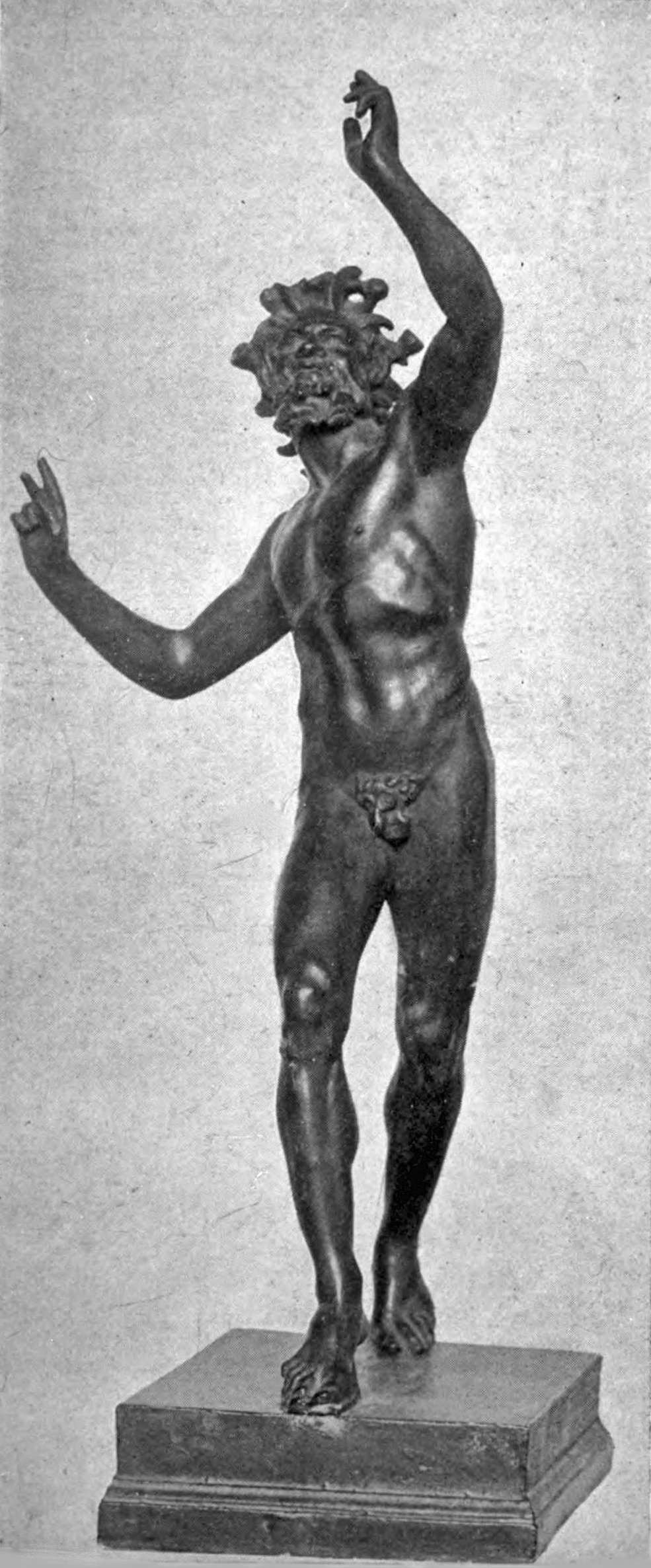
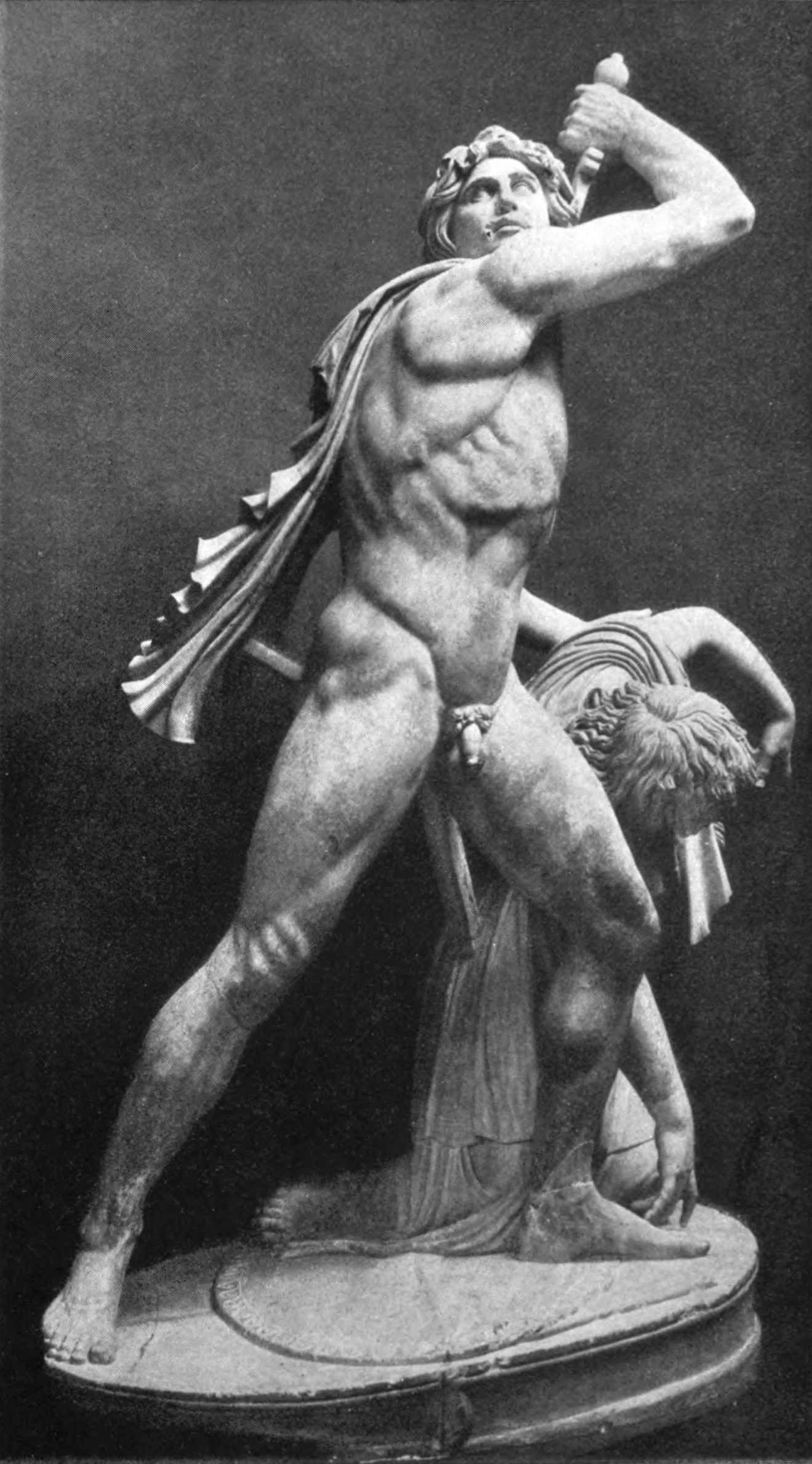
We come now to the two great dedications of Attalos for his victories over the Gauls.20 These were made at some time later than 241 B.C., and consist of two series of statues. One is life-size or larger, and is represented by some of the best-known examples of Hellenistic sculpture, such as the Dying Gaul21 and the Ludovisi group of a Gaul slaying his wife and himself (Fig. 4). The other consisted of a number of small figures about three feet high, and was dedicated by Attalos in Athens, where they stood on the parapet of the south wall of the Acropolis. Four battle-groups were included—a gigantomachy, an Amazonomachy, a battle of Greeks and Persians, and a battle of Greeks and Gauls. Several copies from this smaller group are in existence, the best known being in Naples.22 The originals of both groups were probably in bronze, and we have the names of some of the artists of10 the larger group, Phyromachos, Antigonos, and Epigonos or Isigonos. Stratonicos and Niceratos of Athens may also have taken part.23
These works all deserve careful study, as they differ in many ways from the rather sensual and ecstatic art which we know to have preceded them, and the very baroque and exaggerated art which followed them in the next century on the great altar. Eumenes and Attalos had to fight for their lives against the Gauls, and a temporary return to an austerer and less luxurious art would be a not unnatural result of the great war. We certainly find in the treatment of the Amazons or of the wife of the Ludovisi Gaul no such insistence on sexual detail as marks the earlier studies of the feminine form, and the expression of the male figures is distinguished by more ideal emotions of courage or resignation than the frenzy of the satyrs and the passions of the later gods and giants. The Attalid dedications show some bravura of pose; the Ludovisi Gaul is a little histrionic in his attitude; but as a whole they are sober and restrained sculpture, when compared with the satyrs on the one hand and the altar frieze on the other. In that sense they represent the high-water mark of Pergamene art, inspired with an equal skill, but with a nobler ideal than the earlier work, and not subject to the somewhat grotesque exaggerations of its later activities. Greek art has few nobler figures to show than the Dying Gaul of the Capitol, itself an admirable and closely contemporary copy, perhaps made in Ephesos, of the bronze original at Pergamon. The sober restraint of the torso modelling is remarkable, and contrasts most forcibly with the altar frieze. The pathos of the expression and attitude is not forced or11 exaggerated in any way, and if the curious hair gives a touch of strangeness to the head, we must account for it as a naturalistic detail of the Gallic fashion of greasing and oiling the hair. The Ludovisi Gaul is a superb work, rather more exaggerated, both in expression and in detail, than the Capitol figure. The right arm is perhaps wrongly restored, as it hides the face from the front, but it is more likely that the group should be looked at from a position farther to the left, where the face, the fine stride, and the technical tour de force of the cloak can all be appreciated more fully. The woman’s face is not well finished, and her whole pose is more effective from the other point of view. The Pergamene peculiarities in the treatment of chest and waist are clearly visible in this figure.
The little figures in Naples, the Louvre, Venice, and elsewhere are partly recumbent dead figures of Persians, giants, and Amazons, and partly crouching figures defending themselves. None of the victorious Greeks seems to have survived, except possibly the torso of a horseman in the Terme Museum. They are dry, rather hard figures, much inferior in skill to the larger group and much closer to the bronze originals which they represent. The head of a dead Persian in the Terme Museum (Fig. 5) is probably a more worthy copy (on a larger scale) of one of the figures of this series. Its type of features and its moustache resemble the Ludovisi Gaul. Another fine Gallic head is in the Gizeh Museum at Cairo (Fig. 6). This has been often called an original, an Alexandrian variant of the Gallic dedications. There is, however, no need to separate it from the others. If it shows more emotion, that only brings it rather closer to what we know of earlier Pergamene art. The provenance12 of the Gizeh head is disputed, and it may be only a recent importation into Egypt.24
We now come to the frieze of the great altar at Pergamon (Fig. 7), the contribution of Eumenes II to the series of monuments commemorating the defeats of the barbarians. Here again we have several inscriptions of artists,25 which are especially interesting as showing that four foreign artists of Attic, Ephesian, and Rhodian origin all contributed to the great monument. It is, however, quite uniform and unique in character, and shows a baroque exaggeration of expression and of muscular detail, which in the end becomes monotonous and overpowering. The slight tendency towards a histrionic attitude, which we noticed in the Ludovisi Gaul, has now become much more pronounced. Most of the figures are in stage attitudes of fright, ferocity, attack, or defence. Their bodies are covered either with drapery in wild disorder, or, if naked, with massive rolls and lumps of muscle, which are almost comical in their exaggeration. Their hair is in unrestrained twisted snaky locks; their faces are distorted in fierce expressions of anger or alarm; they are in every conceivable attitude of attack or defence. When we add to this the colossal size of the monument and its figures, we can well understand how its remains became known to early Christian writers as the throne of Satan.26
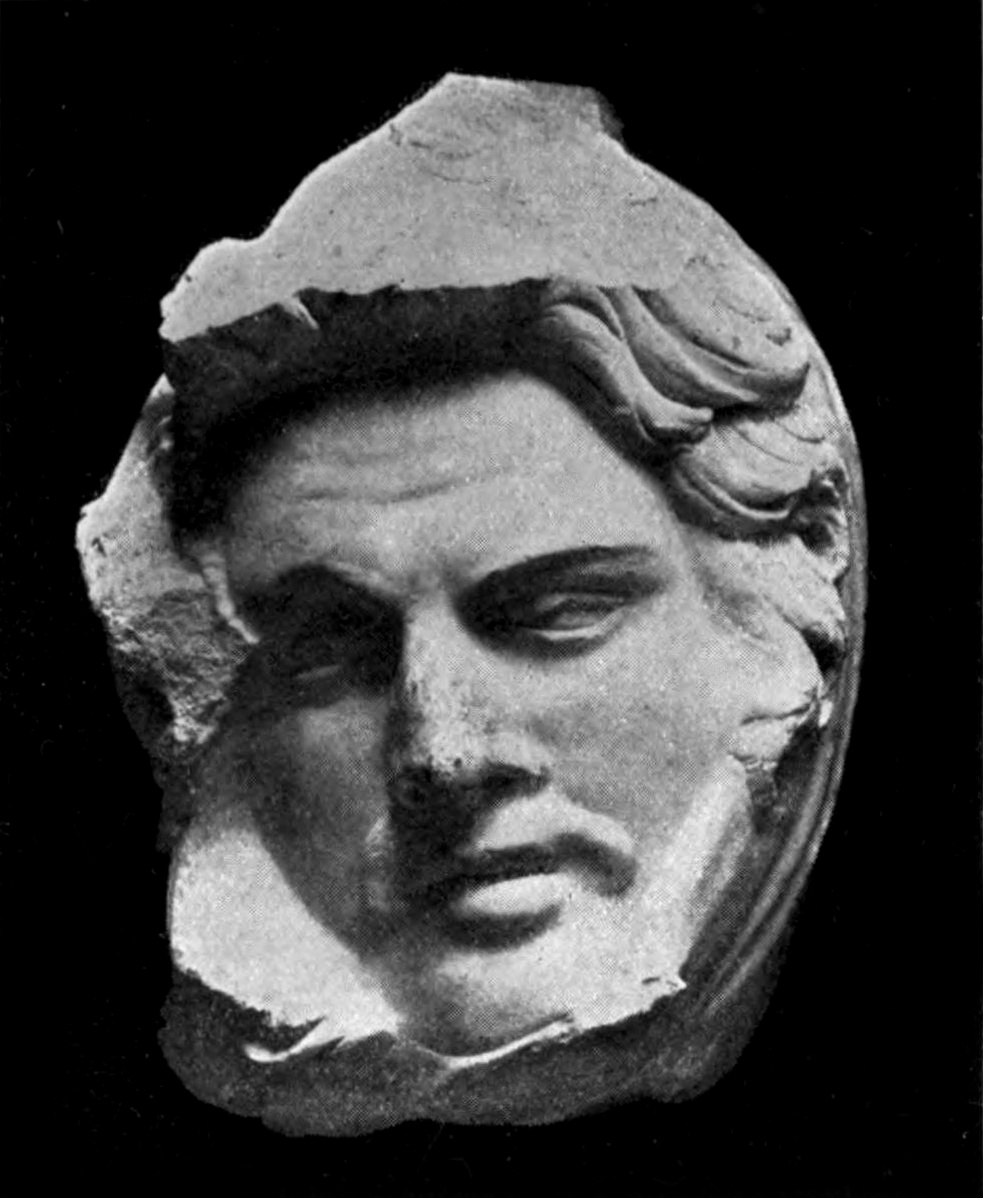
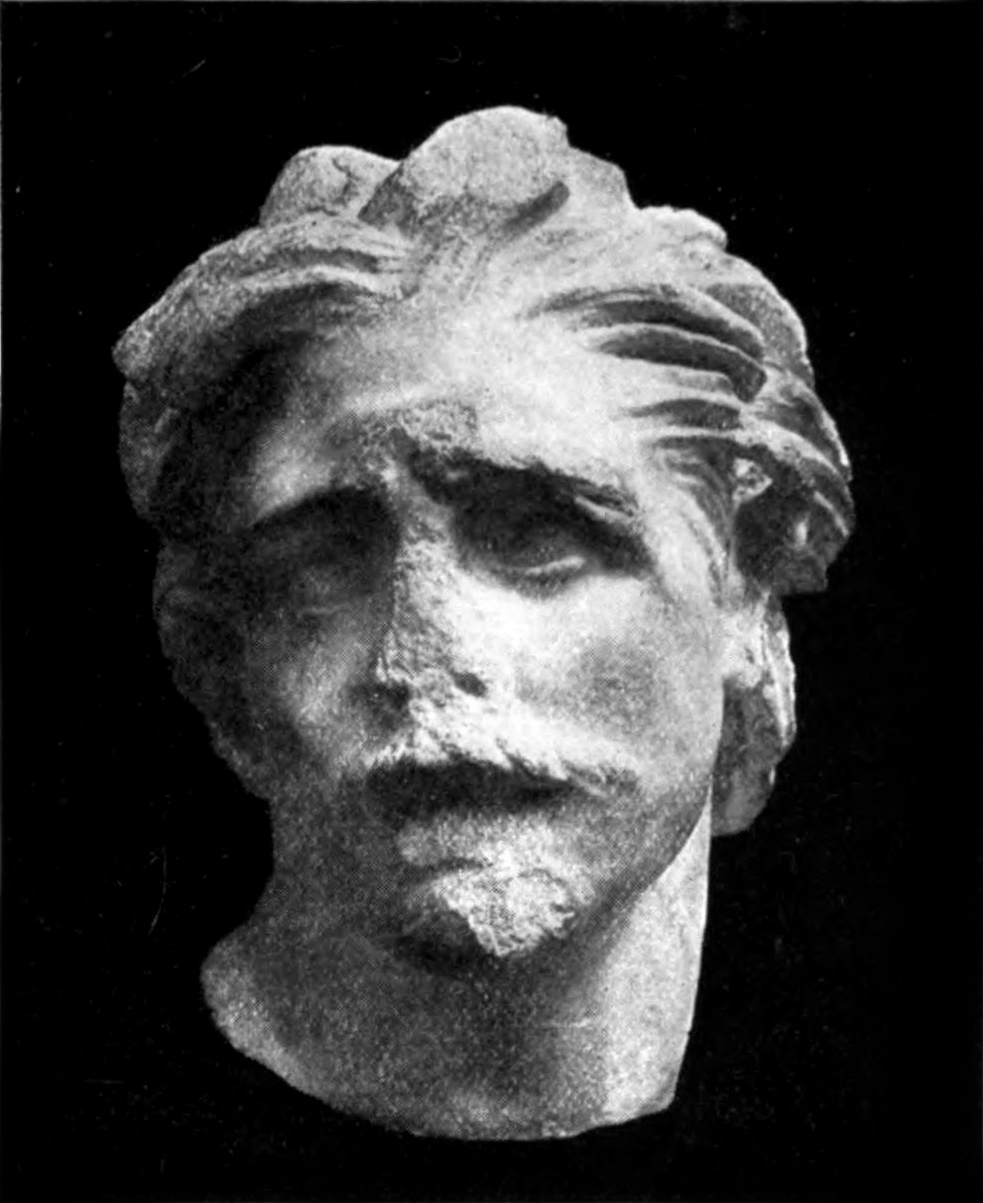


The subject of the frieze is the battle of the gods and the giants, and the members of the Olympic Pantheon are represented in attitudes of triumph over the serpent-footed denizens of Tartarus. This is probably the first appearance in sculpture of the serpent feet of the giant. Every earlier13 artist had realized how such a ridiculous detail would detract from the strength and probability of his figures, but the Pergamene artists are so glad of the chance of displaying extra technical skill that they pass over the artistic difficulty without hesitation. The great frieze of the altar is like the work of a megalomaniac. The restraint and good taste which have accompanied all Hellenic art hitherto are quite forgotten, and we are reminded rather of some Assyrian scene of carnage and destruction. This is the more curious, because the smaller frieze of the altar, the Telephos frieze, which is contemporary with the larger one, shows altogether a different character. It has therefore been plausibly argued, with the support of some of the artists’ signatures, that the main style of the work is Rhodian rather than Pergamene.27 The view would only involve us in further difficulties when we come to consider Rhodian art. There is Rhodian influence in the frieze, but the technical details of hair, faces, and bodies as a whole correspond closely to Pergamene art. Moreover, on a priori grounds, Pergamene art is much more likely to be affected by exotic oriental influences than the purer Rhodian. It is easier to assume a special development of Pergamene art in this exaggerated direction for a monument which was itself a special and exceptional memorial. The whole character of the work is a reversion to an earlier idealistic phase of art, though carried out on very different artistic lines. This is no romantic or frivolous treatment of mythological detail. It is a great conception of the victory of right over might, of Hellas over the barbarian, and as such the great altar of Pergamon stands quite apart from most of the work of the Hellenistic age, and serves rather14 as a connecting link between the Parthenon on the one hand and the Imperial trophies of Augustus, like the Ara Pacis, on the other. It demonstrates the lack of judgement and balance in Hellenistic art, but it is a good proof that the Hellenistic school was not wholly absorbed in questions of bravura and technique, but could rise, even if in rather clumsy fashion, to the level of a great occasion.
The smaller frieze of Pergamon, giving incidents in the myth of Telephos, is of a very different type (Fig. 8). Firstly, the subject is not a unity in time and place, but a continuous narration of mythological episodes. It thus resembles the setting in a continuous frieze of a number of metope-subjects. Telephos appears in different situations in a scene which apparently is uniform. This is a decidedly new departure in artistic theory, and it had the profoundest effect on all subsequent art. We need not, of course, see in the Telephos frieze the first appearance of this custom, but it happens to be the earliest surviving monument in which the principle is easily remarked. Moreover, the information as to change of scene is conveyed by means of changes in the background, so that we see in it another new departure: the use of a significant pictorial background instead of the blank wall against which earlier reliefs had been set. Here again the Hellenistic artist revives rather than originates. The pictorial background occurs as early as the ‘Erechtheum’ poros pediment of the Acropolis, but during the fifth and fourth centuries the idea was dropped only to reappear at a later date.
We have already seen that relief sculpture at all stages of its history is closely affected by the kindred art of painting. During the fourth century painting underwent changes in the direction of naturalism as marked as, if not more marked15 than, the corresponding changes in sculpture. The late fourth century and the third century form the great period of Greek painting, in which the names of Parrhasios, Protogenes, and Apelles stand supreme. A true and correct feeling for perspective and a naturalistic scheme of colouring were the main discoveries of the period, discoveries which we are only able to appreciate in very roundabout methods through Pompeian wall-paintings and mummy-cases from the Fayum. All Hellenistic sculpture is profoundly influenced by painting, as we shall see; but naturally the art of relief is nearest akin and shows most clearly the effects of graphic ideas. The Hellenistic reliefs are almost all adaptations of pictures, and the Telephos frieze earns its main interest and reputation because it is one of the first monuments to show this influence very clearly. We find a true use of perspective in part of this frieze, and a deliberate intention to create the impression of depth.
One of the first results of these innovations was to free relief from its subordination to architecture. It begins now to take its place as a self-sufficing artistic object like a picture. Greek pictures were mainly of the fresco type, and therefore immovably fixed to walls, though easel pictures now begin to be more frequent. There was nothing dissimilar in the position of a relief decorating a wall-panel without architectural significance. This idea found its earliest manifestation in Ionia with friezes of the Assos type on an architrave block, and therefore at variance with architectural principles. Friezes as wall decorations appear commonly in the Ionian buildings of the fifth and fourth centuries, like the Nereid and Trysa monuments and the Mausoleum. We find in the Hellenistic age the use of panels as wall decorations quite16 frequent all over Asia Minor. Thus at Cyzicus we have some curious mythological reliefs called Stylopinakia, which appear to have been panels fixed between the columns of a peristyle. We have the Apotheosis of Homer by Archelaos of Priene, a clear instance of the decorative panel with a pictorial background; we have smaller pieces like the Menander relief in the Lateran; the visit of Dionysos to a dramatic poet; and all the series of so-called Hellenistic reliefs ascribed by Schreiber28 to an Alexandrian origin, by Wickhoff29 to the Augustan age and Italian art. The reliefs, like other sculpture of the Hellenistic age, cannot be judged as a whole.30 Some are Augustan, like the reliefs in the Palazzo Spada, and some are undoubtedly Alexandrian, like the Grimani reliefs in Vienna. Others, again, show a strong Lysippic influence, which at once connects them with Rhodes. The Telephos frieze, however, is Pergamene, and the Cyzicus reliefs must have fallen mainly in the Pergamene sphere of art. We are, therefore, entitled to demand a separation of the reliefs into just as many classes as the sculpture. A fine piece of very high relief from Pergamon is the group of Prometheus on the Caucasus freed by Herakles.31 Besides the influence of pictures on relief there is also the influence of earlier sculpture. One of the figures in the Telephos relief reproduces the Weary Herakles of Lysippos.32 It would not be difficult to point out other examples of the adaptation of older types. The Marsyas group is itself a case in point. The indifference of the Hellenistic artist to his subject made him the readier to adapt earlier types, provided he had a free hand for his details of execution and expression.
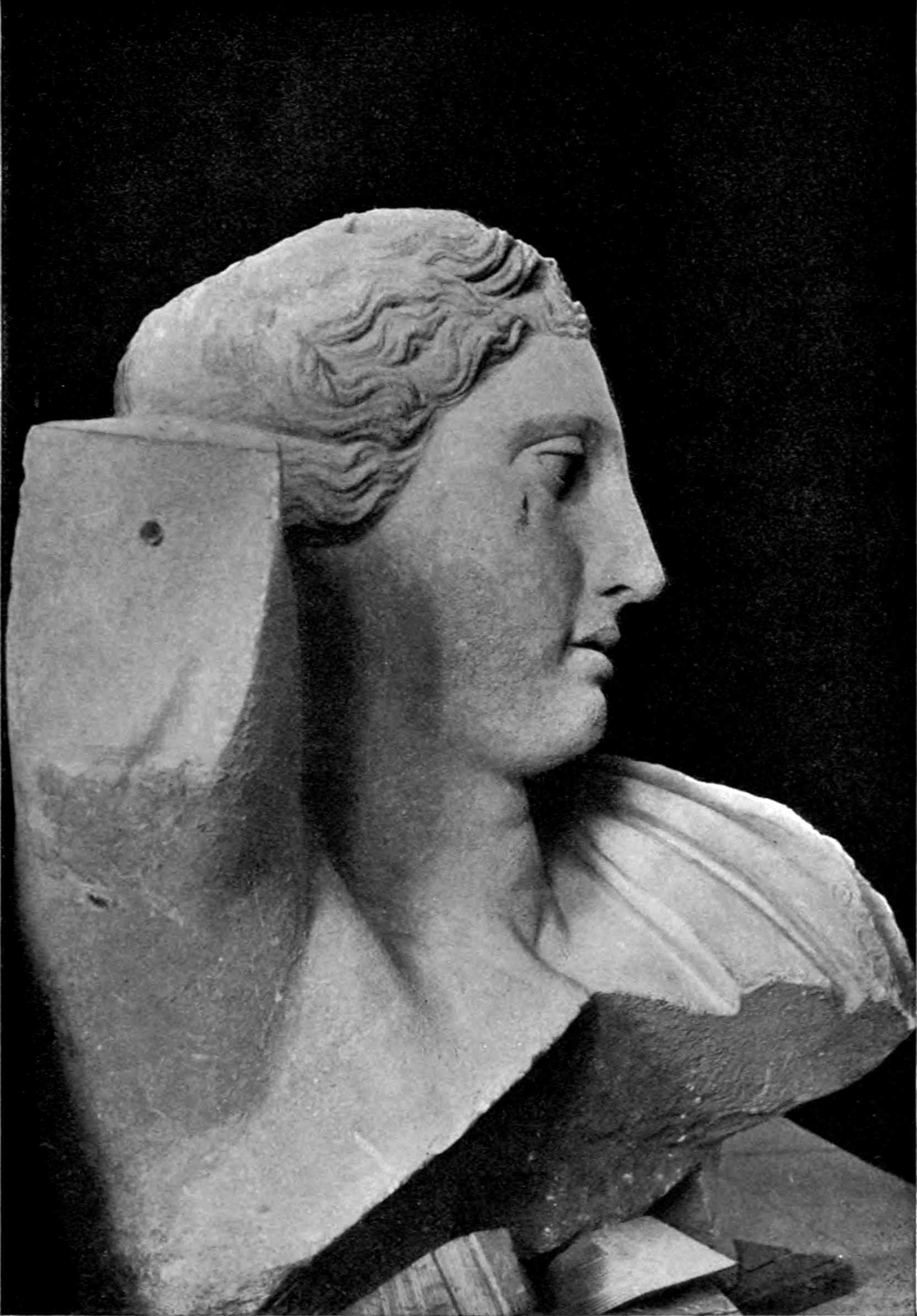

17
The figures of Pergamene art as a whole are short and stocky with squarish deep heads. They correspond to the Scopaic, pre-Lysippic, and Peloponnesian type, but the Lysippic improvements in pose and swing of the body are thoroughly appreciated and adopted. From Praxiteles are derived the female type and the interest in the satyr as a vehicle of sculptural expression. The athletic art of Lysippos and the school of Sikyon is practically unrepresented at Pergamon or in those regions of Ionia and Bithynia which are connected with it and at which we must now glance.
From Priene we have remains of a gigantomachy and some other sculpture.33 The influence of Praxiteles is marked, and the work as a whole is clearly under Pergamene guidance. From Magnesia we have remains of a great Amazonomachy belonging to the frieze of the temple of Artemis Leucophryene and dating from the end of the third century. The work is dull and careless but strongly under the influence of Pergamon. We shall in fact find no more architectural reliefs of even tolerable quality. The new landscape or pictorial reliefs occupied the attention of the sculptors, and temple decoration was left entirely to workmen.
One of the great Hellenistic art centres is Tralles, whose treasures are mainly to be seen in the Constantinople museum. The colossal Apollo or Dionysos (Fig. 9) is closely connected in pose and treatment with the Apollo of the Marsyas group, and shows even more clearly than the torso in the Uffizi the influence of Praxiteles. The cloaked ephebe of Tralles (Fig. 10) is a good example of the eclecticism of the age. The leaning attitude with the crossed legs reminds us of the satyrs of Praxiteles and his school, but the head is quite18 different and is strongly reminiscent of Myron. Boethos of Chalcedon belongs by birth to the northern or Pergamene sphere of influence, but he worked in Rhodes and will be more suitably considered in connexion with Rhodian art. Pergamene influence was also strong in the islands and on the mainland. We shall see that the school of Melos and both Attic and Peloponnesian art during the late third and second centuries were obviously affected by it.
19
It may well be questioned whether we are really in a position to separate the Hellenistic schools as definitely and surely as we can separate the Attic and Peloponnesian schools of the fifth and fourth centuries or the earlier local schools of the sixth. In the Hellenistic age we find a far greater uniformity and cosmopolitanism in art than ever before. The conquests of Alexander had been in the long run Panhellenic, and outside the mainland at any rate the title Greek came at last to mean more than merely a man’s city or state. It has therefore been argued by some critics that we must not expect to find the same local distinctions in Hellenistic art. In a cosmopolitan world with easy communications local and separate developments were no longer possible. This position is plausible, and so far as the question of ideals or even types is concerned there is little to choose between the Hellenistic schools. The so-called Hellenistic reliefs are probably of very diverse origin; the Hellenistic love for genre scenes and for the grotesque appears to be universally indulged; the erotic groups of Pergamon were certainly equally popular in Alexandria; the influence of painting and the adaptation of earlier sculptural types are found in all parts of the Aegean world. But there does seem to be a distinction in technical execution between the three great schools of the period, which is sufficient to justify their consideration in three separate20 chapters. While Pergamon is predominantly subject to the Scopaic-Praxitelean mixed tradition with an especial fondness for extremely clear-cut work and soft finish, Rhodes appears to be equally faithful to the Lysippic athletic tradition, and Alexandria to a strongly impressionist development of Praxitelean ideas joined to a fondness for unsparing realism in the grotesque, a combination not infrequent in the decadence of art. For Alexandrian art, more than any of the others, deserves the title of decadent through its abandonment of every vestige of idealism in motive.
We know the connexion of Alexandria with Athens was close in the late fourth century, especially during the rule of Demetrios of Phaleron in its closing decades. It was at this time that Bryaxis made the Sarapis (Fig. 12), which has perhaps survived for us in the innumerable copies of a wild-haired, heavily bearded head with shadowed mysterious eyes. During the next century Macedonia was the chief foe of Athens and of the Ptolemies, and all the earlier Egyptian rulers were on close terms of friendship with the city. Thus a predominant influence of Athens and of the greatest of the fourth-century Athenian sculptors, Praxiteles, is only what we should anticipate in Alexandrian art. It has, however, been argued that we have no evidence for a native art of Alexandria at all.34 While importing much late Attic sculpture, she borrowed also from Pergamon works like the Gaul’s head at Cairo,35 and from Antioch a group like the Dresden Aphrodite with the Triton.36 She was in fact a collecting rather than an originating centre.


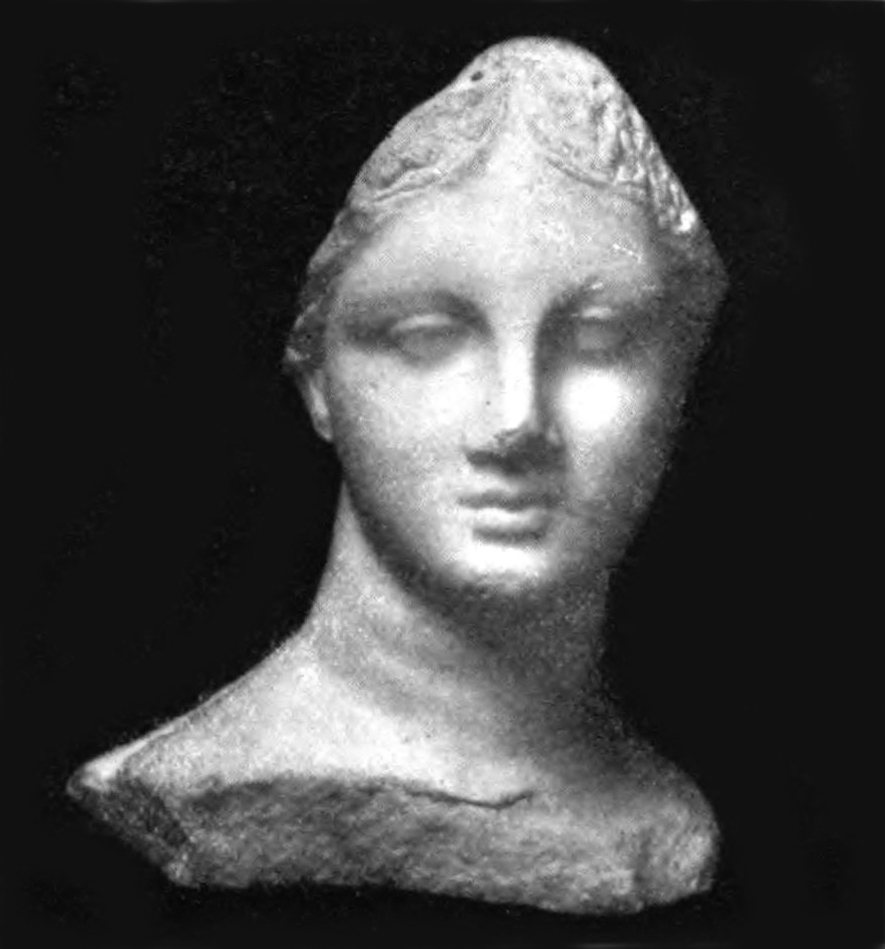
21 This view is improbable on many grounds. The Egyptians were a people with a keen artistic sense, and the sudden introduction of a new race like the Greeks with their passion for cultural expression could hardly fail to give an impetus to artistic output. Moreover, a great revival in architecture is noticeable all over Egypt. The Ptolemaic age is one of the great building periods of the Nile valley. Further, our authorities are unanimous on the importance and brilliance of the Alexandrian school of painting, and we know that in gem-cutting Pyrgoteles started a development never surpassed in antiquity or modern times. In literature, in criticism, and in science the museum of Alexandria held the chief place, and it is impossible to suppose that Egypt remained a mere collector of sculpture without any original development of her own. We must, therefore, examine the artistic products of Hellenistic Egypt to see if they exhibit any technical peculiarities marking them off from other Hellenistic centres and compelling us to credit them with a local origin.
Any study of the sculpture of Alexandrian origin reveals one characteristic almost invariably present in serious work, as opposed to the grotesque, and absent from the certified products of other centres. This is that quality of slurring over all sharp detail in the features and producing a highly polished, almost liquidly transparent surface for which we have borrowed the Italian term morbidezza.37 Instances of this highly impressionist treatment are to be found in the British Museum head of Alexander from Alexandria, and also in the Sieglin head from the same place; in the Triton head of the Dresden Alexandrian group of Triton and Aphrodite; in the many Anadyomene copies which are22 mostly connected with Alexandria, such for instance as the beautiful statue recently found in Cyrenaica (Fig. 11); in girls’ heads from Alexandria in Copenhagen and Dresden. In most of these works and in many others the soft transparent quality of the face is matched by a quite rough impressionist blocking-out of the hair. Thus we find both the characteristics of Praxitelean impressionism, the rough hair and the soft liquid gaze, exaggerated and intensified in Alexandrian sculpture. While the female hair of Pergamene art is invariably clear-cut and rope-like, Alexandrian hair is normally of the rough crinkly Praxitelean type, sometimes merely formal, at others more complicated and complete. This impressionist character of Alexandrian sculpture is borne out by what we know of its painting, and is doubtless due to some extent to the great influence of painting on sculpture as well as to the influence of Praxiteles.
Another technical point about Alexandrian sculpture is connected with the local conditions of the country. Egypt is not a country of marble, and therefore the artists had to be economical in the use of it. This is probably the reason why so many Alexandrian heads have the faces complete in marble but the hair added separately in stucco, where the colouring would render the difference in material hardly noticeable. Thus many statues of Alexandrian origin have large pieces of the upper part of their heads smoothed away and left for the addition of stucco. This phenomenon is not confined to Alexandrian art, though it is much commoner at Alexandria than elsewhere, and where we find it in combination with the other qualities of impressionism and morbidezza already noticed we may feel fairly confident in claiming an Alexandrian origin for the work in question.
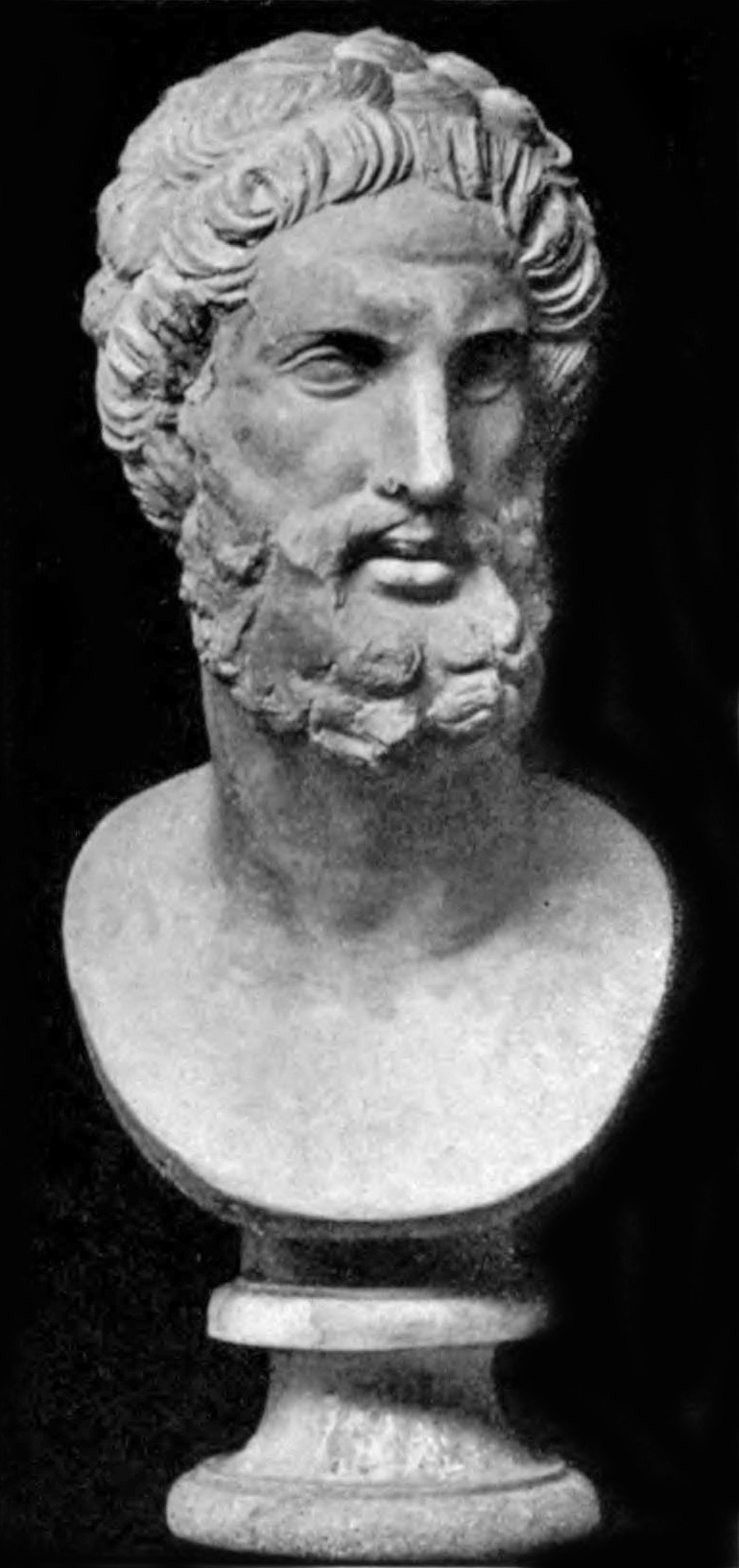
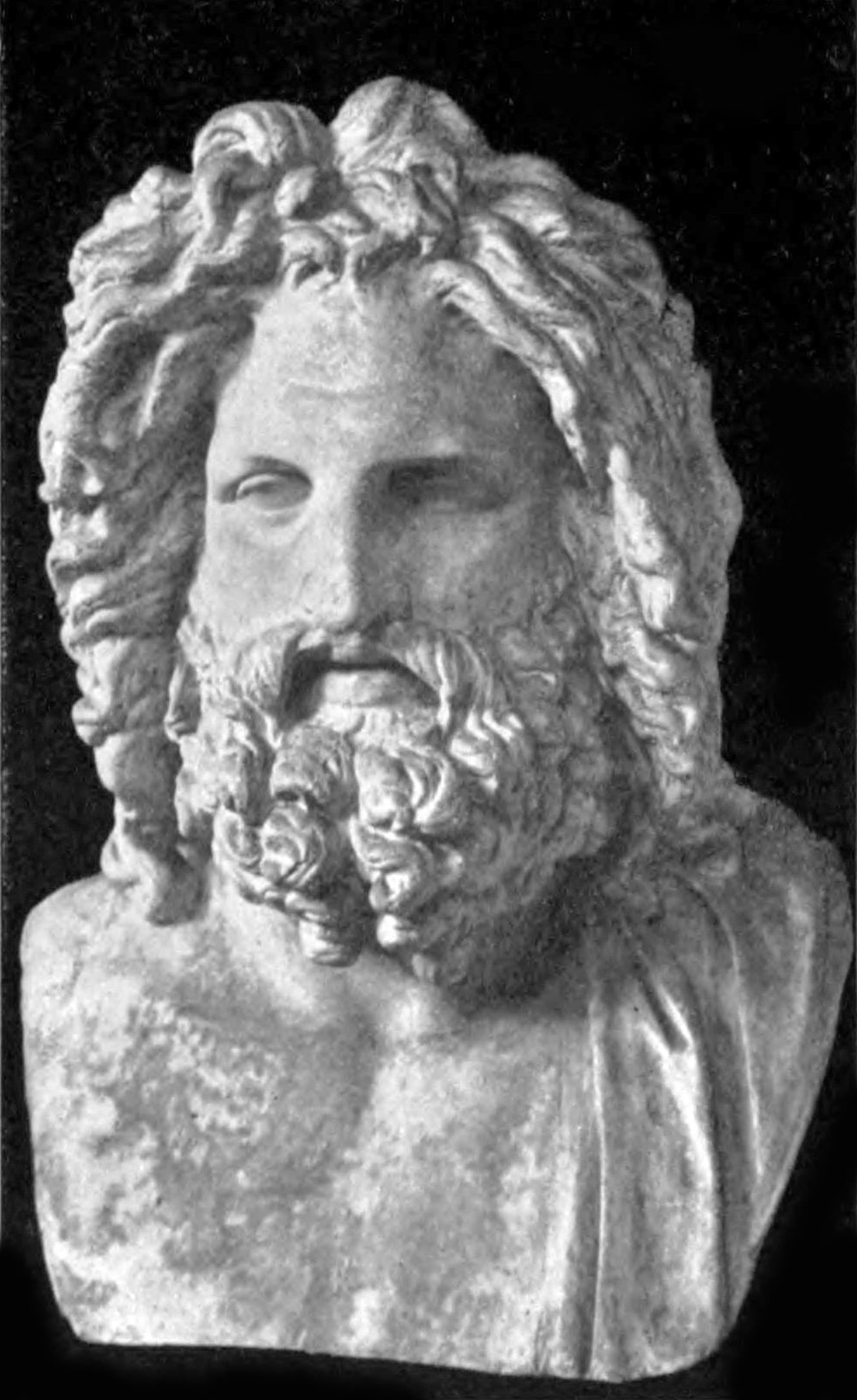
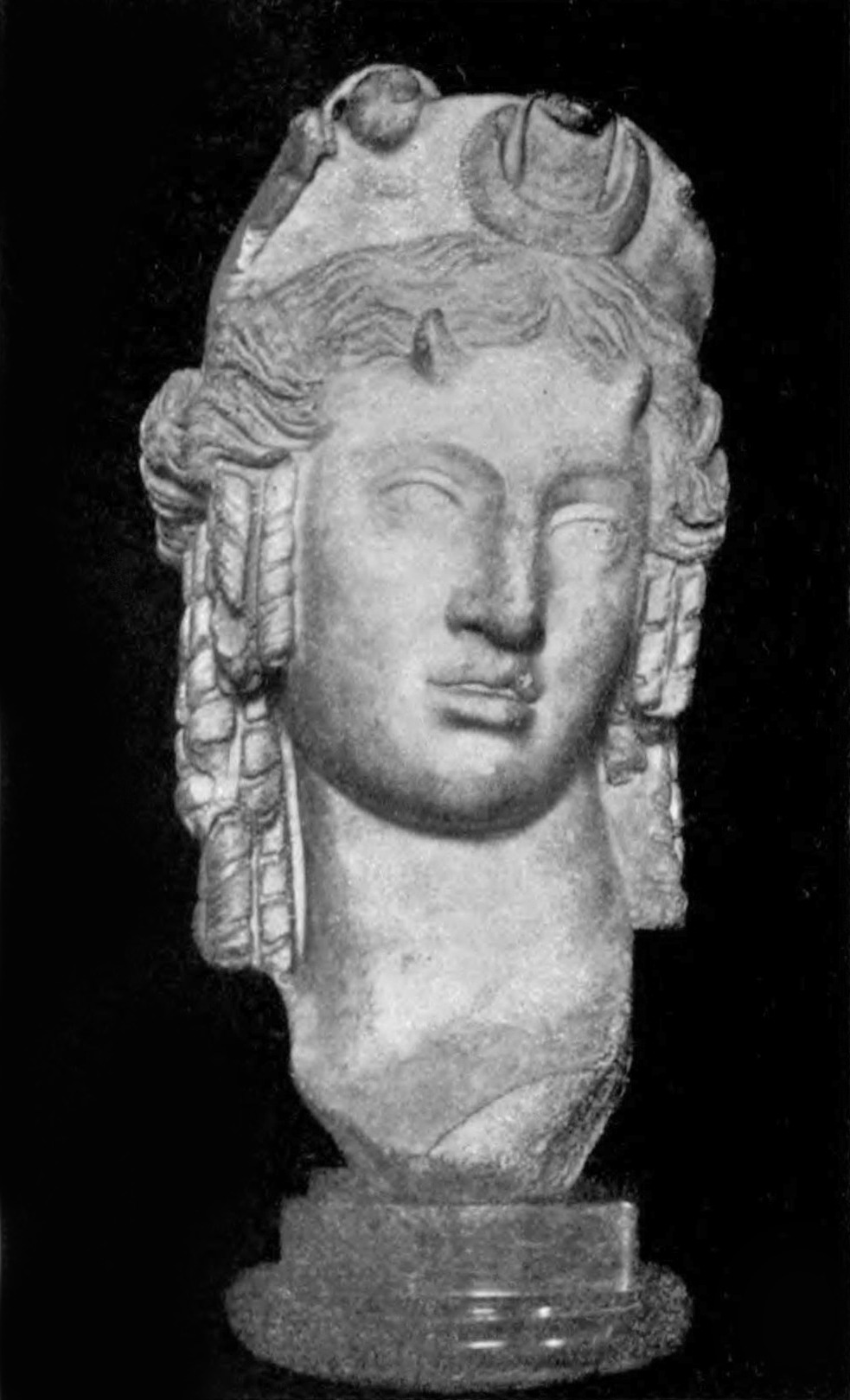
23
This theory is admirably illustrated in the beautiful little head of a girl from Chios recently acquired by the Boston Museum (Fig. 13). The head shows us an extreme degree of morbidezza in the softening of all the sharper facial lines such as eyelids and lips. The face is seen almost through a slight haze, and it thus gets some of the impression conveyed by distance. Where the head is worked it is quite rough and formal in purely impressionist style, but most of the hair was to be added in stucco, as the sharp cuts on the upper part of the head demonstrate. The head has been attributed too enthusiastically to Praxiteles himself. It is good work, but it is not by the author of the Hermes. The too mechanical smile and the too formal cheeks show a less masterly touch. But it is a perfect embodiment of Alexandrian art about 300 B.C. and must be unhesitatingly attributed to its real origin. We see a general copy of the Praxitelean long face with eyes about the centre of the head, Praxitelean proportions, and Praxitelean head-type.
Another head of Alexandrian origin is the fine bearded head of the Capitol Museum (Fig. 14), which is really almost a mask with the whole of the top and sides of the head left for stucco additions. The rough blocking of the beard shows the artist’s impressionist leanings. The long face is purely Attic, though perhaps closer to Bryaxis or some later artist than to Praxiteles. The head is more or less akin to the Sarapis head and to the other much finer bearded head which stands in close relation to the Sarapis, the well-known Zeus of Otricoli (Fig. 15). In the Otricoli head we have a similar prominence of the cheek-bones, a similar narrowing of the forehead above the frontal sinus—Attic features but not Praxitelean. The Otricoli Zeus is also a marble24 work cut for stucco additions, some of which are still visible, and we should probably recognize in it another work of early Alexandrian origin. It is perhaps not too daring to see the prototype of these Attic-shaped non-Praxitelean Alexandrian bearded heads in the Sarapis of Bryaxis.38 Bryaxis or some other late Attic artist seems to have affected the bearded male type of Alexandria much as Praxiteles influenced the feminine ideal. Nottingham Castle contains a bearded head from Nemi,39 which belongs to the same class of work. Here again we have the hair added in stucco and a general resemblance to the Otricoli type.
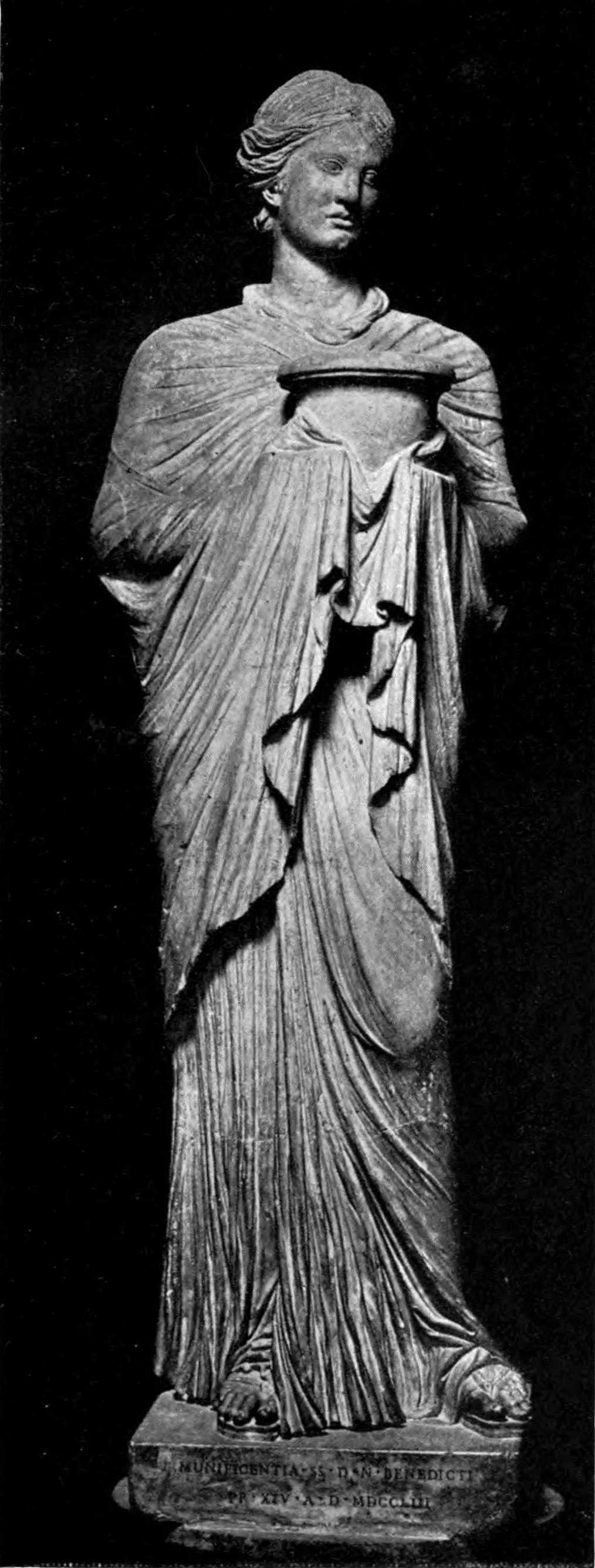
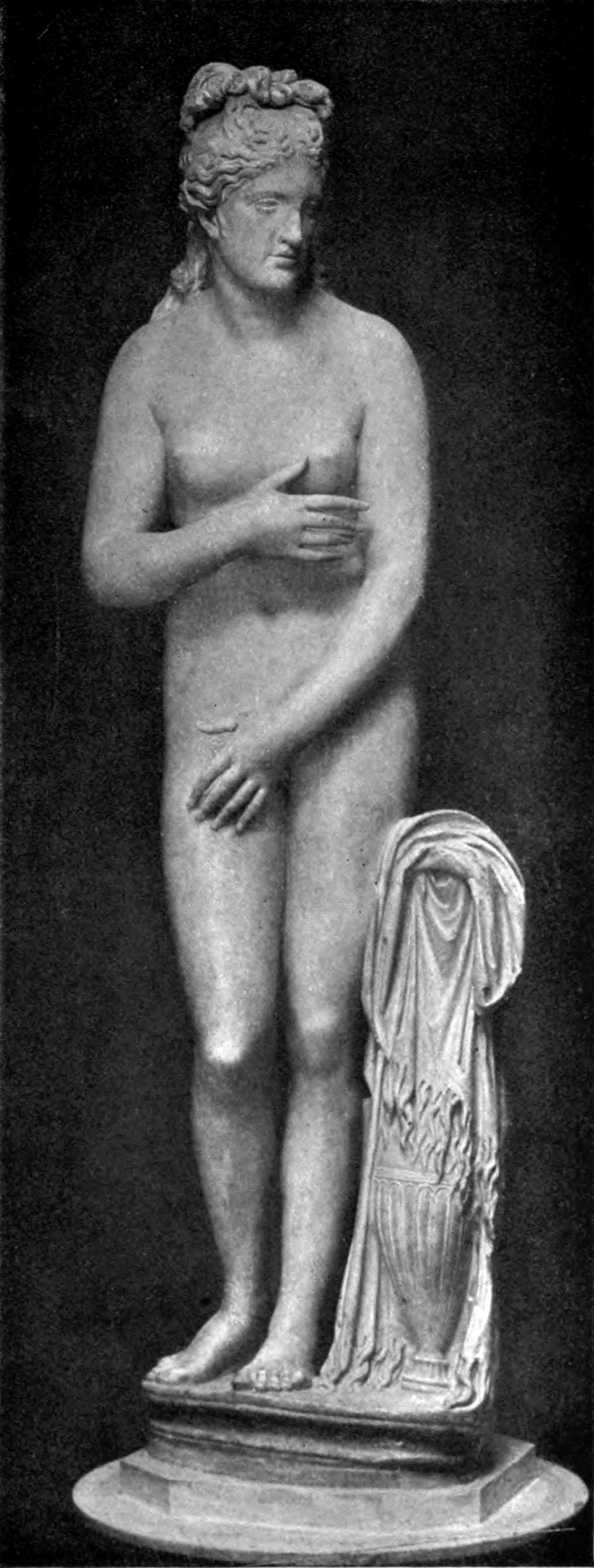
One of the new Greco-Alexandrian types was naturally the goddess Isis. A head in the Louvre (Fig. 16) gives us a version of this figure, which still, even in a poor Roman copy, shows us something of the languid elegance of the original. There is no traceable influence of Scopas in Alexandrian art. The Praxitelean and Attic tradition was transferred pure, and therefore the liveliness of movement and action in Pergamene art is quite absent from the art of Alexandria. Statues are mainly small, partly perhaps for economy, and partly from the lack of all desire for comparison with the gigantic masterpieces of ancient Egypt, and they are limited to simple standing or seated poses. An interesting statue of obvious Alexandrian origin is the priest of Isis in the Capitol (Fig. 17), which has been wrongly restored with a female head. This head is itself Alexandrian, as its hair demonstrates, but it has no connexion with the body, which is male, though draped in a light clinging tunic.40 The tunic25 is interesting as giving us a good example of Alexandrian drapery. We may notice the very small closely set folds, and the extreme realistic care with which the loose parts of the drapery are distinguished from those tightly stretched. There is an element of artificiality no doubt in the way in which the folds radiate from the great jar carried against the chest and in their close symmetry of design, but as a whole the effect of texture is marvellously well secured. We have here a good example of the naturalism which now plays a large part in Alexandrian art.
Another statue which we must claim for Alexandrian art is the Capitoline Venus (Fig. 18), an extremely interesting statue not only as a first-rate original but from its relation to the Cnidian goddess of Praxiteles. The face and the hair show the usual qualities of Alexandrian impressionism; the fringed mantle thrown over the water-pot is the mantle of the Egyptian Isis, and the foreshortening of the foot of the amphora is just the pictorial touch we expect in Alexandrian art. But the most interesting light which this statue throws on Alexandrian art is its directness and want of subtlety in motive. The goddess of Cnidos is naked, but she is only half-conscious of her nakedness. Her eyes are fixed on eternity, and the actual bath is a mere accessory like the child of the Hermes. But the Capitoline goddess is not thinking of eternity at all. She is stepping into her bath, and is suddenly aware of a spectator’s gaze. She is the classical counterpart of Susannah in Renaissance art. All the vague beauty of the Attic statue is lost by the touch of Alexandrian realism, which amounts almost to vulgarity. As to the treatment of the body it is again real and not ideal. The back in particular shows a close study of the model26 without any of the selective idealism of classical art. Like the beautiful torso in Syracuse41 it is a marvellous study from nature, not marked by any vestige of idealism.
Another head in the Capitol, the so-called Ariadne (Fig. 19), perhaps really a Dionysos, also suggests an Alexandrian origin with its long face, eyes close together, and crinkly hair.42 It is a very favourite Roman head often copied, and must belong to some famous original. It wears a band, which presses into the hair, and its sleepy languid gaze is remarkable. This is produced by making the upper eyelid nearly straight and the lower one well curved. The face is long and heavy. Both eye-shape and head recall the Boston girl from Chios and other Alexandrian statues. The surface of the face is highly polished, the hair left crinkly and rough—an Alexandrian procedure. If we can accept this head, we must class with it two heads of identical facial type, the Eubouleus of Eleusis43 sometimes attributed to Praxiteles, and the so-called Inopos from Delos in the Louvre (Fig. 20). Alexandrian dedications might plausibly be expected at Delos and Eleusis. Both Inopos and Eubouleus are highly impressionist. We have said enough to show that what we may call the serious art of Alexandria had certain characteristics of technique and execution, which render not impossible an attempt to classify and arrange an Alexandrian school of sculpture. We must now turn to another side of Alexandrian art which, if of less artistic interest, is nevertheless of paramount importance in our study of Hellenistic art.
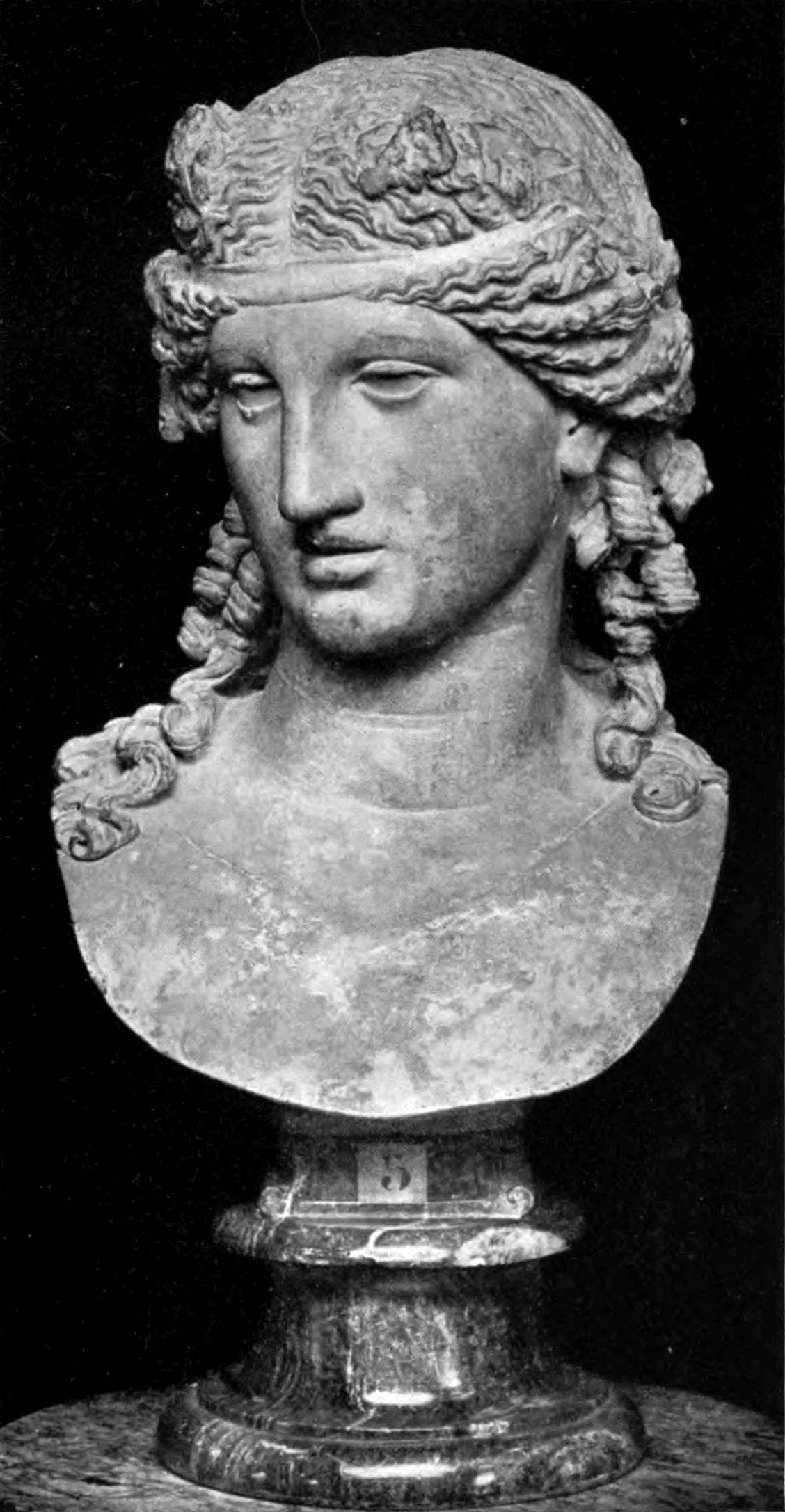
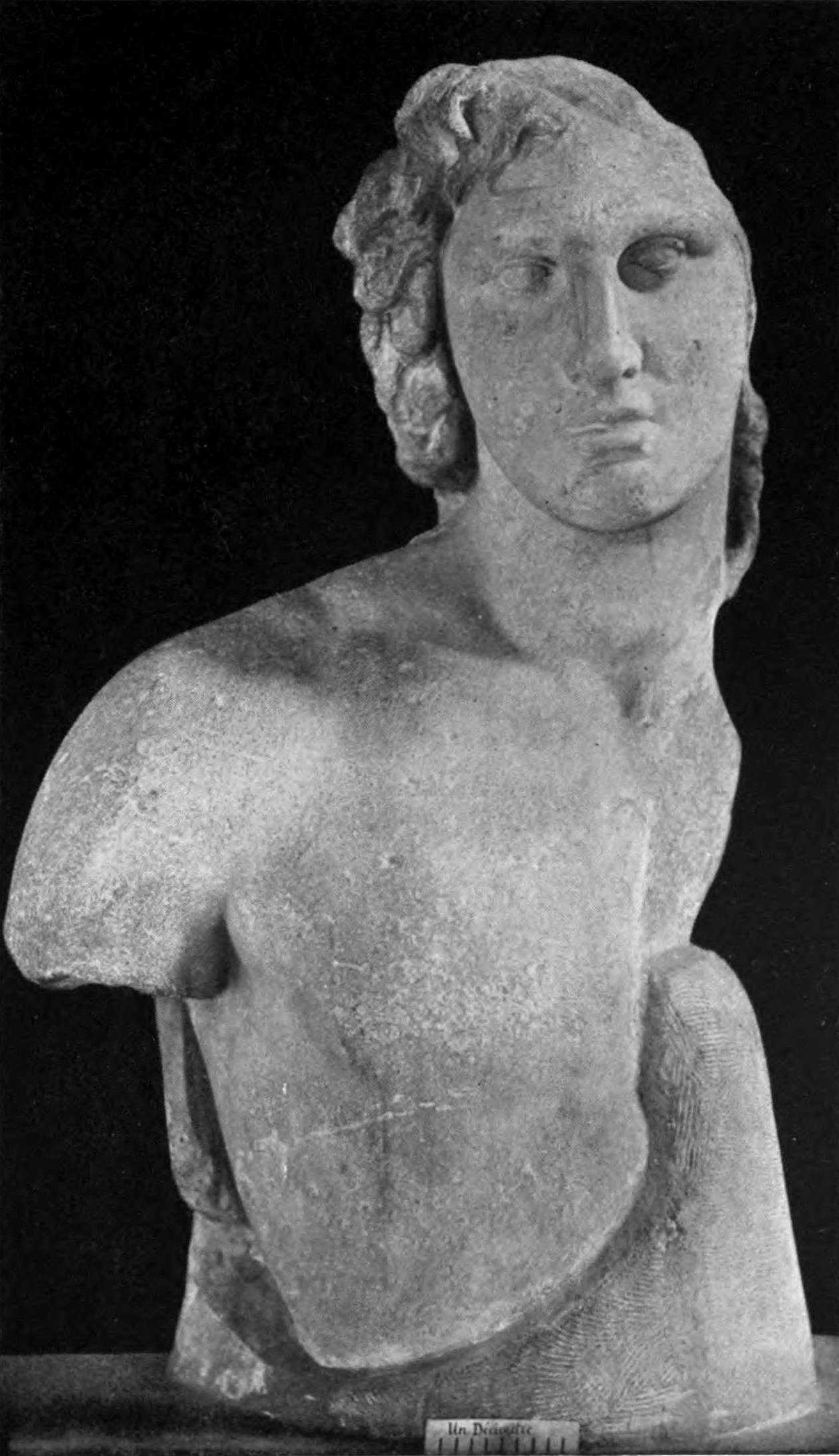
27
The people of Alexandria were noted in the ancient world as scoffers and cynics. Their temper was fiery, their jests were brutal, and reverence of any kind was unknown to them. A cosmopolitan medley of Greek, Macedonian, native Egyptian, Jew, and every nation of the East, they were united only in their utter diversity of point of view and their scepticism of all ideal obligation. To such a people caricature and a love of the grotesque were almost second nature. By the side of the greater art of Alexandria it is easy to discern a lesser art of comic, grotesque, and obscene statuettes of every description. Greek realism in portraiture went back to the Pellichos of Demetrios with his great paunch and scanty hair in the early fourth century.44 With the end of the century the satyr was a recognized medium for every variety of the baroque and the macabre in expression. But in Alexandria above all the grotesque exaggeration of natural defects found its true popularity. The negro, the hunchback, the drunkard, the crétin of every kind, became popular artistic models. As if the delineation of youth and beauty was exhausted, the Hellenistic sculptors of Alexandria rushed into the portrayal of disease, of old age, and of mutilation in every form. They suffered as much as any modern decadent from ‘la nostalgie de la boue’. Here again we must beware of attributing to Alexandria all the grotesque figures of Hellenistic art and all its pieces of most painful naturalism. Pergamon, if not Rhodes, and doubtless Antioch must have played their part in the commonest form of artistic decadence; but we have so much of this work certified as Alexandrian, that we are justified in regarding Egypt as its chief and most popular home. Works of this type fall into two classes:28 the purely grotesque and the extremely naturalistic. The former class is more or less confined to statuettes, of which a number are collected in Perdrizet’s Bronzes grecs d’Egypte de la Collection Fouquet, and the account of the Mahdia ship in Monuments Piot for 1909 and 1910. These include gnomes, pygmies, dwarfs (Fig. 21), and little obscene figures of all kinds. Needless to say, Praxitelean qualities of morbidezza and impressionism have no place in art of this kind. We may presume that the demand was primarily foreign and not Greek, though all the skill of Greek sculpture is employed in the faultless execution of many of them. Their Alexandrian origin is better attested than that of the second class of extremely naturalistic works.
The latter are more important and more interesting. They include some of the most skilful works of sculpture ever achieved. The splendid negro’s head of Berlin45 and the fisherman of the Louvre are of undoubted Alexandrian origin, but such works as the fisherman and the peasant woman of the Conservatori46 or the old women of the Capitol and of Dresden are not so clear in their origin. When we get a statue of this type, combined with some clearly Alexandrian quality, such as the so-called Diogenes of the Villa Albani47—a naked beggar carried out with fine realism but also with considerable morbidezza and impressionism—we may claim an Alexandrian origin; but impressionism is rare among such statues, as the artists seem to love to dwell on every detail. We may, however, regard them as a single class irrespective of their individual origin. The Louvre29 fisherman48 deserves careful study for its absolutely unsparing truth to nature. The slackness of skin caused by long wading in water, the swelling of the veins through hard work, the feebleness and hollowness of chest due to old age or disease, the coarse peasant’s head, in which each wrinkle is faithfully delineated, deserve our wonder if not our admiration. The little companion pair in the Conservatori, though inferior in workmanship as Roman copies, are also full of interest for their vitality and truth. Finest of all perhaps is the splendid old woman’s head in Dresden (Fig. 22), with its marvellous mimicry of the ravages of age. Such art is decadent, because it is pessimistic, cynical, and unhappy, and because it refuses to select and idealize as it might do even in studies of decay; but of its brilliant execution there can be no doubt. Only the Chinese have made grotesques which can rank with the products of Alexandria.
This is a convenient place for dealing with the great series of Hellenistic reliefs, though it is no longer possible to maintain that these have a uniform and common origin either in Alexandria or in Imperial Rome.49 We have seen their beginning in the Telephos frieze, the first to show us a pictorial background and an episodic mythological treatment. The appearance of the relief panel as a self-sufficient whole without architectural background is an invention of the Hellenistic age as early as the third century B.C., but it continues as an artistic force right through Roman into mediaeval and modern art. Certainly not even the Hellenistic reliefs have a common origin, but it is not impossible that Alexandria was the home of one class of them, the30 pre-eminently pastoral scenes like the Grimani reliefs in Vienna (Fig. 23). Alexandria was the greatest city of the Hellenistic world and the farthest from any conception of the pastoral life of the country. It is, therefore, possible that the rise of the pastoral tendency in art was connected with the Alexandrian craving for novelty and variety in a sphere of which it knew nothing. It is certain that the pastoral poems of Theocritos delighted the citizens of Alexandria, and the Hellenistic pastoral relief is strictly analogous to the poems of Theocritos. It shows a countryside of the Watteau type with satyrs and nymphs to correspond to the shepherds and shepherdesses of the court of Louis XIV. It is an artificial country without a touch of the reality of nature. Thus the pastoral reliefs and the poems of Theocritos represent the one element of idealism in the materialistic culture of Alexandria.
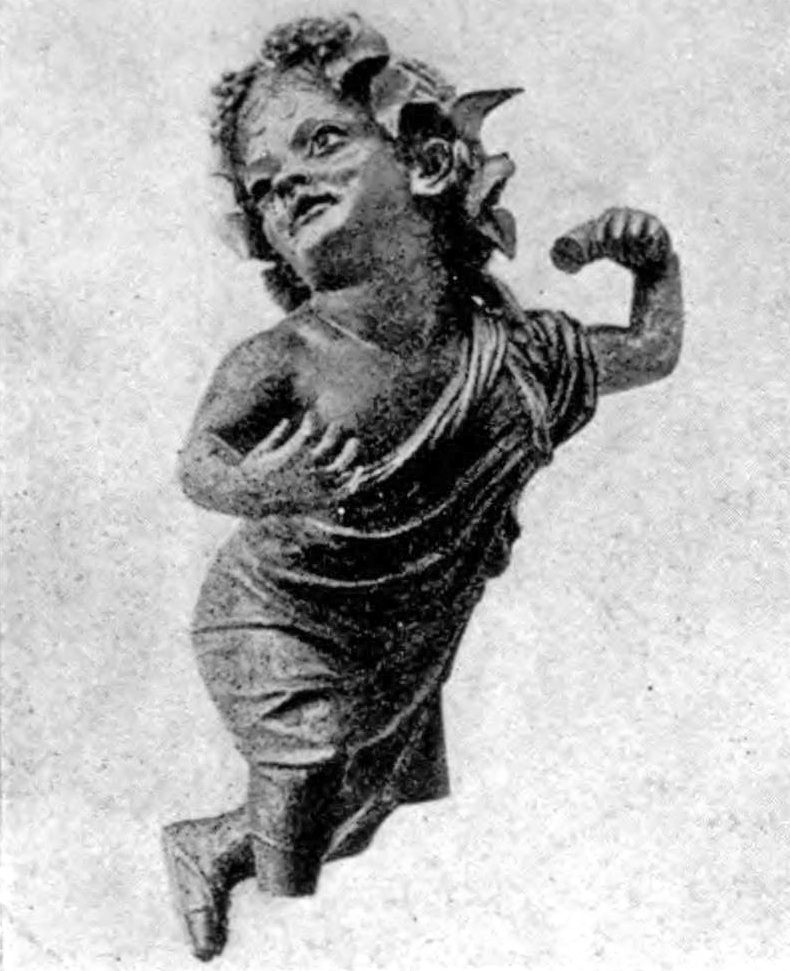
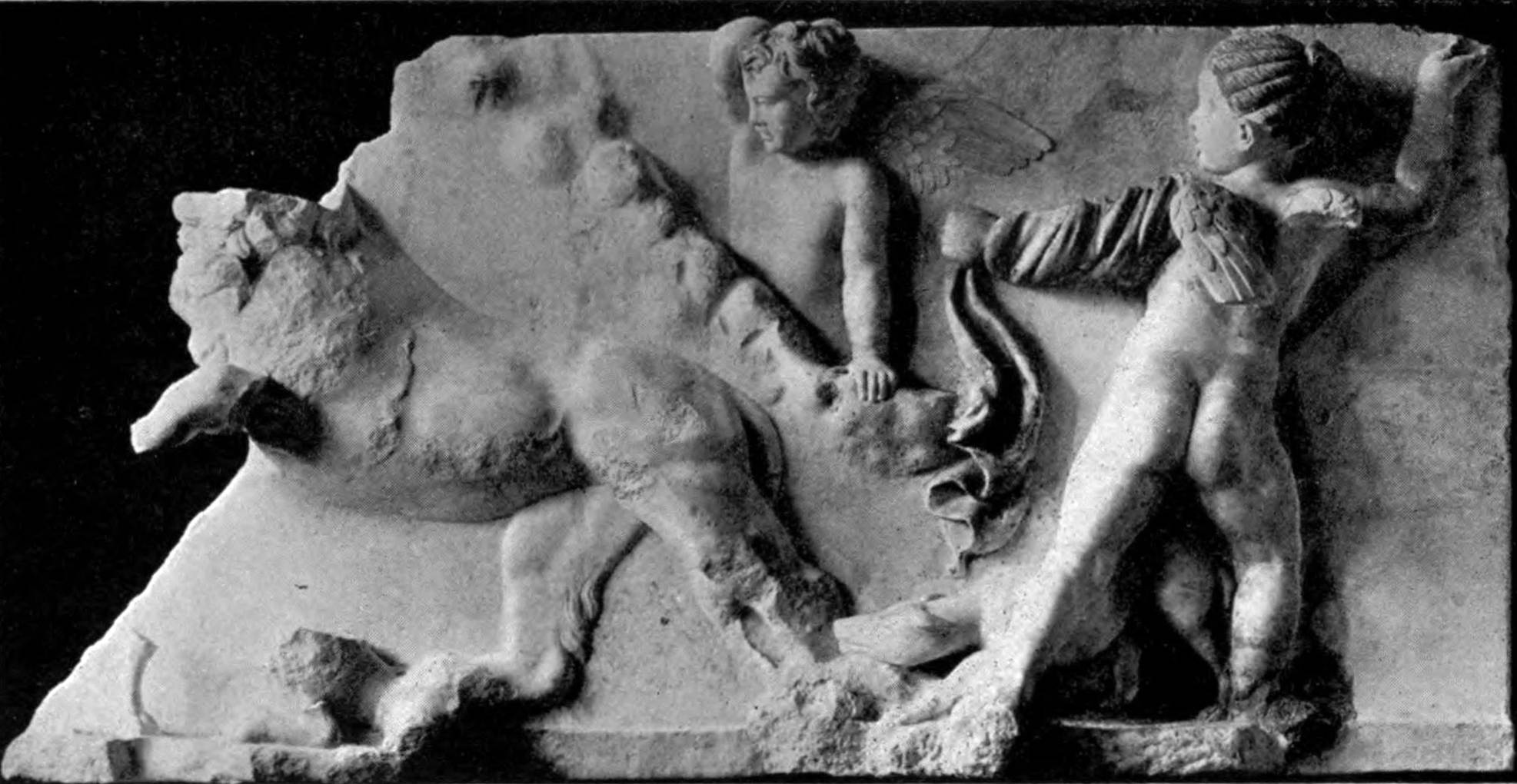
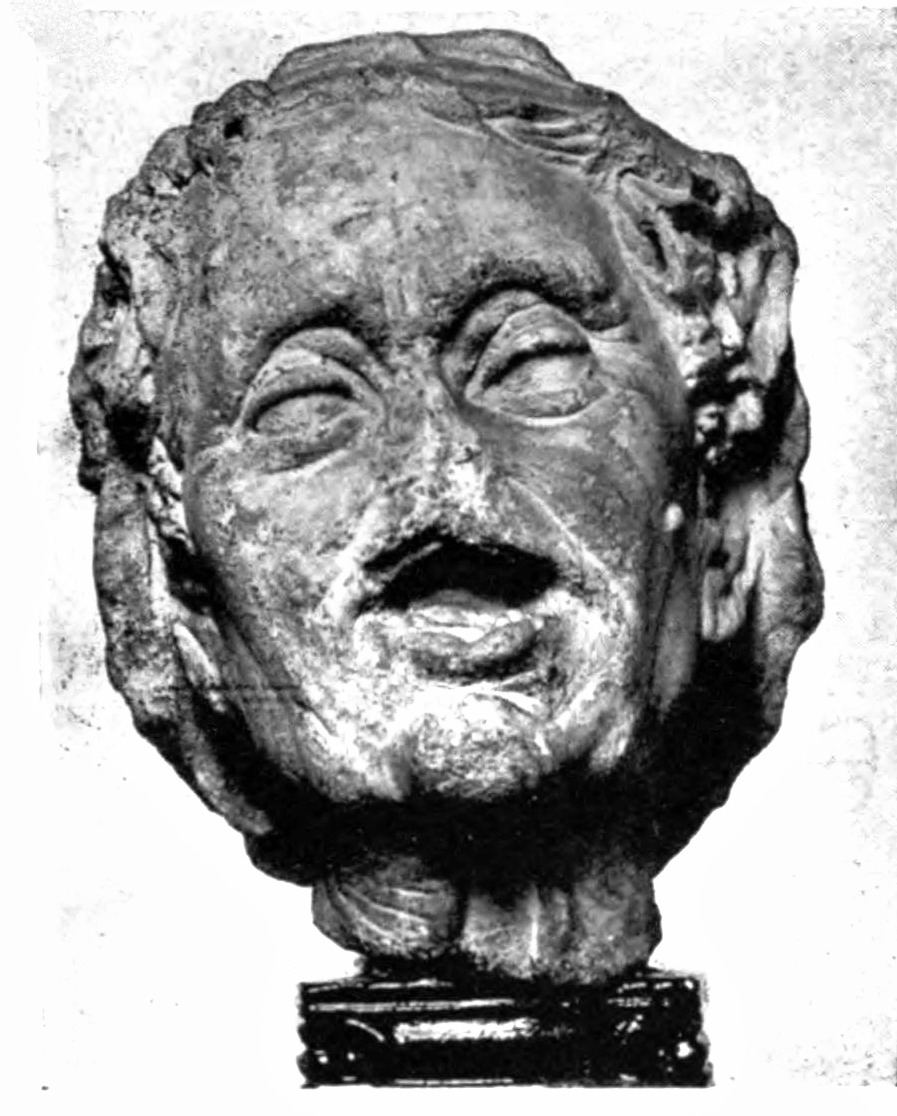
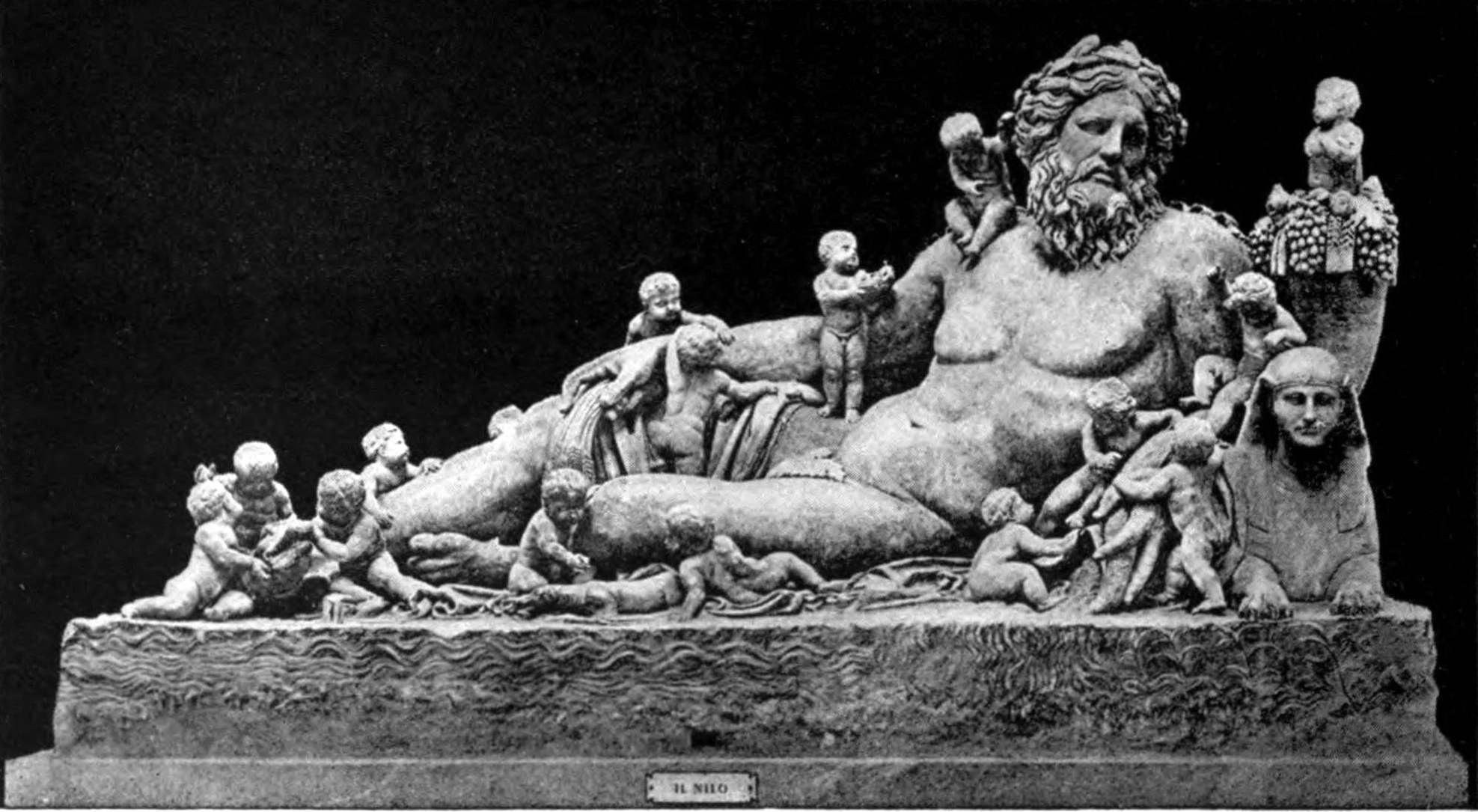
The Hellenistic reliefs may be divided into three classes: the pastoral reliefs such as the scenes showing sheep and a lioness and cubs, called the Grimani reliefs, in Vienna; mythological reliefs like the Bellerophon and Pegasus of the Palazzo Spada,50 or Perseus and Andromeda of the Capitol51 in Rome; and more complicated little scenes or groups like the Menander relief of the Lateran,52 the Apotheosis of Homer,53 the slaying of the Niobids,54 or the visit of Dionysos to a dramatic poet.55 They are all closely related to painting—how closely a reference to Pompeian wall-paintings or mosaics like the famous Praenestine pavement will show—but there are some differences between the groups which are31 worthy of mention. The pastoral scenes are straightforward and naturalistic. The little group of a countryman driving a cow past a ruined temple in Munich is a good example of straightforward naturalism. The mythological reliefs are usually distinctly affected in style. The gesture with which Perseus receives Andromeda is like that of an exquisite handing a lady from her carriage. Bellerophon waters his horse with a nonchalant air.56 Daedalos and Icaros57 present a curious mixture of affectation and realism. But it may now be regarded as certain that the Spada reliefs are Augustan in date at the earliest, and the affectation may well be imported. This is, indeed, partially demonstrated by a comparison of the two copies of the Daedalos-Icaros group in the Villa Albani, of which one is Roman, the other probably late Hellenistic. At the same time it is remarkable that the figures of the mythological reliefs all show the long slender proportions of Lysippos. This at once suggests a Rhodian connexion. Mythological groups are favourites in Rhodes, and it is the one place where the Lysippic tradition certainly lasted. It is not a wholly hazardous suggestion to propose a Rhodian origin for the mythological, and an Alexandrian origin for the pastoral, reliefs. One might be tempted, therefore, to ascribe the most intimate and domestic scenes to Pergamon, but there is insufficient evidence for proof at present, though the reliefs deserve careful study with these possible divisions in mind.
In general we can only point out their fine naturalism and perfect execution. Their artists seem to have mastered all the problems of perspective and to deal with the third dimension as easily as with the other two. It is natural to32 notice some advance in freedom of style. The earlier reliefs, like the Telephos frieze, or the Dolon relief,58 are in less pronounced relief and with less carefully conceived perspective. Later reliefs like the so-called Menander relief show some of the figures in part detached from the background, while the perspective of a group is most subtly graded. We may compare the finest of them with the bronze doors of the Florentine Baptistery and their marvellous panels.
We are still left with one important monument of Alexandrian art which perhaps can be treated most fitly in connexion with the pastoral reliefs—the great statue of the Nile in the Braccio Nuovo of the Vatican (Fig. 24). The god lies out at length supported on his elbow, and little boys, representing the cubits of his annual rise, play about over him. The work is a Roman copy, and tells us little of technique, but the putti are interesting as a typical Hellenistic development. This is the period in which Eros, who has been growing steadily younger from the youth of Praxiteles to the boy of Lysippos, turns finally into the chubby Roman Cupid or Amorino of Renaissance art. As such he helps Aphrodite in her toilet or performs all manner of tasks in the fine frieze of Erotes at Ephesos. It is the logical ending of the transformation of mythology into genre. Alexandrian art is essentially mundane and frivolous, sceptical and humorous. Her artists would have appreciated the earlier Pergamene developments, but they would have laughed at the clumsy idealism of the great altar frieze. Nor would they have felt much sympathy with the athletic art of Rhodes.
We may perhaps consider here the little we know of the art of Antioch, since it has certain points in common with33 that of Alexandria. The chief monument used in all discussion of Antiochene art is the statue of Antioch59 on the Orontes, made by Eutychides, a pupil of Lysippos. A small copy of this in the Vatican shows us a fine seated figure crowned with the turreted crown, who rests her foot on a little male figure with outstretched arms representing the stream of the Orontes. Unfortunately the copy is too small to give us much information about the artist, though he seems to have used the same idea for another statue of the Eurotas. We have, however, a figure of Aphrodite from Egypt (Fig. 25), which shows a supporting Triton in an attitude indubitably connected with the figure of the Orontes. This is an Egyptian work, but it argues some artistic connexion between Alexandria and the Seleucid capital. Another link is given us by the statement60 that the Apollo at Daphne near Antioch was made by Bryaxis, the author of the Alexandrian Sarapis.
Antioch, though like Alexandria in many respects—in her turbulent population, her cosmopolitanism, her irreverence for all authority—seems never to have developed the cultured love of literature and the arts which we find at Pergamon and on the Nile. She remained in all probability a collector and not an originator of art. The glimpses which we can get of her statues indicate a catholic taste. The Apollo seated on the Omphalos, which decorates the Seleucid coins, resembles the Lysippic type, and a Herakles type, also found on Syrian coins and reproduced in the bronze colossus of the Conservatori, has some connexion with the later Sikyonian school. By the side of these we must place the Apollo of Bryaxis.
34
Ephesos, a strong place more or less at the meeting-point of three empires, has left us considerable remains of Hellenistic art. Her bronze athlete at Vienna (Fig. 26) belongs to a later development of the Scopaic school; her frieze of Erotes61 is more in the Alexandrian manner. Some beautiful bronzes, in particular a Herakles attacking a centaur,62 are in the mixed Lysippo-Scopaic manner. There are also traces of Praxitelean influence in her art.
These cosmopolitan collecting centres cannot tell us much of the methods of Hellenistic art. Our best resource is to examine more closely the works of certified origin. Ephesos is, however, important for its school of copyists. The marble copies of the Attalid dedications were perhaps made here, and Agasias, the author of the Borghese Fighter,63 was an Ephesian by birth, although a Rhodian by education.
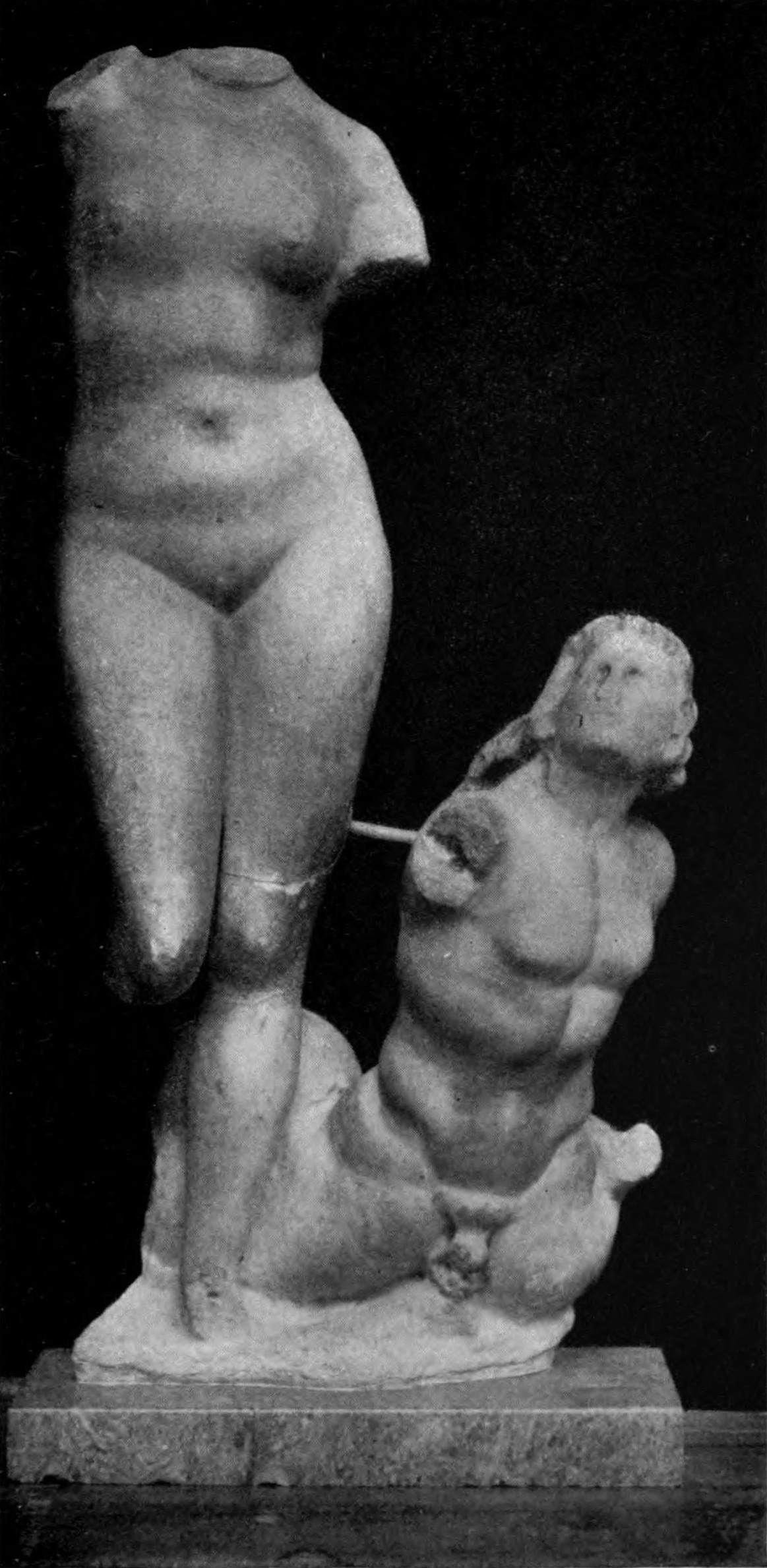

35
The school of Rhodes stands on a different footing from that of Pergamon or Alexandria. The latter were new foundations, or at least new societies, in which the Greek element was associated with much that was alien and exotic. The orgiastic wildness of Phrygia went far to influence the art of Pergamon, whether in its earlier sensuality or its later pageantry of exaggerated triumph. In Alexandria and in Antioch non-Greek races imported into Hellenic art the cynicism and the world-weariness of older and exhausted civilizations. But Rhodes was pure Greek and a living, growing, prosperous community without recollections of humiliation and defeat. Rhodes as a city had been born of the union of Lindos, Kameiros, and Ialysos at the end of the fifth century. The fourth century brought slow growth, but the successful defence against Demetrios Poliorcetes in its last decade opened a new chapter in Rhodian history. Henceforward Rhodes was mistress of an empire. She acquired possessions on the mainland; her fleet rode and controlled her neighbouring seas; her trade stretched out tentacles in all directions; and among the semi-barbarous Hellenistic kingdoms she alone carried proudly the torch of undefiled Hellenic tradition. Chares of Lindos, a pupil of Lysippos, headed the long roll of her sculptors; her painter, Protogenes, had but one rival in the Sikyonian Apelles. Thus from the first she boasted great artists,36 closely connected too with the school of Sikyon. Her Dorian sympathies naturally isolated her from the Attic school and from the mixed Praxitelean-Scopaic school of the Ionian mainland. Her Peloponnesian and Sikyonian connexions identified her at once with athletic art and with the school of Lysippos. Thus while Alexandria and Pergamon patronized marble sculpture, Rhodes now becomes the home of bronze casting. Her vast Colossus was matched by at least one hundred more statues of remarkable size, and the roll of her artists as recorded in inscriptions is noteworthy for its length. The great siege gave that impulse of idealism which is necessary for the growth of any artistic development, and the traditional friendship with the rising power of Rome helped her to preserve her prosperity and independence later than any of her neighbours. The last great work of Rhodian art, the Laocoon, is almost as late as the Empire, and the whole period of two hundred and fifty years between it and the Colossus is marked by an immense output of sculpture.
We have already suggested that the Hellenistic art of Rhodes began under the dominant influence of the athletic school of Lysippos. We must first examine the character and achievements of this school. Daippos, Boedas, and Euthykrates are said to have been sons and pupils of the great Sikyonian. Of these Euthykrates was the best known, and Pliny tells us that he followed his father’s carefulness rather than his elegance, and that his style was more severe than genial (‘constantiam potius imitatus patris quam elegantiam austero maluit genere quam iucundo placere’).64 His works were mainly athletic or equestrian, with a few female37 subjects, and his pupil Tisicrates was a faithful copyist of the style of Lysippos, so much so, in fact, that his works could hardly be distinguished from the master’s. Daippos made a perixyomenos or athlete scraping himself,65 and Boedas made an adorans or praying figure.66
Pliny’s description is important, because it assures us of the faithfulness with which the pupils of Lysippos kept to their master’s style. This is the basis for the argument of those who see in the Apoxyomenos of the Vatican a work of the pupil Daippos rather than the master; but the argument is two-edged, if Lysippos’ own style is to be found in the Agias, since the two statues have little in common. The mention of the adorans enables us to connect two well-known bronzes with this school—the Praying Boy of Berlin (Fig. 27) and the Resting Hermes of Naples (Fig. 28). The Praying Boy is a subject unparalleled elsewhere, and belongs to the early Hellenistic age. He can hardly be other than a copy of the statue of Boedas. The slender proportions and small head follow the Lysippic canon, and the easy swing of the body proves its chronological position. This figure and the others, which we shall subsequently notice, show a new growth of naturalism by less insistence on the outlines of the torso muscles. The average body in repose does not show the massive muscles of Pheidian or even of Lysippic art, and the post-Lysippic sculptors of the third century tend to soften and naturalize the torso to a considerable extent. The Pergamene Dying Gaul is a good example of this fine restraint, which was utterly abandoned by the later Pergamene school and even by the late Rhodians, but which in all third-century art of Rhodes is noteworthy. The38 Resting Hermes is a fine copy of a post-Lysippic original, which stood in close connexion with the Praying Boy. The torso, slender, restrained, and full of vitality, shows the same treatment, and must belong to the Lysippic school.
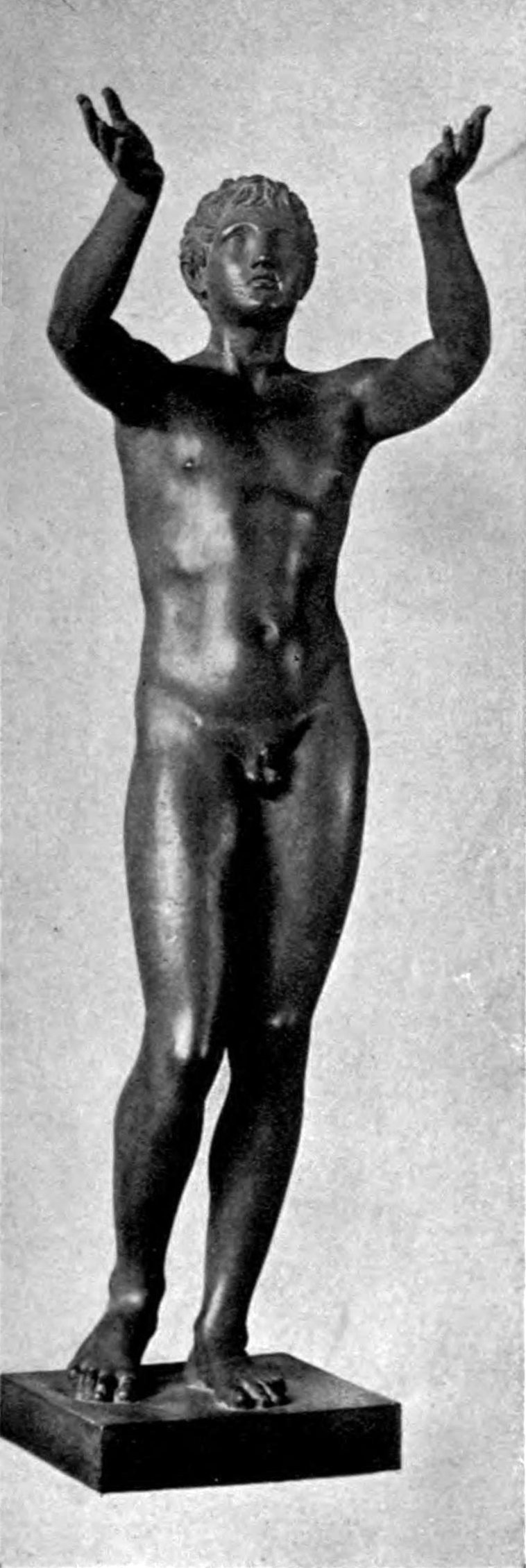
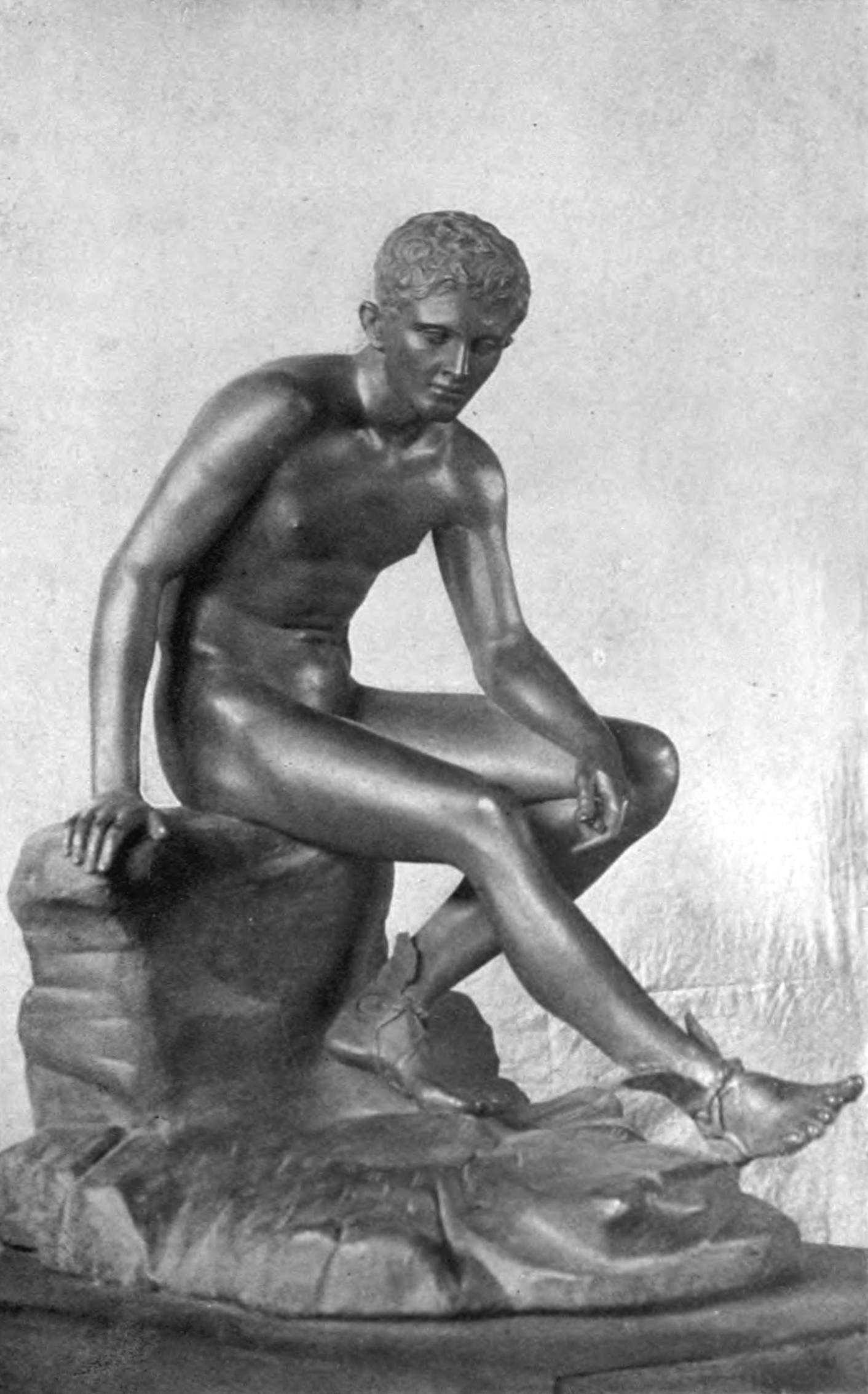
Eutychides of Sikyon, another pupil of Lysippos, is known to us only from his Antioch.67 This figure, even in its poor copy, is of great importance, since it is almost the only certified draped female figure of the Lysippic school. Our whole theory of Lysippic and early Rhodian drapery must, therefore, rest upon it. A comparison with the Herculaneum figure68 in Dresden will show at once a considerable resemblance in treatment, so much so, in fact, that it has caused the attribution of the Dresden figure to the Lysippic school. This cannot be allowed because of the greater resemblance to Attic grave-reliefs and the Mantinean basis, which demonstrates the origin of the type in the school of Praxiteles.69 But it is sufficient to show that the new scheme of the school of Praxiteles was adopted in the main by the pupils of Lysippos; their faithfulness to their teacher will incline us to the belief that Lysippos used it also. This type of drapery shows a tendency to an artificially effective or artistic arrangement rather than to complete simplicity of naturalism like the drapery of Praxiteles himself, but it is important to notice that it does not become purely artificial or stereotyped till much later, and that all the early examples preserve a considerable share of freer naturalism. The characteristic of the drapery is an opposition of folds in many differing directions, so as to counteract the uniformity of39 the older Pheidian type. The folds themselves are quite natural; it is only in their arrangement that we find the element of art.
The Antioch permits us to assume the tall figure swathed in a long thin cloak as the female type of the Lysippic school, and therefore of the early Rhodian school, while the Praying Boy and the Resting Hermes give us the male type. The close connexion postulated rests on the fact that Chares of Lindos, the author of Rhodes’ most famous statue, the great Colossus, was himself a member of the Sikyonian school and a pupil of the master. But the Colossus itself is unknown to us in any certain copy, and therefore we cannot speak with full knowledge of his art. Some statuettes in bronze in marked Lysippic style may well reproduce the statue, but we cannot feel the necessary certainty in their identification.
There is a group of athletic statues of the third century which carry out the Lysippic tradition to its logical conclusion, and which consequently we are practically bound to attribute to Rhodian artists. But until we have a definite copy of Chares’ work we must argue backwards to the first Rhodian school, of which we have no direct information, from the later Rhodian school, of which we know a great deal. The Laocoon70 and the Farnese Bull71 are certified works of Rhodian art of the first century B.C., and they show us a type of male figure which is quite distinct from the types of Pergamene and Alexandrian art. We are, therefore, entitled to argue back to the Rhodian school of the third century, and to attribute to it such athletic sculpture as is clearly of the earlier date while offering distinct technical40 and stylistic resemblances to the later groups. The male figures of this later period differ from the Pergamene works, with which they are most easily compared, in certain well-defined points. The heads are smaller and rounder and the hair is rougher and less carefully arranged. The eyebrows have a tendency to form sharp angles with the nose instead of the broad straight curves of the Pergamene brows. This makes the bridge of the nose thinner and usually substitutes vertical forehead wrinkles for the swelling frontal sinus of Pergamene work. Except in cases of great strain the torso muscles are treated with more restraint, but the veins receive more careful attention, especially on the abdomen. In the back a more broken-up system of muscles replaces the great upright rolls on either side of the backbone, which mark Pergamene work. Finally, the proportions are slighter and more Lysippic.
These considerations apply most powerfully to two great statues of the Louvre, whose third-century date is almost certain: the Borghese Warrior72 and the Jason (Fig. 30). The former statue is by Agasias of Ephesos, an artist whom we can date with some degree of certainty in the middle of the third century. The Jason comes so close to the Lysippic type of Poseidon on the one hand and to the Fighter of Agasias on the other, that the Lysippic-Rhodian origin of the two is fairly well established. The analogies of the Borghese Warrior with the Apoxyomenos have been often pointed out, but his resemblances to the Laocoon and the Farnese groups require an equal recognition. Both the Louvre statues show the influence of a later generation on the Lysippic type. While reproducing the general proportions,41 each develops Lysippic innovations to a further degree. Lysippos made a distinct advance in anatomical skill, but both these statues show a more exact scientific knowledge. While their torso muscles are less prominent, they reveal new details in abdomen, groin, and the inner side of the thighs, unknown to the earlier sculptor. They also develop much further the Lysippic substitution of an all-round figure for a merely frontal one. Each of them can be regarded effectively from any point of view, and neither has any real front. They, therefore, represent a distinct technical advance. But at the same time they show a decline in artistic feeling, for there is perhaps too much science about them. They belong to a school immensely interested in detail, and tending, therefore, to lose its grasp on the general treatment. The anatomical structure of the male form cannot be rendered more perfectly than in the statue of Agasias, so well known to all art students, but the statue affects us with a feeling of strain and discomfort from its want of unity and repose. All the athletic statues of the Rhodian school seem to be restless and unsatisfied. There is none of the calm repose about them that marked earlier Greek art. The desire to display newly acquired scientific knowledge invariably demands a strained and therefore disquieting motive. As we shall see when we come to examine the Laocoon later, the influence of the stage appears to be affecting sculpture. Poses are histrionic, and expression begins to depend upon grimaces and action rather than upon more subtle indications of feeling.
With the Borghese Fighter and the Jason we may class, perhaps, a work like the Actaeon torso in the Louvre,73 and42 also that much discussed and very beautiful work, the Subiaco Youth.74 This shows the same restraint in torso modelling which distinguished the Praying Boy and the Resting Hermes, but in the strain of its attitude it resembles rather the Fighter of Agasias, especially in the twist of the body above the waist, which Lysippos had originated and which his pupils tend to exaggerate. One of the disquieting features of the Borghese Fighter is that he implies the presence of another figure which is not there. He is a fighter without an opponent. The Subiaco Boy is in the same plight. His attitude can hardly be other than that of a suppliant touching chin and knee of his enemy in Greek fashion. His artistic defect is that he again is a suppliant without an enemy, part of a group without his counterpart. In their anxiety to study the human figure in all positions the Rhodian artists were apt to overlook the question of artistic unity.
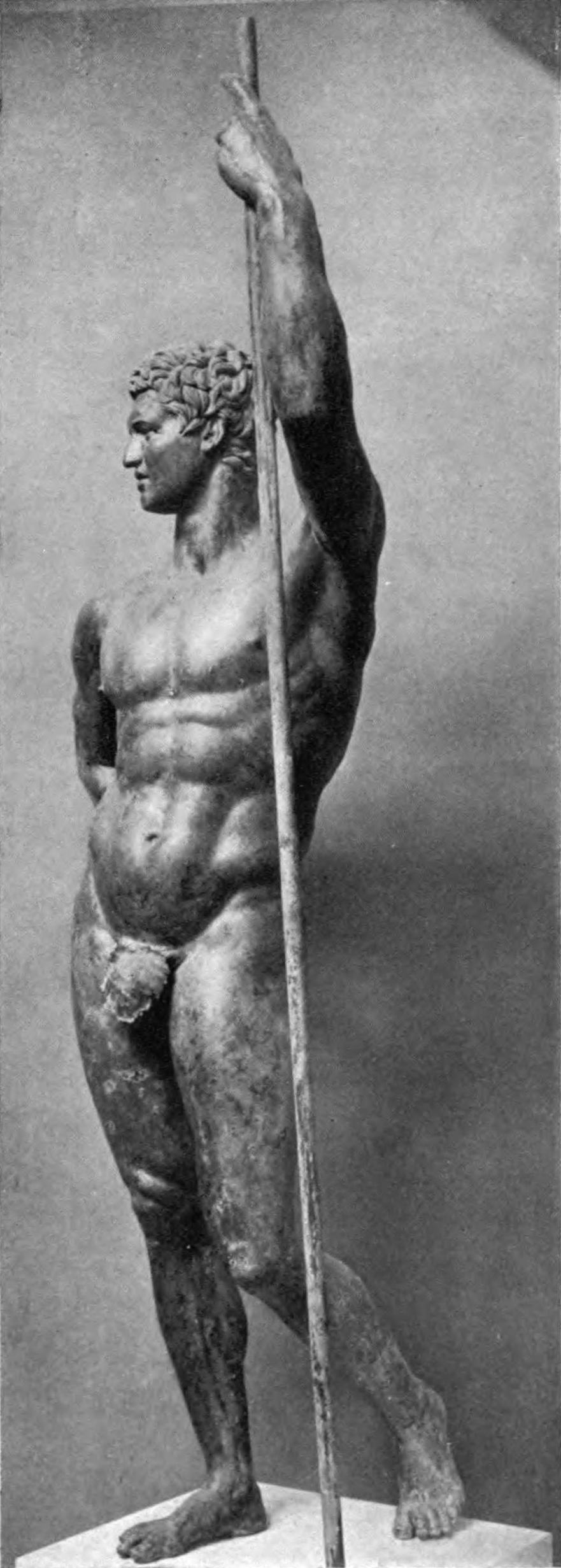
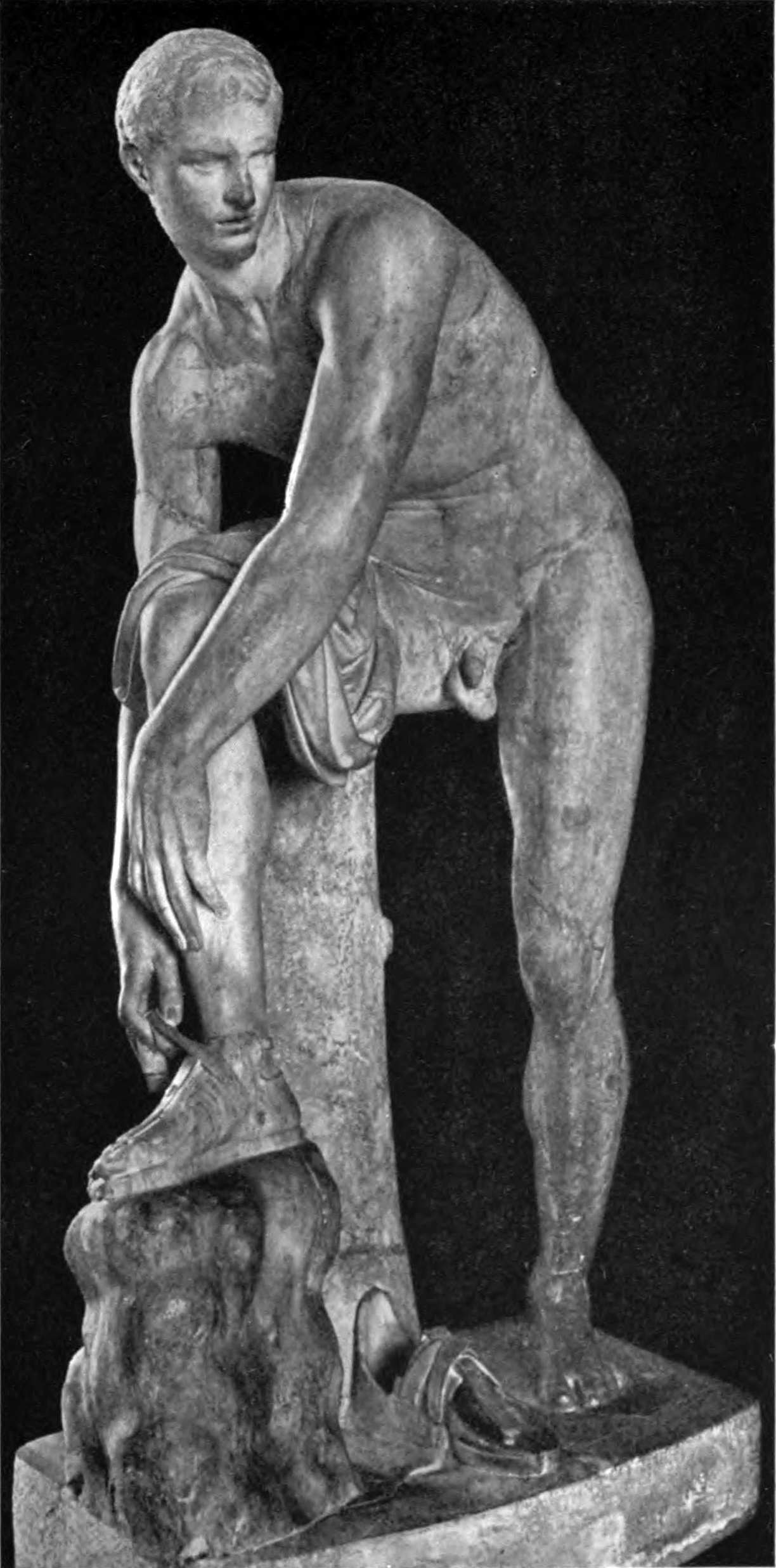
Two fine bronzes in the Terme Museum may be attributed with some certainty to Rhodian artists, in view of the Rhodian monopoly of Hellenistic bronze casting. Both are Greek originals—the seated boxer75 and the hero resting on a lance (Fig. 29). The latter is commonly called a portrait of some Hellenistic prince, but the absence of the royal tiara or any personal indications is significant rather of a heroic type. The face is strongly individual, but so is that of the Boxer, the Fighter of Agasias, and even the Jason. We have no reason to see a portrait in any of them, but personality is beginning to affect even ideal statues in the Hellenistic age. The hero with the lance is a fine, if rather histrionic, figure more or less following the Lysippic type of43 Alexander with the lance76 and showing a somewhat massive and emphatic rendering of a Lysippic type. He belongs to the later Rhodian school, into which exaggeration has crept, rather than to the more restrained art of the third century. The Boxer, on the other hand, brutal and coarse as his expression is, has no trace of muscular exaggeration, and is an earlier work. His broken nose, swollen ears, scarred face, and blood-bespattered hair show the unsparing realism of the artist. He is another instance of the all-round statue of the late Lysippic school, a masterpiece of technique, if a somewhat disagreeable work of art.
We can connect the names and the works of few of the earlier Rhodian artists, but Boethos of Chalcedon is now established as a worker in Rhodes,77 where he received the honour of προξενία. Pliny mentions his Boy Strangling a Goose,78 and the many copies of this statue in existence give us a good idea of its popularity. Boethos was apparently a silversmith and also a sculptor of boys. He was famous as a maker of elaborate couches, and we are possibly the possessors of such a couch in the fine bronze litter of the Conservatori Museum,79 on which are little boys’ heads strikingly similar to the Boy with the Goose. This group is often quoted as an example of the new feeling for genre or homely domestic detail in sculpture. It is, in fact, of great importance for its new recognition of the comic in art, and for the appearance of the fat chubby boy like the Erotes of Ephesos or the little statuettes of Alexandria. The small boy or girl now becomes a favourite subject of the sculptor,44 and we may compare closely with the Boy of Boethos the Eros and Psyche of the Capitol (Fig. 32), who are really a little boy and girl engaged in a children’s game.
We must now turn to another very important side of Rhodian art—the delineation of female drapery. The followers of Lysippos favoured an austere style, and the nude female figure has no place in Rhodian art. But while the other sculptors of the Hellenistic world were modifying and to some extent vulgarizing the beautiful conceptions of Scopas and Praxiteles, the Rhodians were attacking the draped female figure as they inherited it from Praxiteles and Lysippos, and producing modifications just as interesting and important as those connected with the athletic statue.
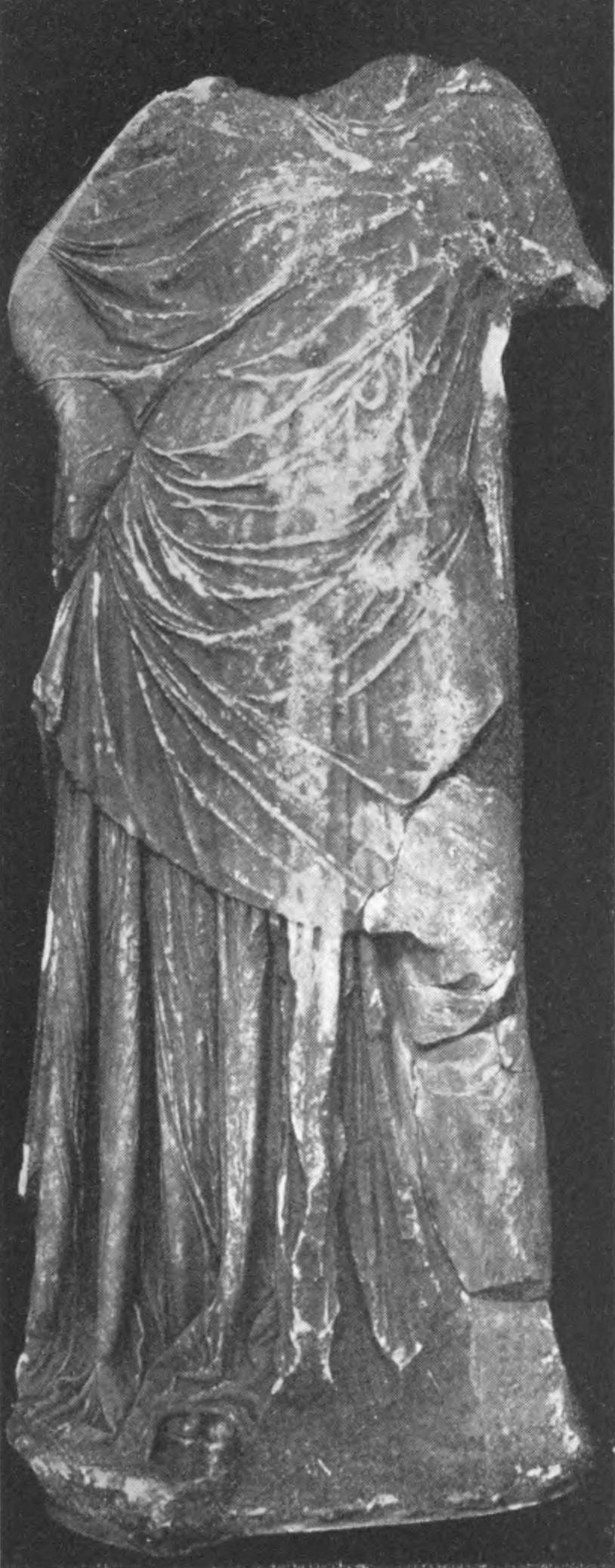


We know that Philiskos of Rhodes was the author of a group of Muses which was much admired in Rome. It has been suggested that the new type of female drapery which appears on an altar from Halicarnassos and on the relief of the Apotheosis of Homer by Archelaos of Priene, certainly a member of the Rhodian school, was his work.80 This new type of drapery is to be seen also in a number of statues of Muses, of which we have a collection from Miletos in the museum of Constantinople.81 It may be described most simply as an aggravation and exaggeration of the style of drapery introduced by the school of Praxiteles. The desire to get a series of folds at sharply contrasting angles leads to a very artificial arrangement of the dress, which produces an inharmonious effect. But there is a new development which deserves our attention. Transparent drapery had been elaborated by Alkamenes and the pupils of Pheidias,45 but always with the intention of displaying the body beneath it. The new drapery of the Muses is transparent with the desire to display other drapery beneath it. The earlier Greeks had used a thick mantle over a transparent chiton, but the Rhodian author of the new drapery used a transparent mantle over a clinging chiton. He thus doubles the subtlety of his technique, and provides himself with a series of new and intricate problems, just as the athletic sculptor does with his anatomical discoveries.
This transparent mantle immediately obtained an immense vogue, and it comes down into Roman art as a strong rival of the late Praxitelean drapery, which, however, still prevails by the side of the other. The greater number of Roman female draped statues use one or the other type of garments. The Milesian Muses are not in themselves great works of art. The real technical possibilities of the new drapery are better displayed by a wonderful figure from Magnesia in Constantinople (Fig. 31), in which the new fashion is rendered with consummate skill. It is of considerable importance that we should date this change in drapery as accurately as possible. The date hitherto proposed for its supposed author Philiskos has been put about 220 B.C. The Apotheosis of Homer is taken to be about 210 judging from a portrait of Ptolemy IV appearing in it, and the Halicarnassos base is put about the same time. But the portrait is by no means certainly that of Ptolemy IV. It is more like Ptolemy II, and might belong to any period. Philiskos himself has nothing to do with it. A female figure by him with a signed base has been discovered in Thasos (Fig. 33). The drapery of this female figure follows the type of the Mantinean basis,8246 and the earlier Muses group of the Vatican. The inscription is not earlier than the first century B.C. Philiskos, then, was a late artist who used the Praxitelean drapery. As for the transparent drapery, it is highly improbable that it was invented before the frieze of the great altar at Pergamon. We know that Rhodian artists worked on this altar, and Rhodian style is visible in some of the figures, but transparent drapery of the Rhodian type appears nowhere on the frieze. There seems to be no reason to date any figure wearing this drapery earlier than 190 B.C., and we should therefore attribute it to the second century. We have seen in the Antioch of Eutychides the Praxitelean type taken over by the earlier Rhodian artists in the third century. Have we any link by which we can connect the transparent mantle with the earlier form?
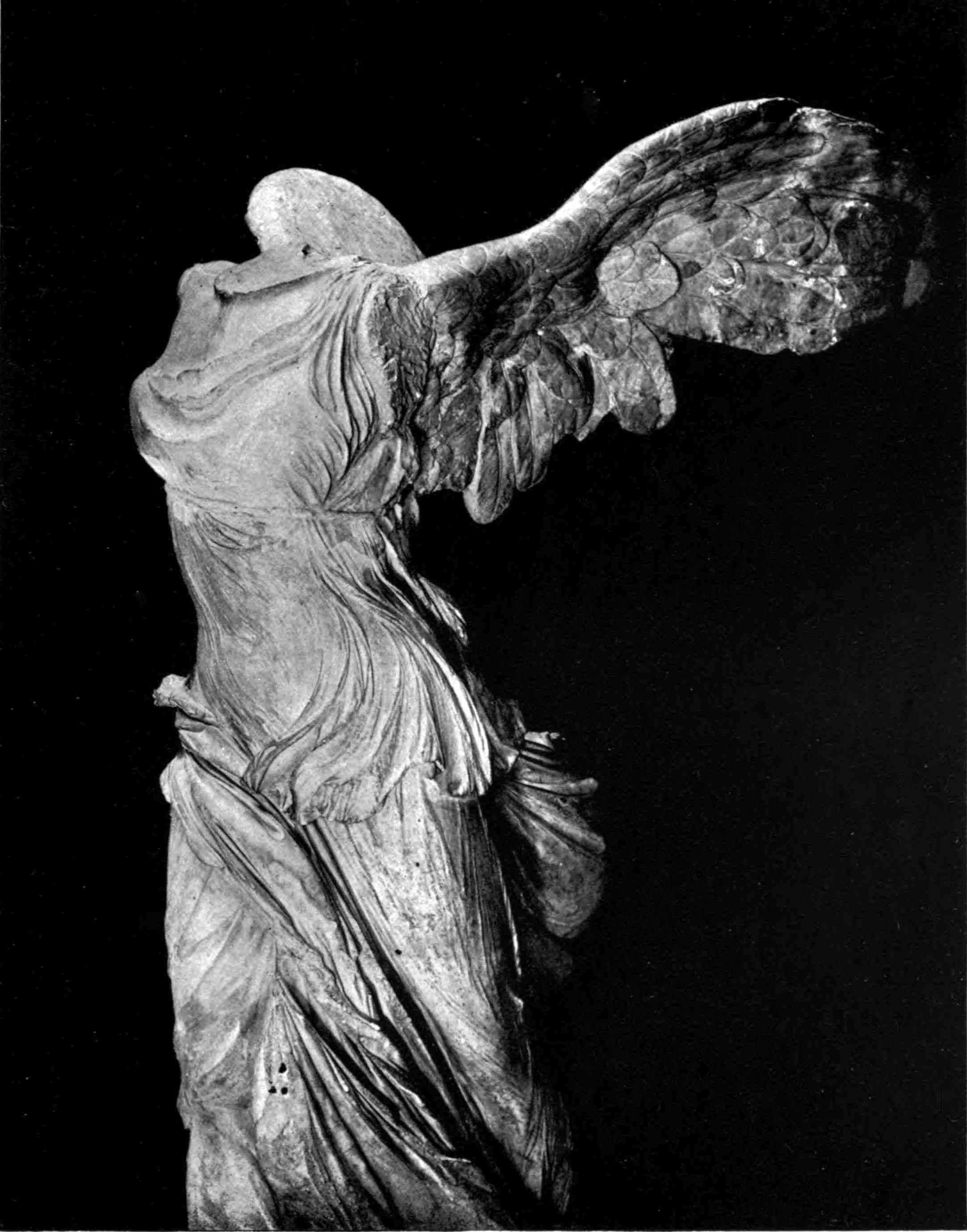
The answer to this question is provided by one of the greatest statues of antiquity, the Victory of Samothrace (Fig. 34). The date and school of this masterpiece are still warmly disputed, and the current view tends to connect it with the victory of Demetrios Poliorcetes in 306, by which he won the command of the sea. Coins of Demetrios show a trumpet-blowing Victory on the prow of a ship in an attitude closely resembling the Louvre statue. But the statue has no connexion with the coin, for a detailed study of the neck and fragments of the right shoulder reveals the impossibility of the trumpet-blowing attitude. The right hand and arm are raised high and backwards probably with a victor’s wreath. Moreover, the coin has a low girdle and no cloak, the statue the high third-century girdle and a great flapping mantle. The type is not so rare as might be expected. We have it in small bronzes, and we have it47 also in situ on a votive statue in Rhodes. The Victory of Samothrace is a later version of the statue possibly erected by Demetrios. Its Rhodian origin depends partly on the extraordinary finesse and delicate naturalism of its drapery, a study never popular in Pergamon, and partly on the strong probability, not yet decisively proved, that the marble of its base is Rhodian. The latter point may provide definite proof, but the former is the one on which we must at present rely. The Rhodian origin or at least the Lysippic connexions of the statue are further supported by the twist above the waist so universal among the followers of that artist and the strong vital momentary pose, which is wrongly rendered in the present attitude of the statue. It is not a standing figure, but a Victory who is just alighting after flight, and it should therefore be tilted farther forward. The only statue now existing which presents a real parallel to the intricate folds of the Victory’s drapery is the Magnesian statue already mentioned,83 which belongs to the new Rhodian drapery school. But the mantle of the Victory is older in type. Thus the Victory’s drapery stands midway between the Antioch figure and the new Rhodian fashion. It shows just that scientific naturalism which we have noticed in the anatomy of the athletic figures, and just that tendency to miss the perfect whole by an over-anxious care for detail. The date for such work is 250 and not 300 B.C. The Chiaramonti Niobid84 is a work of similar tendency though of a different school, and must fall about the same date.
We now possess some evidence for the continuous study and development of female drapery at Rhodes parallel to the study and development of the male form. The Rhodian48 school is in fact the most industrious and the most scientific of all the Hellenistic art centres. In mastery of detail they are unapproachable, but they have ceased to care much for motive or idealism in their subjects. To such art both impressionism and romantic feeling are foreign. Rhodian art is very versatile and very straightforward, but its constant aspiration after the unusual renders it in the end monotonous.
The earlier and later periods of Rhodian art are separated by the quarrel with Rome and consequent loss of the land-empire in 167 B.C. This ended the real independence of Rhodes, and with it disappeared the inventive genius of her artists. She continued for another century to be the great and almost the sole centre of art production, for both Pergamon and Alexandria now lost all artistic importance, but she ceased to develop and originate. The works of her second period are brilliant in the extreme, but they are no longer vital and progressive.
It is significant that the best-known works of this period are great groups rather than single statues. We may notice the Laocoon group, the Farnese Bull, the ‘Pasquino’ of Ajax and Patroclos, the Scylla group, and the group of Odysseus with the Cyclops. Of these the earliest is perhaps the Farnese Bull,85 which we possess in an Antonine copy at Naples from the Baths of Caracalla. It represents the punishment of Dirce by Zethos and Amphion for her cruelty to their mother Antiope. The two heroes hold the bull, to whose horns they are about to tie the unfortunate Dirce. It was made by Apollonios and Tauriskos of Tralles, and brought from Rhodes to Rome by Asinius Pollio. The date can be fixed by a comparison of inscriptions to about the49 year 130 B.C. Tauriskos’ son has signed a base at Magnesia about 100 B.C. Both Tauriskos and Apollonios were adopted by Menecrates, son of Menecrates, one of the artists of the Pergamon frieze. But in examining the group we must beware of the Roman additions and restorations, which include nearly all the landscape details together with the figure of Antiope and the mountain god. The head of Zethos is a portrait of Caracalla. The group has been adapted to act as a centre-piece for the great hall of the Baths of Caracalla, and consequently has been made square. Even in its original form, however, it must have been a good example of all-round sculpture. The figures are Lysippic, and the lower part of Dirce, which is the only antique part of her, shows more archaic drapery than usual. This is only what we might expect from an art which has passed its prime. Novelty of treatment is no longer a first essential. Tauriskos also made figures called Hermerotes. These must have been herm figures with an Eros head similar to a statue in the courtyard of the Conservatori Museum, and comparable with the Hermathena, which belonged to Cicero. Herms of all kinds became very popular in Greco-Roman art, and we see here in Rhodes perhaps the first development of the old archaistic Dionysos herms into more modern studies.
Another dramatic group similar to that of the Farnese Bull and the Laocoon was the lost group by Aristonides of Rhodes, showing Athamas in remorse for the murder of his son, Learchos. Pliny tells a foolish tale that the sculptor mixed iron with the copper in order to portray the blush of shame, a story told also about the Jocasta of Silanion.
A little figure of Odysseus (Fig. 35) in the Chiaramonti gallery of the Vatican holding out a bowl of wine to the50 Cyclops must be part of another mythological group of this period. The movement and action of the hero are typically Rhodian, and his face corresponds to the Rhodian type. The rest of the group is lost. The group of Scylla and the sailors of Odysseus is represented only by a much mutilated and fragmentary copy in Oxford, which gives us little information.
We have more copies of the well-known Pasquino group of Menelaos or Ajax and Patroclos. There are fragments in the Vatican, and a well-preserved replica in the Loggia dei Lanzi in Florence (Fig. 36). Here again the extraordinary interest in anatomical forms is shown not only in the strain and twist of the living hero—the invariable twist of all these Rhodian figures—but in the admirable contrast between the vivid living body and the relaxed corpse. This contrasting of physical and mental conditions is a part of the dramatic feeling in later Rhodian art, which has quite abandoned its earlier simplicity and has followed on the lines of baroque extravagance laid down by the second Pergamene school.
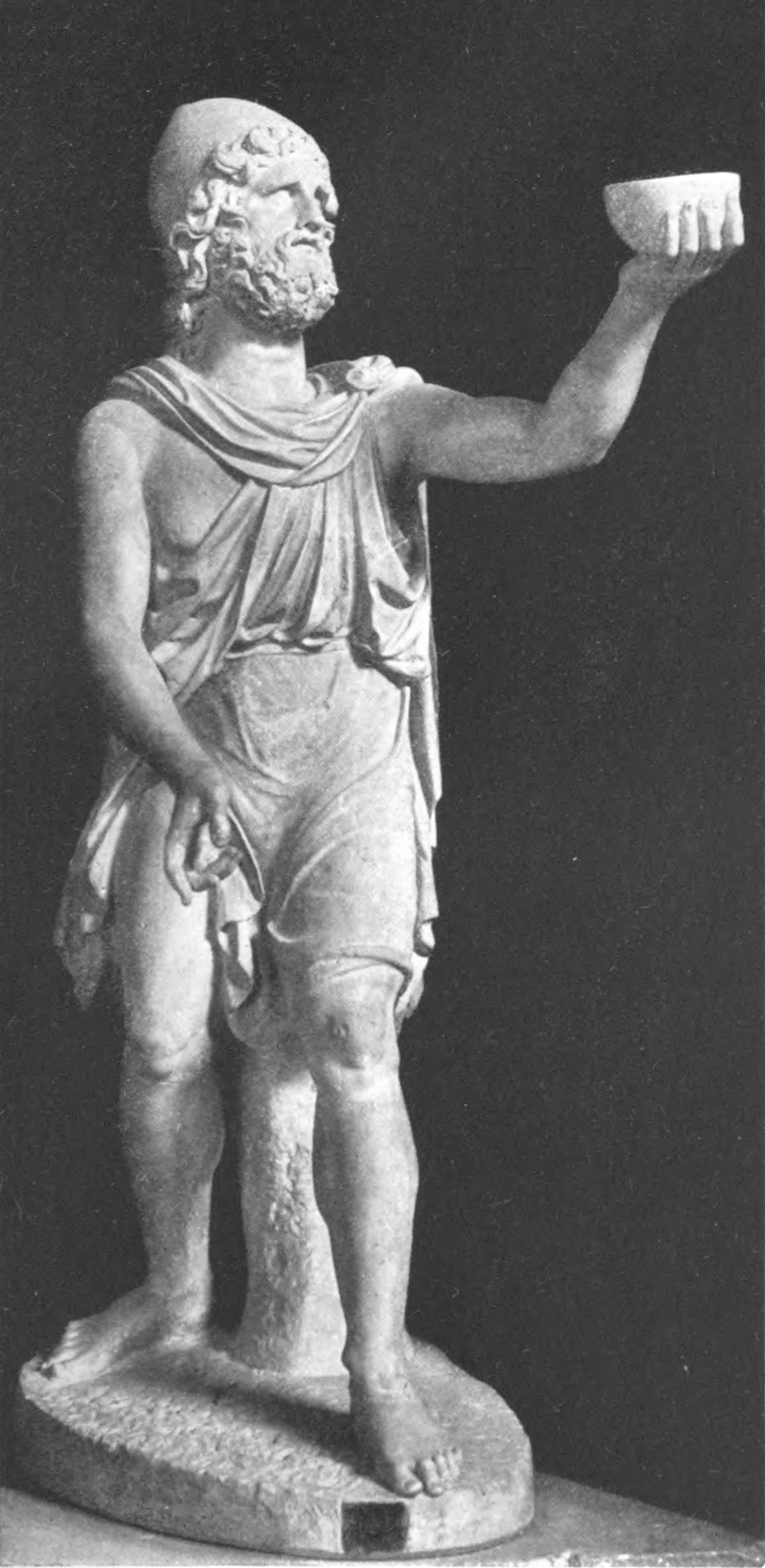
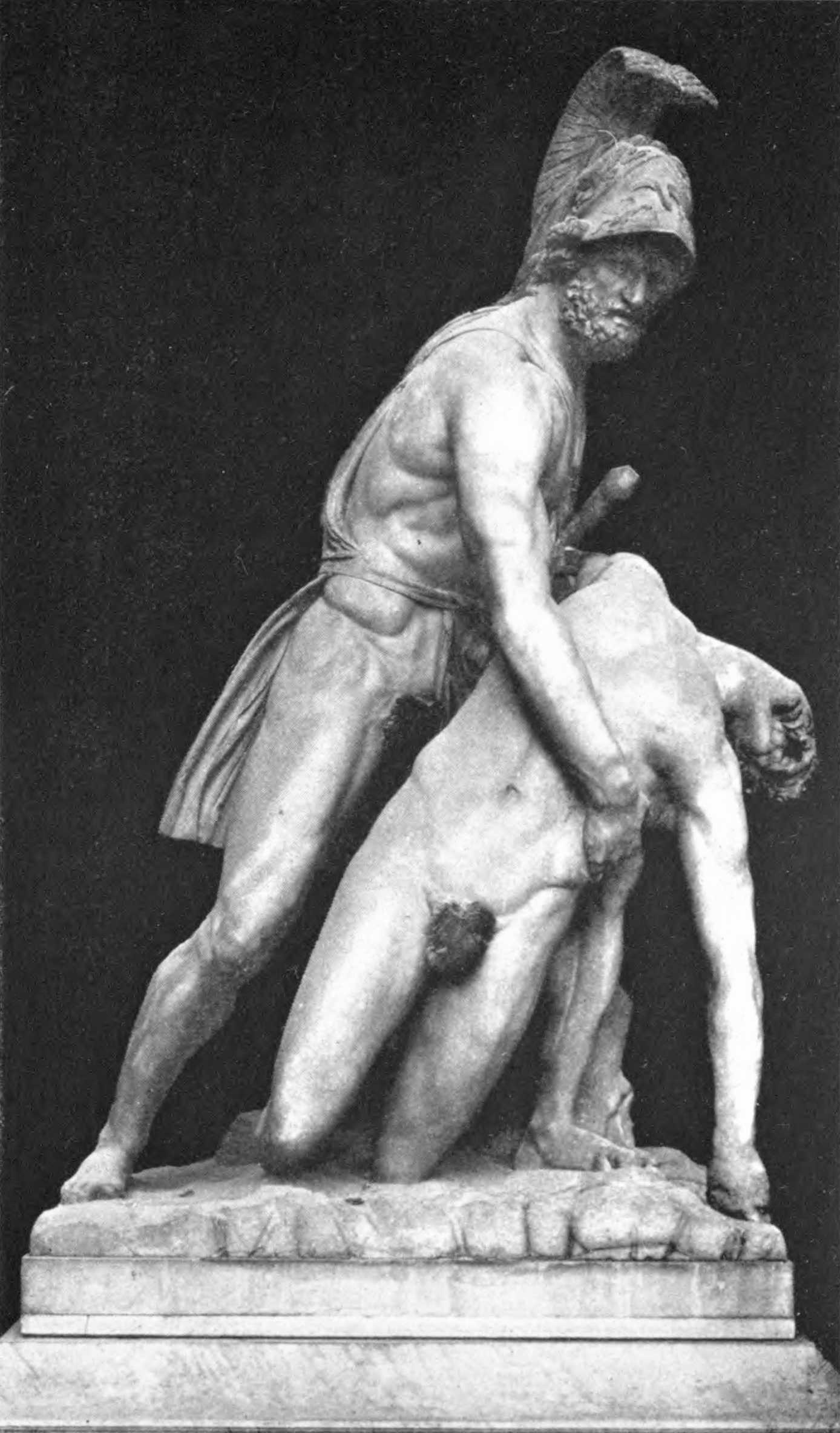
Of all the groups the best known and the most instructive is the latest of all, the Laocoon.86 In this marvellous group we see the full development of the effect of strained agony on the human form, and we see the mature form contrasted both with an active youth’s body and with the semi-inanimate body of the younger boy. When we have removed the restorations and lowered the right arm of Laocoon nearer to his head, we get a perfect group-design unified by the terrible serpent-coils and by the central theme of agony. The torso muscles of Laocoon are fully developed and even exaggerated, though not to the same extent as those of the Pergamene frieze, but the boys’ forms are simpler, and all51 reflect the basic principles of Rhodian art already enumerated. Pain is shown by the downward sloping eyebrows with sharp interior angles, by the half-closed eyes, wrinkled forehead, and parted lips. The hair is wild, and all the veins of the body stand out sharply. The twist above the waist occurs in all three bodies. It is interesting to notice that even in the Laocoon, the latest work of the most scientific school of Greek sculpture, anatomical accuracy is still lacking. The lower curve of the ribs above the abdomen follows a line impossible in nature, and the left thumb of the elder son is provided with three joints instead of the normal two. Neither the Laocoon nor any one of the other Rhodian groups is perfectly satisfactory to modern taste. There is too much strain, too much agony, too little relief or repose. Every inch of the group is illustrative of pain and passion. Our sense of sympathy is deadened by excessive emphasis and repetition. But in technical skill the group has never been surpassed.
A close parallel to the head of the Laocoon is found in the bearded centaur of the pair made by Aristeas and Papias of Aphrodisias (Fig. 38). Copies of this statue existing in the Capitol and in the Louvre show the despair of the elderly victim of love in the guise of a centaur tormented by a little Eros on his back. The companion figure (Fig. 37) is young and delights in the persuasions of his rider. This group of rather obvious allegory belongs to the Antonine age, but the resemblance to the Laocoon proves a first-century original, which is interesting because it is one of the earliest examples of a corresponding pair of statues clearly designed for house decoration. The growth of ‘cabinet pieces’, as opposed to temple or national dedications, now develops52 into the whole mass of furniture sculpture in the shape of candelabra, table-legs, consoles, decorative herms, &c., which mark the imperial age.
The school of Rhodes ends in extraordinary brilliance. There is nothing decadent in its technique, nothing paltry in its conceptions. We have seen the very pure and slightly finicky naturalism of the early third century give way to a rather more baroque extravagance in detail, but in neither its earlier nor its later stage did the purest of the Hellenistic schools affect the exaggerations of Alexandria or Pergamon. In Rhodes, at any rate, the steady development of Greek sculpture reached its perfect and logical conclusion. We have seen it start with a great idealism and no technique at all. In the fifth century technique and idealism are almost equally balanced. In the Laocoon the last word of technical perfection is spoken, but there is no idealism at all, only a man and two boys writhing in the grasp of serpents. It is not photographic naturalism, but it is histrionic, artificial, and dead. We cannot believe in the Laocoon as we believe in the Hermes of Praxiteles.
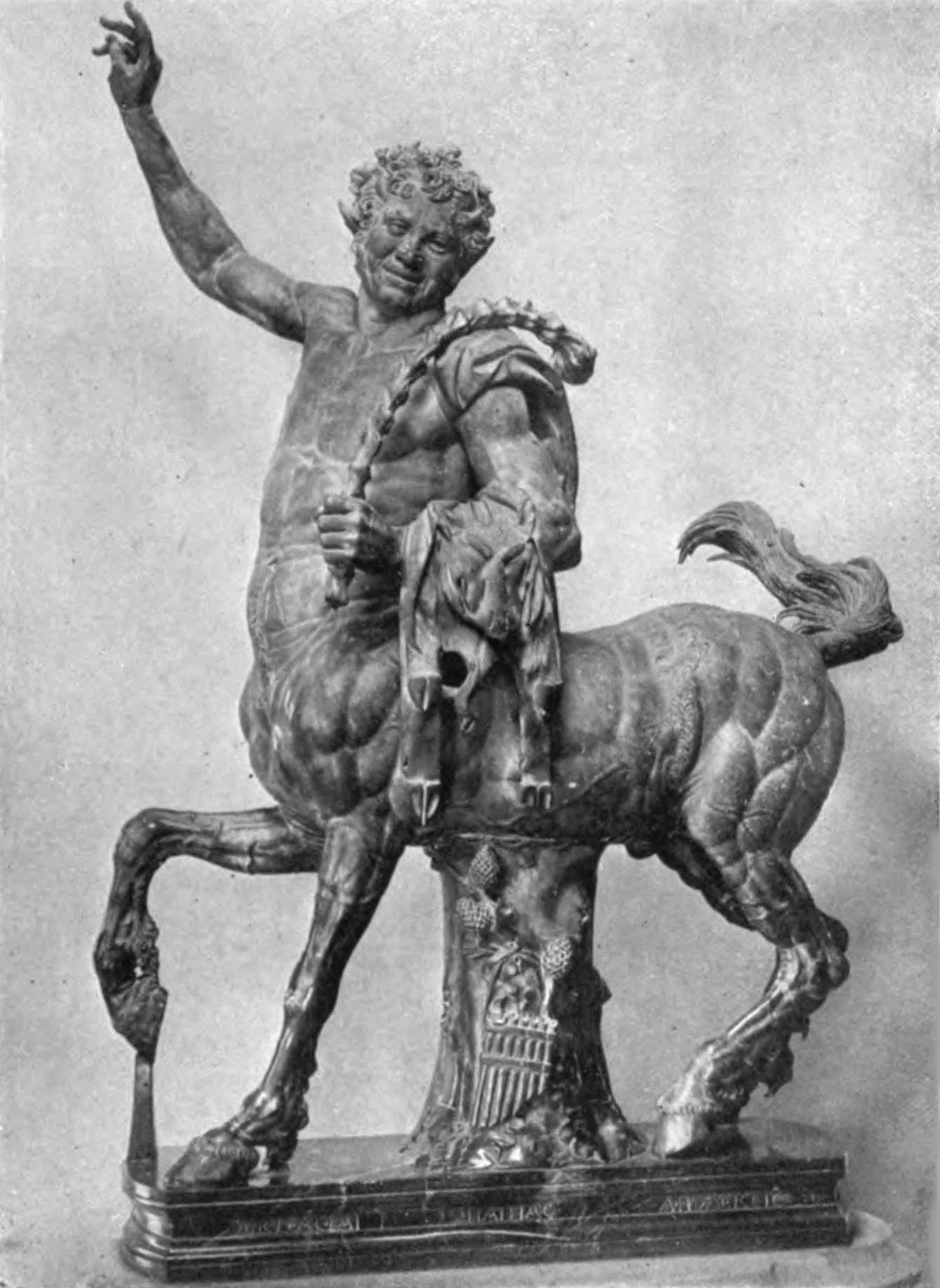
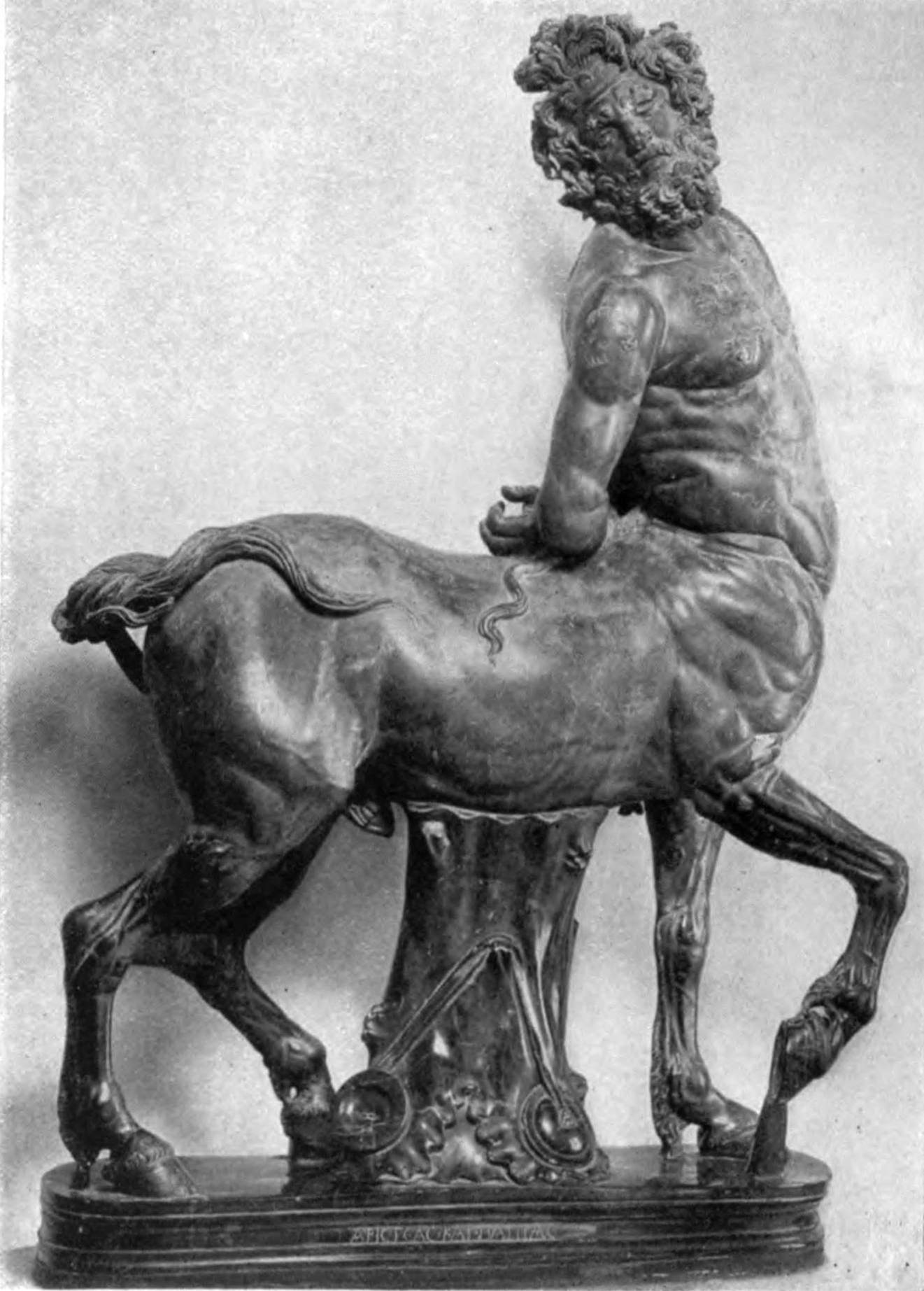
53
While the full tide of artistic development was running in the new societies of Pergamon, Rhodes, and Alexandria, the Greek mainland became a backwater. The rise of the kingdoms meant the decline of the old autonomous city states. Athens in particular fell into the background on account of her uncompromising hostility to the power of Macedonia. In spite of some brief periods of revival, her destiny was for the future rarely in her own hands, and her political subordination seems to have reacted with great rapidity upon her artistic output. She remained for another century after the death of Alexander the home of philosophy, but her art began to revive only after the Roman conquest, in a new form, which will require later consideration. Here at least the Hellenistic age is a period of rapid decadence and decline.
The Peloponnese is in much the same position. The pupils of Lysippos found their best clients abroad, and left no successors of importance at home. The political loss of power was here intensified by a growing poverty. The new wealth which began to pour into Europe as the result of the conquest of Asia went either to Macedonia or to those states which had sent mercenaries to Alexander’s army. The future prosperity of Greece was in the hands of Arcadia, Achaia, and Aetolia rather than Argos, Sparta, and Sikyon. The new54 states had few artistic traditions, and the old states had no means of gratifying theirs. The inevitable result was a great decline in artistic output as well as in artistic skill. Almost the only sphere left for sculpture was the erection of formal honorary statues to distinguished or wealthy individuals, a type of work which does not beget great art.

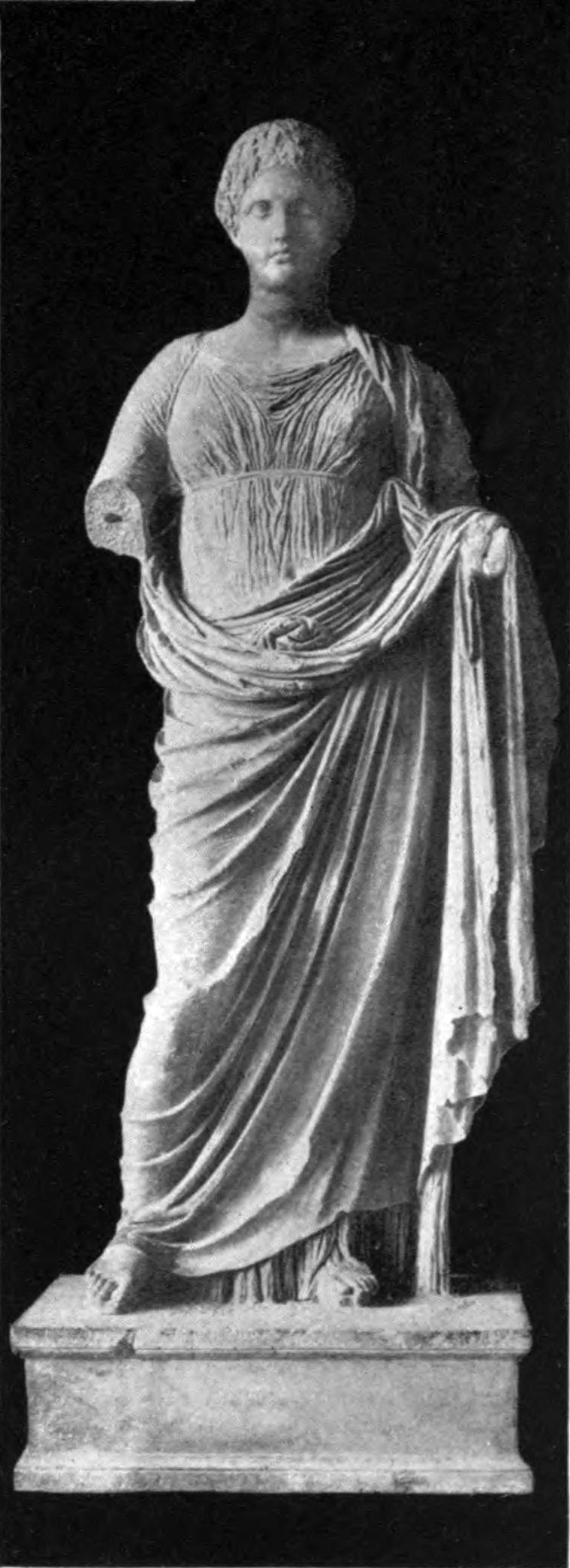
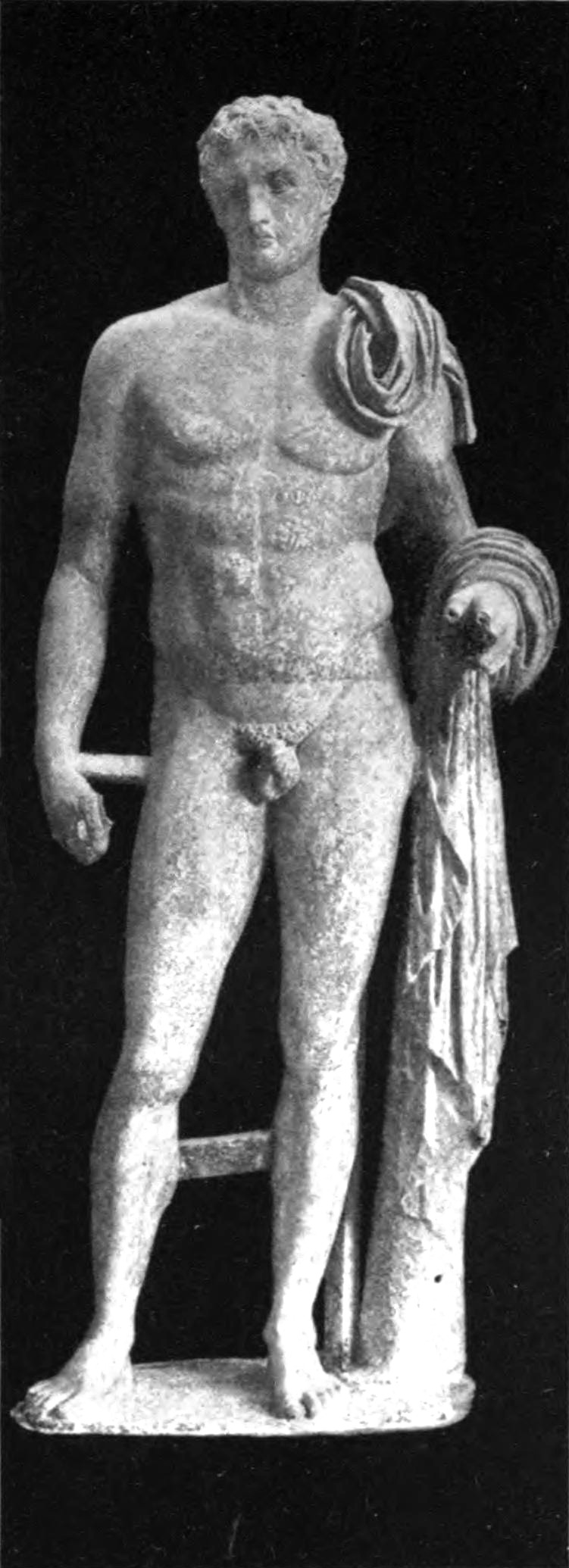
The first half of the third century was a period of very good work in portraiture, which is, however, a subject by itself. The Demosthenes of Polyeuctes is dated about 280 B.C., and the statues of Aeschines, Aristotle, and others show the existence of an admirable school of portrait sculptors at this time in Athens. But ideal sculpture shows a sad falling-off. The Themis of Chairestratos (Fig. 40) belongs approximately to this period, and it is marked by a great formality, not only in pose but in the treatment of hair and drapery. The classical period of sculpture in Athens was followed by what we must call an academic period. The foreign schools were developing on lines of naturalism, but at home sculptors tended merely to formalize the work of the fourth-century masters, and to produce statues of mechanical correctness without any vitality at all. We have seen the beginning of this tendency in the drapery system of the followers of Praxiteles. It now affects the whole of Attic sculpture. Old types are adopted again and again, until they become purely mechanical. Drapery styles are similarly used up, and the increasing formality of every department stifles entirely the possibilities of originality. The Hermes of Andros (Fig. 39) is a good example of this kind of crystallization of types. The statue was found in connexion with a tomb, and it is clearly a memorial statue. Its companion was a female figure reproducing exactly the pose and drapery55 of the draped female figure from Herculaneum at Dresden. The date would seem to be late third century. The Hermes itself is a replica of a type known in the Antinous of the Belvedere and other statues, and is a product of the Praxitelean school, like the Dresden figure. But the influence of Praxiteles is not alone in it. We have a clear use of Lysippic proportions and some Lysippic influence in the head. This eclecticism is an invariable mark of archaistic art. The sculptor, who has no new message of his own to deliver, looks back to antiquity for his types, but does not imitate one statue directly. The only form of originality which he is able to use is originality of combination and selection. Consequently he absorbs details from several artists and produces work which we label Lysippo-Scopaic, or Lysippo-Praxitelean, &c. We have seen how the late fourth-century artists in Asia Minor combined characteristics of Scopas and Praxiteles. The late fourth-century and third-century Attic artists made use of all their predecessors, and produced statues in which we can detect the disiecta membra of half a dozen styles. At the same time we may recognize the general predominance of Praxitelean tradition over that of the other artists and a universal predilection for marble instead of bronze.
One of the most interesting Hellenistic works of the Attic school is the bronze figure from Anticythera,87 which is still the subject of much dispute. It is a typical piece of eclecticism. The pose and twist of the shoulder and upper part of the torso are Lysippic, while the head is a mixture of Praxiteles and Scopas. The result, as might be expected, is somewhat inharmonious. In shape and profile the head is mainly Praxitelean, and therefore on its discovery it was acclaimed56 as a Praxitelean original. But looking from the front we at once see the resemblance to the Scopaic Meleager type,88 with its broad head, slight chin, and fringe of short upright locks like little flames. The head, and indeed the whole statue, is not unlike the bronze athlete of Ephesos,89 which has the same hair and facial type, together with a similar rather heavy Lysippic body. This heaviness of the torso in both statues shows that the Lysippic ideal is not followed directly, but rather the Attic version of it as used in the Agias of Delphi.90
Another Attico-Lysippic figure is preserved for us in a number of replicas, of which the two best known are the Hermes from Atalanta in Athens (Fig. 41) and the Hermes Richelieu in the Louvre. Here again Lysippic proportions are combined with a rather heavier Attic torso in a whole which lacks something of harmony and repose. The work has been referred back to a Lysippic original, but it seems more likely that it is an Attic adaptation of the eclectic school now springing into existence. The Attic grave reliefs give us good information about Attic art down to the end of the fourth century, but Demetrios of Phaleron prohibited them for sumptuary reasons in 309 B.C., and in future we have no such good guide to Attic art. Eclecticism is, however, pretty clear in the later examples which we do possess. The votive reliefs from the Asklepieion throw some light on the third century, but they are not on a sufficiently large scale to be very instructive.
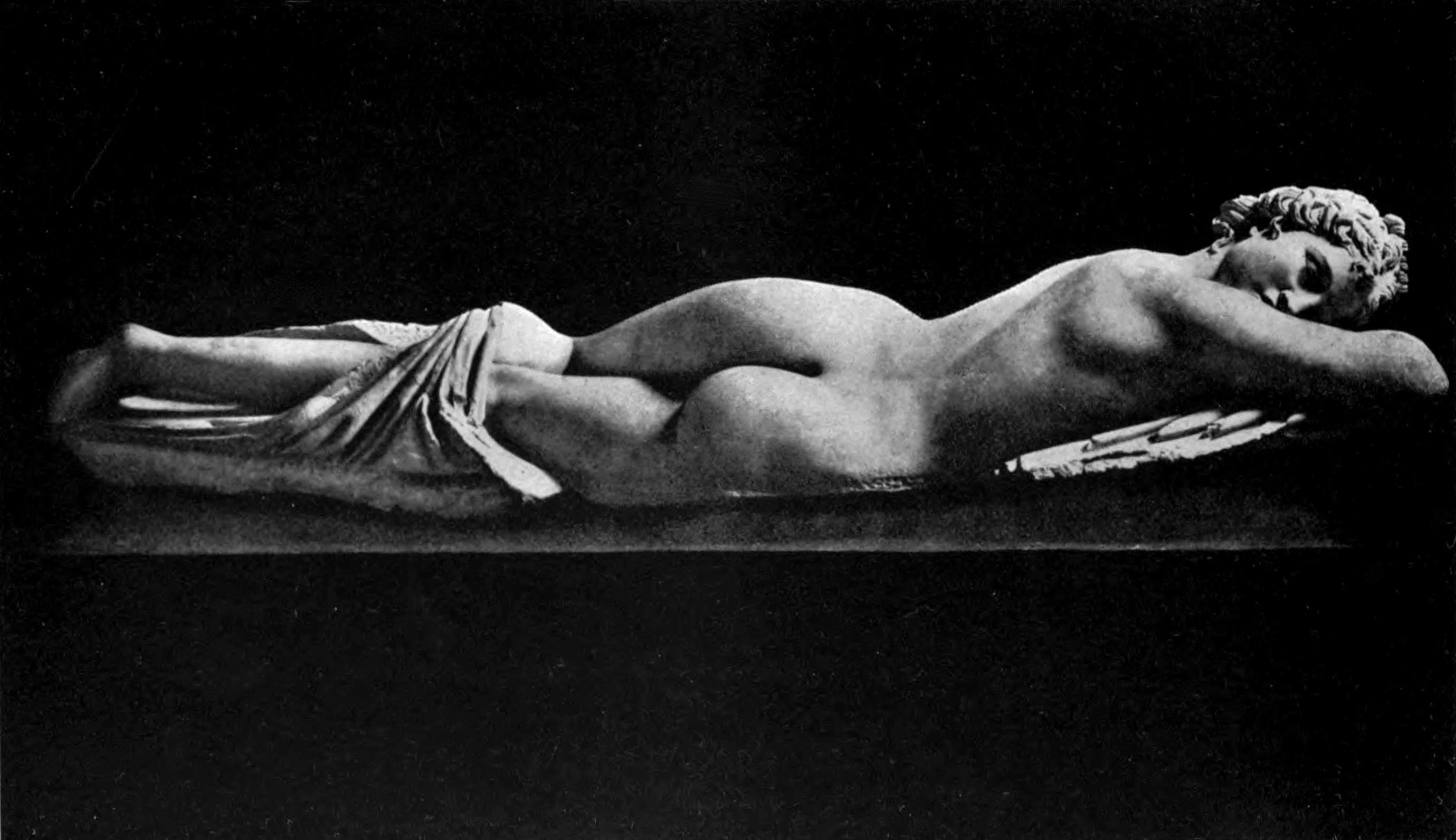
In Greece at all times professions tended to run in one family, and we have already seen examples of families of57 sculptors, such as that of Praxiteles, in which the craft was handed down from father to son for generations. The Hellenistic age is full of evidence for this phenomenon in Athens and elsewhere. Rhodes in particular gives us detailed families of sculptors, since we are better provided with inscriptions in Rhodes than in other centres. In Hellenistic Athens two such families are worthy of notice. Polykles, whom we may call Polykles I, had two sons, Timokles and Timarchides I; the latter had two sons, Polykles II and Dionysios; and Polykles II had a son, Timarchides II. These are known to us from literature or from inscriptions, and they cover more or less the second century B.C. It is a question to which member of the house we are to ascribe the very famous bronze Hermaphrodite mentioned by Pliny,91 or whether it should be referred to an earlier artist of the same name in the fourth century.92 A further question is involved in the identification of the Hermaphrodite, since it is commonly assumed that the Sleeping Hermaphrodite (Fig. 42), far the most famous type now extant in numerous copies, must have had a marble and not a bronze original. The statue of Polykles is identified with the Berlin Hermaphrodite93 by those who would give him a fourth-century date; with a bronze in Epinal94 by those who associate him with Hellenistic art. The Berlin Hermaphrodite is of Praxitelean type; the Epinal bronze resembles rather what we have called the Pergamene type of the Turning Satyr and the Aphrodite Kallipygos. The question is a difficult one, but we may safely exclude Polykles II. Timarchides I,58 his father, and Dionysios, his brother, worked on statues of a marked academic tendency. The C. Ofellius of Delos was the work of his brother, a statue of purely mechanical taste. This Polykles is not likely to have originated a great and famous statue. Polykles I worked as early as 200, a much better period for original work. He is a more likely candidate for the authorship of the type, if we suppose it to have resembled either the Epinal bronze or the Sleeping Hermaphrodite. On a priori grounds of its great popularity one would distinctly prefer to connect the latter with the statue mentioned by Pliny. It is true that it looks like a marble statue and not a bronze one, but a marble replica which served as the prototype for marble copies is by no means an impossible suggestion. But this Sleeping Hermaphrodite is a work of distinctly Pergamene tendency, intended to bring out the artist’s skill in the rendering of soft sensual forms. It would seem to belong to an earlier date than 200 or even 250. The Epinal bronze implies a similar date, and therefore we are left with a double difficulty. The best Polykles for our purpose seems to be fifty years too late for either of the types we require. We are, therefore, driven to suppose an intermediate Polykles about 270 B.C. In any case we must infer a reaction of Pergamene influence on the academic art of third-century Athens, but it was a solitary example which seems to have left no heritage to later artists.
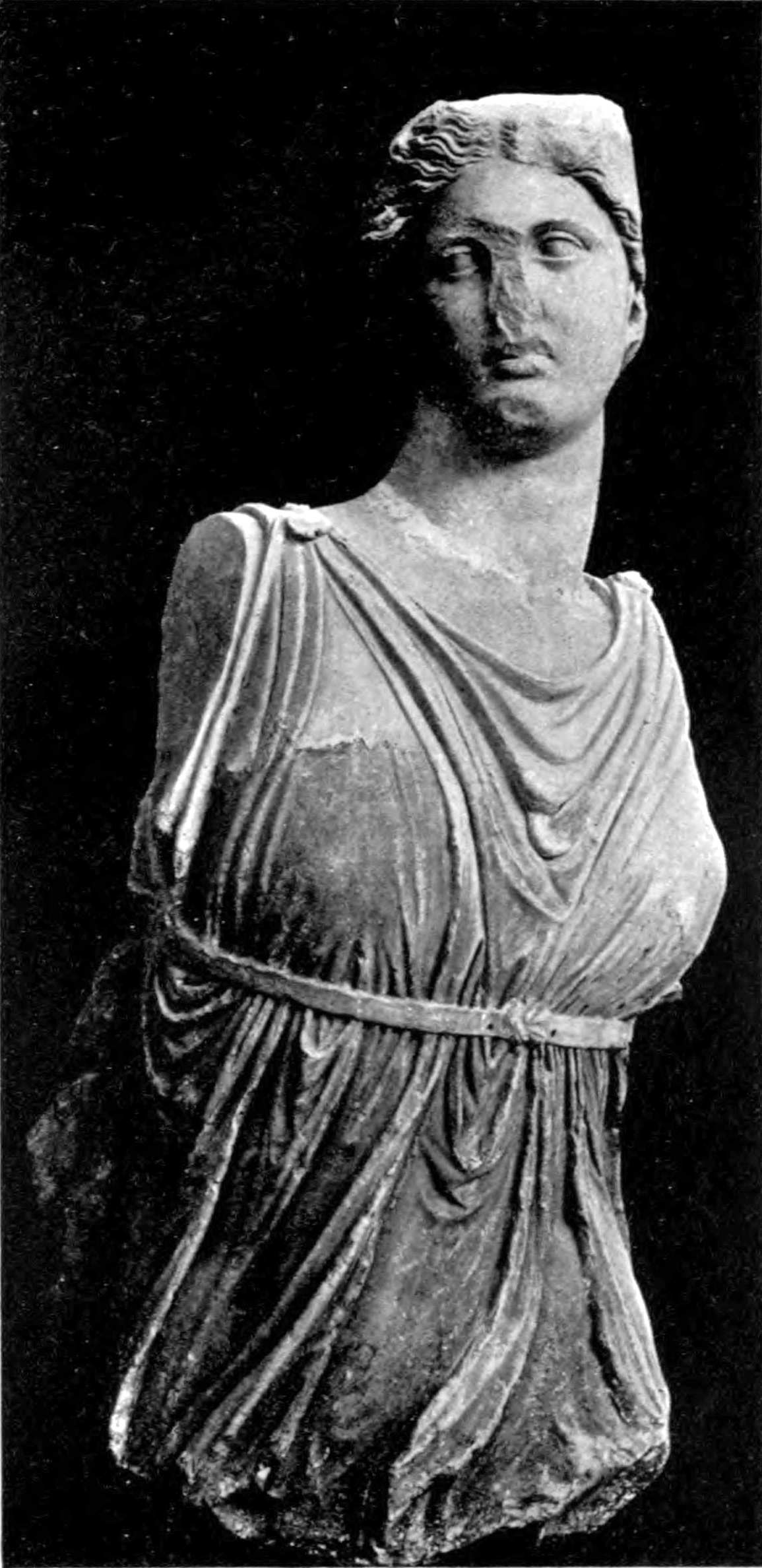
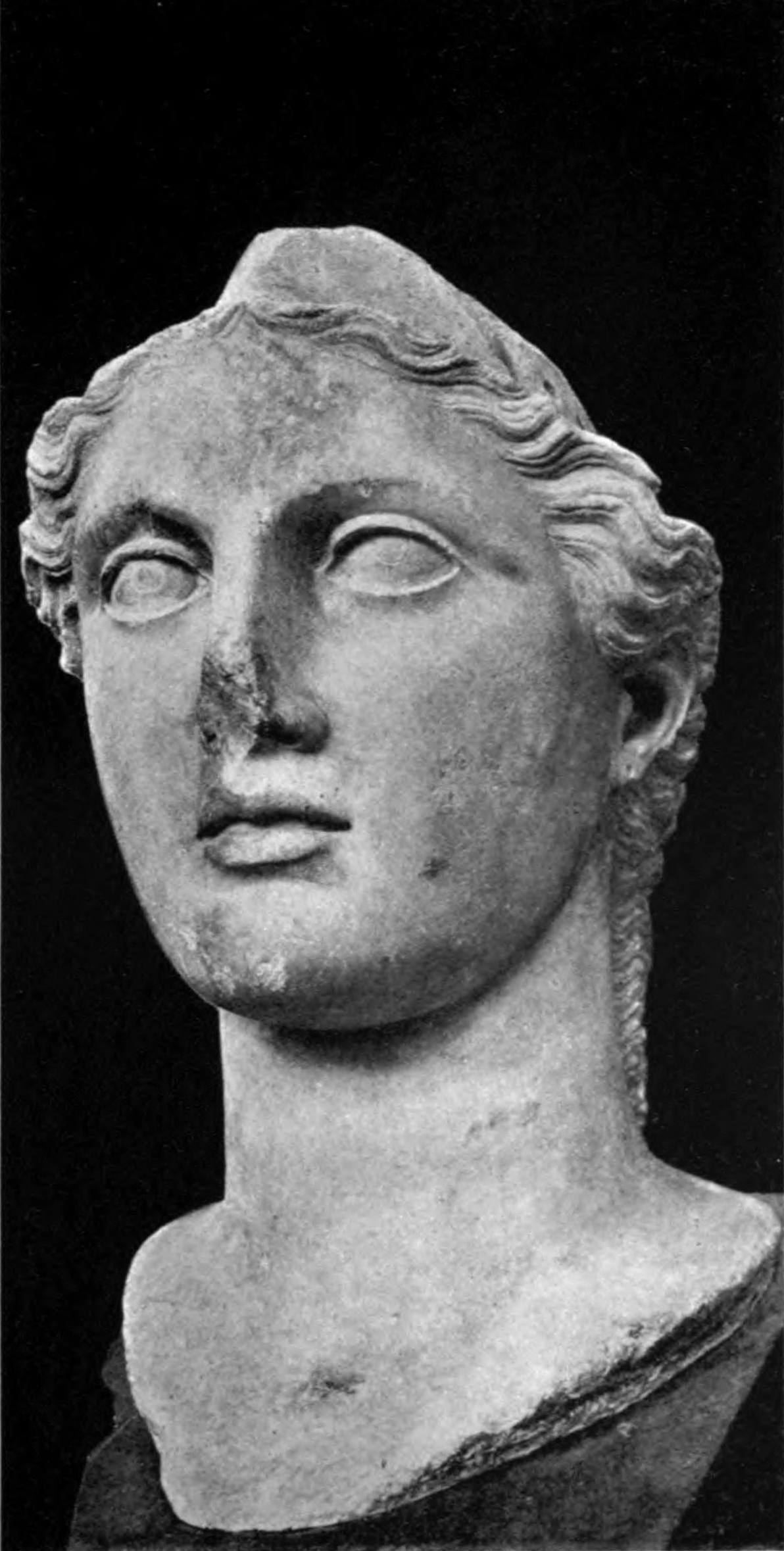
The sculptor family best known to us from inscriptions is that of Eucheir and Euboulides. We know of at least two representatives of each name, Eucheir I about 220, Euboulides I about 190, Eucheir II about 160, and Euboulides II thirty years later. The first Euboulides made a statue of59 Chrysophis, the second Eucheir athletes and warriors, and a marble Hermes at Pheneos. The second Euboulides is more important, for he was the author of a great monument outside the Dipylon Gate, considerable fragments of which have been recovered.
These fragments are our main evidence for the art of Athens in the second half of the second century B.C., and they show us that the academic art of the second half of the third century has followed out its natural development. The figures of Victory (Fig. 43) and Athena (Fig. 44), which have partially survived, are grandiose without being noble or effective. There is a distinct attempt to absorb some of the exaggerated idealism of the second Pergamene school; there is also an effort to recover some of the simplicity and grandeur of Pheidias; but the result is a staid and rather mechanical classicism, which is made only a little more obvious by the larger size of the figures. The Athena head, with its straightforward gaze, archaistic hair, large, wide-open eyes, and round, heavy chin is distinctly Pheidian; the Victory in rapid movement with head turned to the side is more affected by Pergamene art. Her drapery shows a curious combination of naturalism and formalism in the folds at the girdle; each individual set of folds is well studied from nature; but the repetition of a similar set right round the body is purely mechanical. The group is a good example of the limitations of the Attic artist at the end of his development. The next century sees a totally different activity.
In the Peloponnese we have a great gap after the pupils of Lysippos, a gap devoid of any evidence either literary or monumental. During the whole of the third century it would be difficult to point to any Peloponnesian art on a scale60 deserving of attention. But the second century opens with a name of some importance, Damophon of Messene. We are in the rare and fortunate position of possessing undoubted originals from his hand in the great group of Lycosura. These are practically our sole monumental evidence for the Hellenistic art of the Peloponnese.95 The date of Damophon is now established by inscriptions for the first half of the second century B.C., and a number of his works are more or less attested by coin-types. He had a considerable vogue in the last generation before the Roman conquest, and his leading position is evidenced by the commission he received to restore the Olympian Zeus. It may have been his hand which touched up and restored the corner figures of the west pediment of the temple.
The great group of Lycosura represented Demeter and Kore enthroned between standing figures of Artemis and a Titan Anytos. It survives in three heads and numerous fragments of limbs and drapery, and its conjectural restoration has been recently undertaken (Fig. 45). The discovery of a coin representing the group on its reverse goes far to justify the proposed design.96

The group is interesting from many points of view, but mainly from the flood of light which it throws on the methods of Peloponnesian sculpture at the very close of its development. It thus forms a complementary picture to the remains of the monument of Euboulides in Athens. Damophon, like Euboulides, underwent the influence of Pergamon. The colossal scale of his group and the wild hair of his giant61 Anytos (Fig. 46) demonstrate the influence of the altar frieze. Damophon also went back to Pheidias for inspiration. He must have absorbed many lessons from his work at Olympia. The seated group of his goddesses is reminiscent of the two figures next to ‘Theseus’ in the west pediment of the Parthenon. The simple wide-eyed grave expression of his Demeter head goes back to the fifth-century ideal, while his Artemis (Fig. 47) wears the melon-coiffure associated with the school of Praxiteles. The attitudes of Artemis and Anytos are Lysippic. Here we have every evidence of academic eclecticism. The same feature is borne out by three coins which reproduce the statues of Damophon. His Asklepios at Aigion gives us a fourth-century type. He copied the Laphria of Patras for Messene. His Herakles in the guise of an Idaean Dactyl at Megalopolis seems to have been a variant of the now fashionable herm figures and to copy a Hermerakles type known by numerous extant examples.
Damophon’s style then was academic and eclectic, borrowing from all sources of inspiration and in general using up over again well-known groups and poses. His execution is even more interesting for its extraordinary inequality. His heads are on the whole very good. The Demeter is a dull piece of work, but both the Anytos and the Artemis show some fancy and some power of original expression. The girl is demure and cheerful, the giant benevolent and rather sly. But when we come to examine the execution of the fragments of the bodies and limbs which survive at Lycosura, we find a very hasty and poor technical ability. The arms and legs are nearly shapeless. They are colossal, but practically formal in design, and details62 of muscles and sinews are almost entirely omitted. The drapery makes some effort to follow Pheidian designs, but it is poorly carved and without effect. Only in one direction does the artist show any skill, and that is in the great embroidered veil (Fig. 48) worn by Despoina. This is an extraordinary tour de force, not for its sculptural effect, which is purely formal, but for the reproduction of a complicated embroidered design in very low relief. A border of tassels with bands of design about it and large embroidered figures of Victory above the bands is rendered with consummate art. We have a frieze of sea-monsters, nymphs, and Erotes according to a common Hellenistic design, a curious local dance of beast figures in human dress, a dance paralleled by some small terra-cotta figures found in the same shrine, and the larger figures of Victory above carrying candelabra.
It is interesting to see the total want of proportion in the artist’s mind, who could devote so much time and originality to a comparatively unimportant piece of decoration, while treating the main lines of his drapery with carelessness and monotony. It is probable that we have here a procedure to be noticed in the Demeter of Cnidos—a head done with great care and placed on a torso of inferior execution. While Damophon worked the heads of all the figures and the drapery of Despoina, he must have left the rest of his group to a band of journeymen assistants. We know from inscriptions that Damophon had two sons, Xenophilos and another whose name is lost. It is, therefore, possible that Xenophilos and Straton, the Argive sculptors, were his sons. Their subjects were similar, and their Asklepios, as shown on a coin, is identical with Damophon’s.
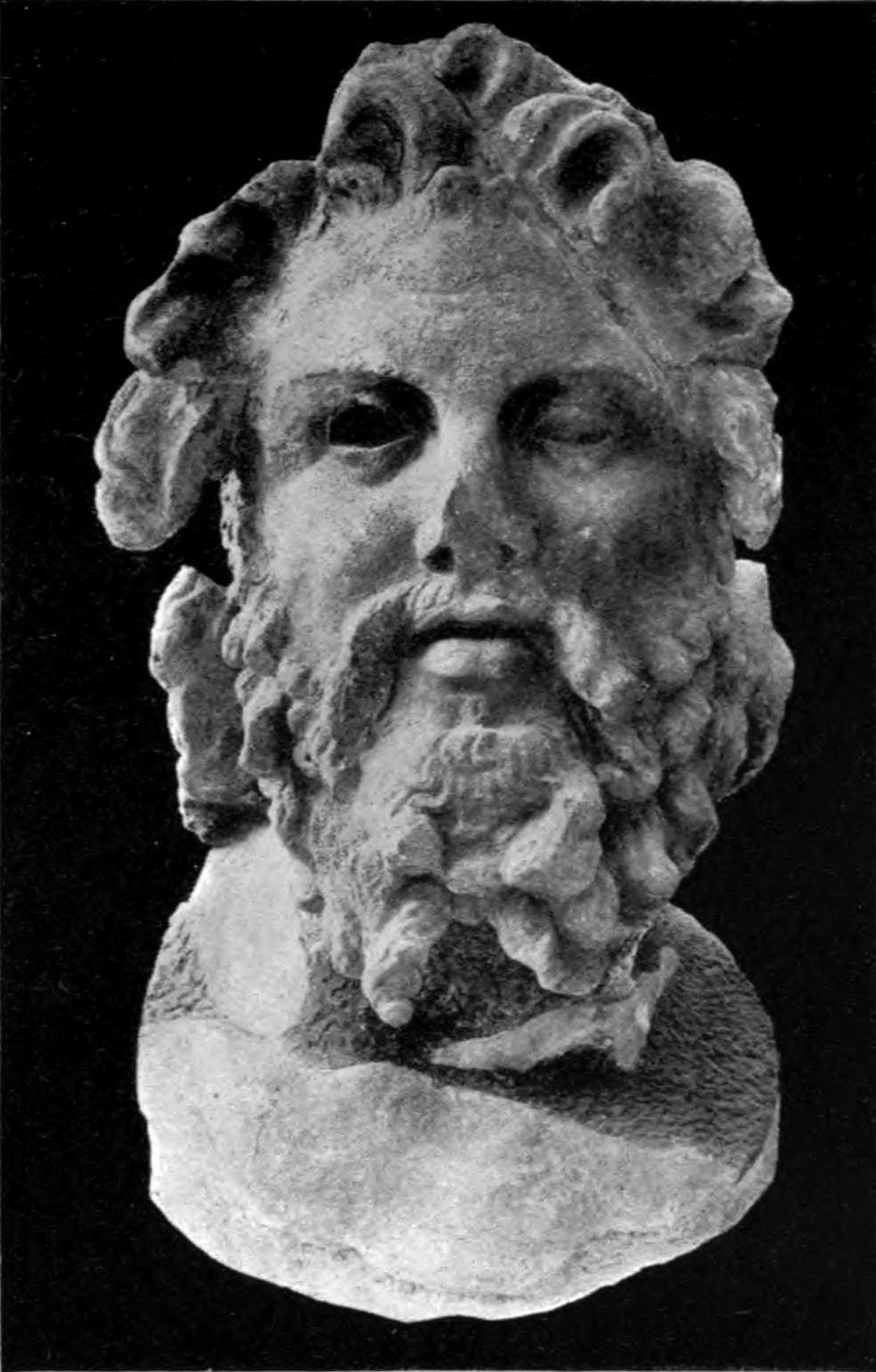
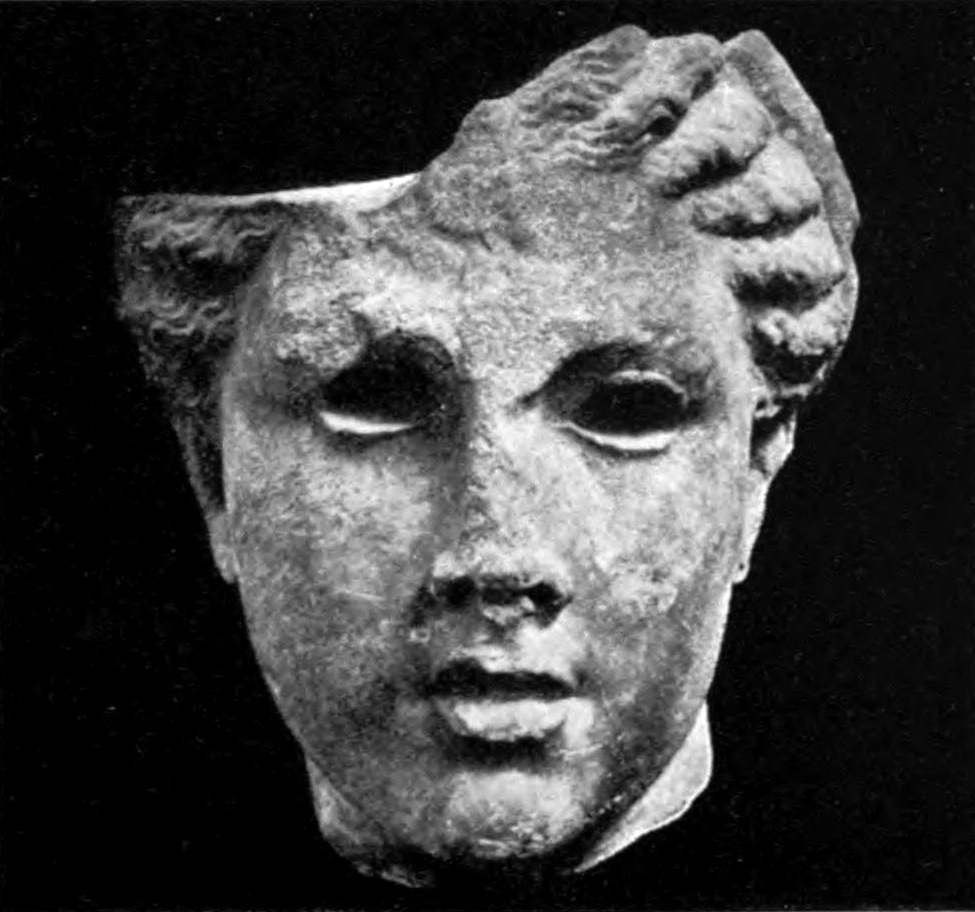

Thus Greek sculpture on the mainland came to a somewhat63 inglorious and academic conclusion with the Roman conquest in 146 B.C. We may examine one more centre of artistic work before leaving it, since it forms a link between Greece and Ionia, between the declining schools of the mainland and the vigorous art of Pergamon and Rhodes.
Melos has left us several Hellenistic statues of interest. The Aphrodite of the Louvre and the Poseidon in Athens are their most important representatives. The Poseidon (Fig. 49) is a typical work of histrionic bravura under the influence of the second Pergamene school. He stands in a defiant and dramatic attitude as if summoning his adversaries to combat, and his burly hair and beard recall the giants of the altar. But an eclectic taste is visible here also. His pose is Lysippic, and his restrained torso owes more to Rhodes than Pergamon. Melos is a meeting-point of trade-routes, in which many artistic currents must have come together.
The Aphrodite of Melos97 has attained a somewhat undeserved position as one of the world’s masterpieces of sculpture. Splendid piece of work as it is, it has most of the faults of its period. Much controversy has raged even over the actual facts of the discovery of this statue, but there appears to be no reason to doubt that the inscribed base, which was found with it and brought perhaps later to Paris, is part of it, and contains the true record of its author ...sandros from Antioch on the Maeander.98 This base has been lost, but drawings and statements exist to show that it fitted the actual base. The missing fragment had a rectangular hole on the upper surface, in which some additional64 attribute was fitted. The restoration of this missing piece of the base with its hole disposes of the theories occasionally ventilated that the statue was one of a pair. The hole is not the socket for fastening a statue, nor will it hold one of the small herms which were found with the Aphrodite. Its true significance has been pointed out by Furtwängler by analogy with several other statues and designs, including one from Melos and one actual copy of the Aphrodite herself. It served for the fastening of a slender column or stele on which the goddess rested her left elbow. A beautiful little fourth-century bronze in Dresden shows a similar motive. The restoration of the figure is now easy. With her right hand the goddess held or was about to hold her drapery to prevent it from slipping; her left elbow rested on the pillar, and her left hand, palm upwards, held an apple. This hand holding the apple was actually found with the statue, and undoubtedly belongs to it, as well as a piece of the upper left arm. The other hand found at the same time is alien and on a larger scale. The position of the hand, palm upwards, is certified by the unworked back, which would be invisible. The apple of course is a frequent symbol of Aphrodite, and particularly appropriate in the island to which it gave its name.

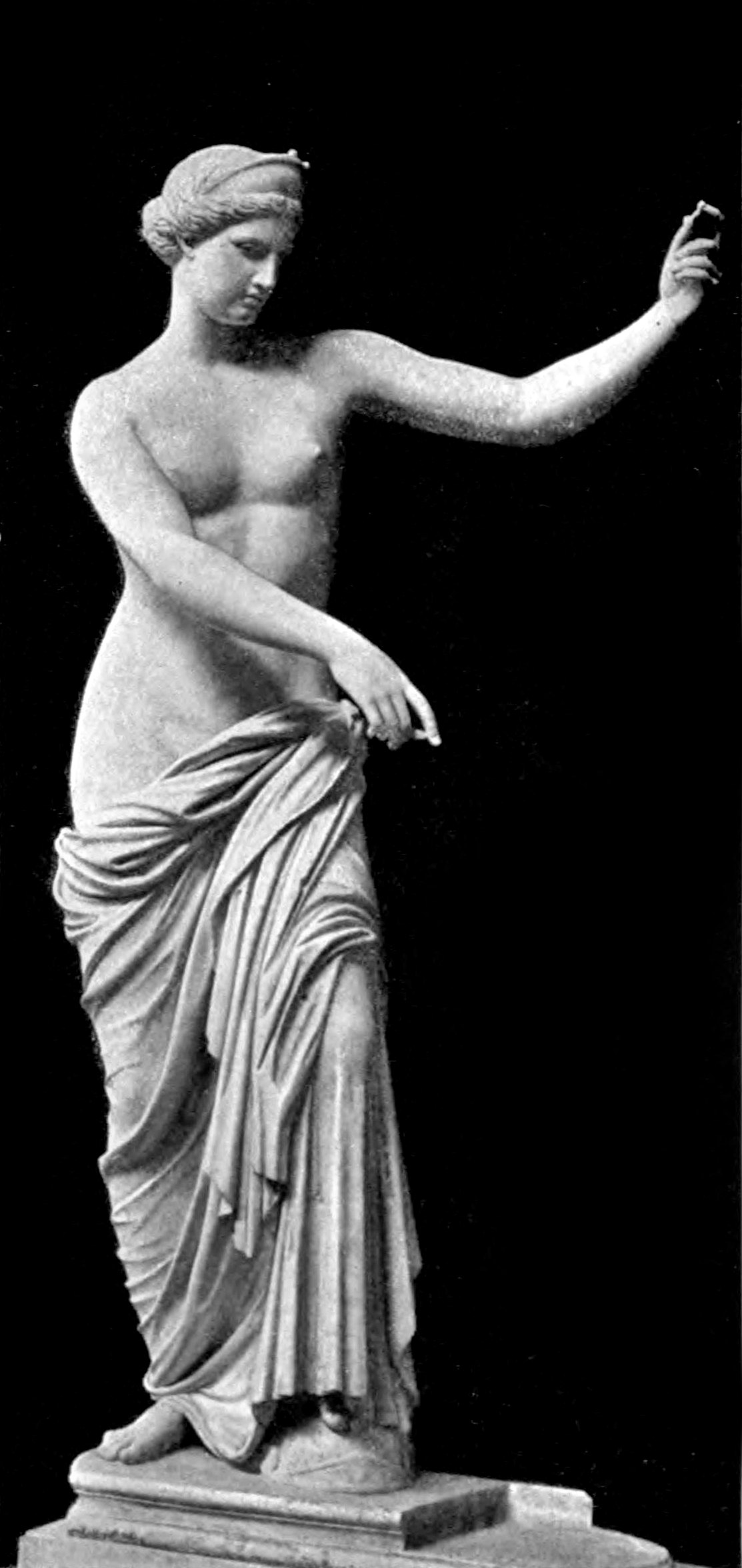
The Aphrodite was found in a niche or exedra, which was dedicated by one Bacchios with a second-century inscription. The base inscription of ...sandros, whose name we may guess to have been Agesandros, is also second century, and therefore we cannot hesitate to accept a date about 180–160 B.C. for the Aphrodite, especially as its style and technique are indubitably of that period. The pose may be described as reminiscent of Lysippos with its opposing65 lines of shoulders and hips and twist of the body above the waist. The head-type is Scopaic, but only Scopaic at second-hand, since the influence of Pergamon is much clearer. If we compare the head with the head of the girl in Berlin from Pergamon,99 or with the Pergamon Hermaphrodite in Constantinople,100 we see an identical treatment of hair, identical head-shape, and the same type of features in almost every detail. The drapery is interesting for yet another source of inspiration. Its division into flattish panels separated by groups of deeply-cut waving folds is in the manner of Pheidias and the late fifth century, while the naturalistic little detail on the right hip, where the lower folds are caught up and radiate from a single point, is thoroughly Hellenistic.
The style of the statue as well as its technique is clear proof of its date. The attitude of the goddess has no discernible motive. There is no reason why she should be half naked, or why she should twist her body round so violently from the hips. There is no explanation why her drapery should stay up at all in so insecure a position, or why her left foot should be raised higher than her right. But if we compare for a moment the Melian Aphrodite with the Capuan Venus in Naples (Fig. 50), a statue in a nearly identical position, all these points are explained. The Capuan Venus is half naked, because she is admiring her beauty in the mirror of the shield of Ares. She is twisted so as to look at herself in the shield and yet display her body to the spectator—in itself a Hellenistic device. Her drapery is held up, because the shield-edge holds it against her left hip; her foot is raised, because it rests on Ares’ helmet and66 thereby gives better support to the shield. The attitude of the Melian goddess is clumsy and stiff, because it has no motive; that of the Capuan is graceful and effective, because its motive is clear.
Now it is noteworthy that the many examples of this type in our possession are all copies of the Capuan and not of the Melian figure. This is clear from the direction of the drapery folds, which differs in the Melian from all the other figures. The history of the type is thereby made clear. It was an early Hellenistic or late fourth-century statue of the Armed Aphrodite, possibly the cult statue, which appears in identical pose on coins of Corinth. Itself a typical genre adaptation of a very early myth, it at once gained favour and was much copied, especially in Roman times. The Melian goddess was a second-century Hellenistic copy, but not a mere copy, rather an adaptation of the earlier prototype to a figure more suitable for Melos itself. Unfortunately the artist was unable to make the pose suit his new scheme properly. We get another adaptation in the Augustan age in the shape of the Victory of Brescia inscribing a roll of the dead on the shield,101 and finally, in the second century and later, we get a crowd of copies much closer to the original, of which the Capuan Venus is the best.
The history of the Melian Aphrodite throws much light on the Hellenistic art of the mainland and its neighbouring islands. We see its artists bankrupt of new ideas, and able only to adapt older conceptions to new requirements with a series of eclectic modifications. The Aphrodite is a close parallel to the monuments of Damophon and Euboulides, although its artist is admittedly a better sculptor. All three67 show a poverty of new ideas, but a strong reaction against the excesses of the later Pergamene school. They are, therefore, forced to look backward and make up new conceptions out of a medley of older details. It is of the utmost importance that we should remember this state of mind when we come to deal with Greco-Roman art.
68
We have now completed our survey of Greek sculpture on the mainland, and in connexion with the eastern kingdoms which Greece absorbed as conqueror. We have yet one other aspect to consider: Greek sculpture in connexion with the Roman world of the west, by which Greece was conquered. ‘Conquered Greece led her conqueror captive,’ and while Greek civilization as a whole strongly modified the Italic civilization by which it was overthrown, Greek art in particular established its mastery over the inartistic nation which supplanted it. We have many accounts of how Roman connoisseurs filled their galleries with Greek statues. Mummius, Aemilius Paulus, Verres, Cicero, Sulla, Asinius Pollio, were all robbers or purchasers of Greek sculpture, and by the time of Pompey and Caesar the great market for Greek sculpture was in Rome. The demand exceeded the supply of antique marbles, enormous as the supply must have been, for the systematic plundering of the great shrines belongs to a later date. And as the Roman noble could not be accommodated with originals, he had to content himself with copies. Doubtless few of the collectors could tell the difference. Rhodes continued to turn out original sculpture until the time of Augustus, but Pergamon and Alexandria had long sunk into decay. It was, therefore, the opportunity for a new school of artists to arise in Athens, an opportunity which was promptly taken. Athens and69 Delos, Ephesos, and later Aphrodisias, became great centres of the new industry, which was primarily commercial. There was no longer any talk of idealism or of votive offerings to deities. The necessity was to turn out quantities of work suitable to the Roman taste.
Greco-Roman sculpture falls into three clear divisions. There are copies pure and simple like the Delian Diadumenos, a straightforward replica of the masterpiece of Polykleitos; there are adaptations of earlier work like those turned out by the school of Pasiteles and Arcesilaos; and there are, finally, new works, mostly in relief, which have been termed Neo-Attic, and which represent a new artistic development based on an elegant and artificial archaism. Athens is the centre of all this art, and she thus recovers in the first century B.C. the position which she had lost for so long.
The direct copies of this age need not be considered here. Direct copying from the antique as distinguished from adaptation is a new feature very eloquent of the poverty of original ideas both in the buyer and seller of statues. But it is important to realize that the Roman market made sculpture for the first time a really paying business, and therefore saved it from the possibility of extinction. Had it not been for the new Attic school of sculptors, who sprang up in the two preceding generations, it is hard to see how Augustus could have secured the workmen for his great Roman buildings, which formed the basis of a fresh artistic development in Roman imperial sculpture. The copies of this period are the best and most faithful which we possess. They have still some vitality of their own, and are not the dead and soulless caricatures produced by a later age.
70
But in addition to their copying work the latest generation of Attic artists busied themselves with free adaptations from the antique on lines laid down by contemporary art. These productions are to be distinguished both from purely archaistic works, which copy the style as well as the poses of ancient sculpture, and from works like the Aphrodite of Melos, which make a wide selection from ancient styles and poses. Statues such as the Farnese Herakles of Glycon,102 the Apollo Belvedere,103 or the Artemis of Versailles,104 are not eclectic at all; they are older types taken over and translated into modern style. They show less originality than the Melian goddess, because there is no real change of pose or of meaning. An old statue is simply worked out with a new technique. Thus the Farnese Herakles gives a Hellenistic rendering of a statue by Lysippos, while the Apollo Belvedere is perhaps a new version of a work by Leochares. The former attempts to render the massive strength of the hero by immense exaggeration of muscular development in a style worse than anything perpetrated at Pergamon. The latter attempts to outdo the elegance of its original by an ultra-refinement of surface in every direction, and by an affected stage-pose and gesture. In both cases we see the effect of commercialism on art, for the artist no longer works on his own high standard of achievement. He is bound by the tastes of the patrons for whom he caters, and the uneducated Roman buyer liked to see strength shown by mighty muscles and refinement by daintiness of gesture. Both the Herakles of Glycon and the Apollo Belvedere are fine pieces of sculpture, but as works of art they are little short of abominable. We have no evidence about the original of the Artemis of71 Versailles, a statue of somewhat similar type to the Apollo. We may notice how the little fold of drapery above the left knee is turned up without any justification simply for the purpose of displaying the outline of the leg. The Medici Venus in Florence105 is an adaptation of the later version of the Praxitelean nude Aphrodite, the Capitoline rather than the Cnidian type. It is also an Attic work of this period, finely executed, but adding a yet further degradation to the Capitoline version by the additional elegance of its gestures.
The Torso Belvedere (Fig. 52) is another Attic work of great technical ability. Its prototype is unknown, and considerable controversy exists about its meaning and correct restoration. It is a seated figure with head and upper torso turned sharply towards its left, a position which suggests a Lysippic original. The massive musculature of the torso recalls Glycon’s Herakles, but the influence here is more Rhodian than Pergamene. One of the most popular suggestions106 for its restoration makes it a Polyphemos shading his eyes with one hand, as he looks out for Galatea, and holding a club in the other. A similar type is known from wall paintings. No agreement on this point has, however, been reached.
Works of this quality of technique, even if uninspired by high artistic feeling, show how greatly the Attic school has improved since the days of Euboulides. In sculpture the skill of the workman depends largely on the popularity of, and demand for, his work. The new vogue of sculpture soon produced a high standard of technical efficiency. But if Greco-Roman art remained wholly and unalterably Greek, Greece itself was not allowed the monopoly of its production.72 During the early years of the first century two Greek artists transferred their business to Rome itself, and initiated thereby a new school of Hellenistic sculpture. These were Pasiteles and Arcesilaos, names of high importance for Greek art.
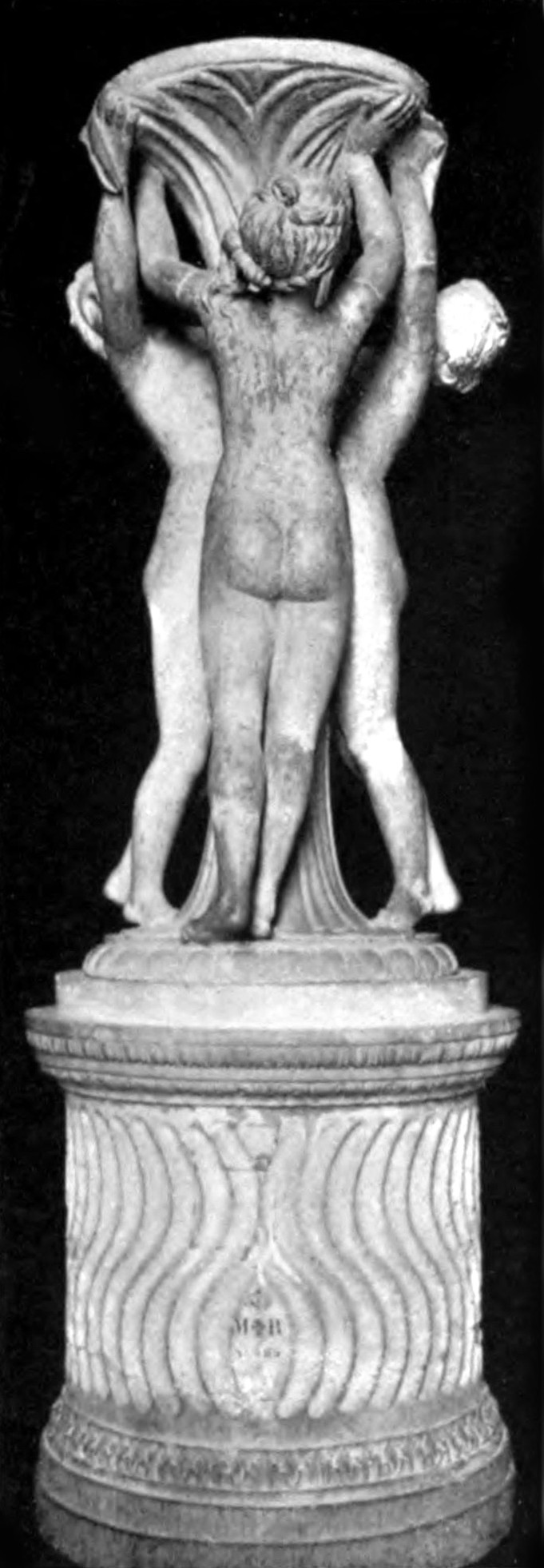


Pasiteles was an artist of great versatility and scientific attainments. He wrote a work on Greek art in five books, which served as a primary authority for Pliny.107 He was a goldsmith and a metal worker, and his range of sculptural subjects was very wide. He is known to have paid special attention to the sculpture of animals, and it is recorded that he studied a lion from life at the Roman docks. He seems also to have been the originator of a device, which did much to injure the later development of marble sculpture.108 Bronze workers had always had to prepare clay models usually finished in wax after the invention of the cire perdue process; metal workers of all kinds had need of the same preparation; but in marble sculpture the use of models had hitherto been confined to pedimental designs or similar productions prepared by great artists and worked out by masons. The effect on architectural sculpture had usually been unfortunate. It is expressly told us of Pasiteles that he always made use of clay models for all his work, that is, including his marble sculpture. It was, no doubt, inevitable in a commercial age, where copies were in great request, and where several replicas were made of the one original, that the use of clay models designed by the master and copied in marble by pupils and workmen should become general. The ultimate results of such a procedure were destructive to the whole73 art; for workshops came to possess a stock of models and to turn out machine-made copies on demand. The finished statue became merely the work of masons untouched by the original master, who devoted himself entirely to the preparation of models and designs. The sculptor’s workshop instead of being a studio degenerated into a factory. No doubt Pasiteles himself was an artist who did much original work, but in the hands of his pupils and followers statue-making was a mere trade. Unfortunately the works of his school, which survive for us, are almost wholly these mechanical and commercial by-products. The works of real fancy and charm have almost wholly disappeared. Many of the Hellenistic reliefs, especially those of the Palazzo Spada type, are to be attributed to the Greek sculptors in Rome. These show an elegance and a dainty affectation quite in keeping with the spirit of the age. The group of Appiades (Fig. 51) by Stephanos,109 a pupil of Pasiteles, has been recognized in the group of three nude girls holding up a water-pot, now in the Louvre.110 The Three Graces are also a conception of this age. Neat competent work of a decorative type seems to sum up the original achievements of this school, which fall more or less in line with the Neo-Attic reliefs shortly to be considered.
But most of our remains of the school of Pasiteles belong to a different class of statue, best illustrated by the athlete of Stephanos, Pasiteles’ pupil, in the Villa Albani (Fig. 53). All periods of art which are bankrupt in new ideas tend to be archaistic; the Greco-Roman school looked backwards for all its inspiration; but while Neo-Attics found their models in Ionian art of the sixth century, the pupils of74 Pasiteles studied their larger sculpture mainly in the light of the early fifth-century Argive school. The athlete of Stephanos shows the proportions, the stiff pose, and the surface treatment of the pre-Polykleitan types of Ageladas. He is comparable with the Ligourio bronze111 or the Acropolis ephebe112 of Kritios for all his Lysippic slenderness and later expression. The type was immensely popular and may have originated with Pasiteles himself. We have it in single examples and combined in groups, as in the Orestes and Electra of Naples,113 where the companion figure is female, or in the Ildefonso group114 where it is combined with another male statue. All these figures are copied from early fifth-century art, though the signs of eclectic archaism are sufficiently clear. If we examine the so-called Electra of Naples, we see an archaic early fifth-century head together with a pose approaching the Praxitelean, transparent drapery of the style of Alkamenes, and a low girdle and uncovered shoulder reminiscent of Pergamon. The group of Menelaos,115 a pupil of Stephanos, in the Terme Museum, is a less archaic-looking and a more satisfactory work. Fifth century in detail, in style it reminds us rather of the fourth-century grave reliefs. To the same period, or perhaps a later one, belongs the idea of grouping well-known statues originally separate. Thus we have in the Capitol a group of the Melian Venus with the Ares Borghese.116 This actual group, however, belongs to a much later time.
75
Arcesilaos was another well-known sculptor of the age, a friend of Pompey and Caesar. The Venus Genetrix of the Louvre117 was made for the House of the Julii. It bears its fifth-century origin clearly stamped on its style. Arcesilaos also was a great provider of clay models, which he sold outright to workshops for manufacturing purposes, so that a finished statue might have never been seen by the artist responsible for its design. A series of herms in the Terme Museum118 show a strong archaistic tendency towards fifth-century models, but bear also in details of pose and drapery the clear stamp of the Greco-Roman age. Statues of this type were intended for the decoration of Roman palaces. They are no longer self-sufficing works of art, but are subject to the general demands of artistic decoration.
This brings us to the third division of Greco-Roman sculpture, in reality its most original contribution to the history of Greek art: the Neo-Attic reliefs,119 all of which are primarily decorative in their purpose. The works with which we have hitherto dealt—the Apollo Belvedere, the Torso Belvedere, or the Venus Genetrix—have all been eclectic in style, and consequently have lacked the sense of harmony or uniformity, which is one of the conditions of great sculpture. The same criticism applies to all the sculpture of the mainland in the Hellenistic age. On the other hand the schools of Pergamon, Rhodes, and Alexandria attained a uniformity of style, and consequently were enabled to produce masterpieces of art. Their works can be attributed to a school, because they contain common elements of style and technique based on a common theory of art. This76 community of purpose has been wholly lacking in the works of Euboulides, Damophon, and the Melian artists, and only partially felt in the works of Pasiteles and Arcesilaos. All these artists were individualists selecting and combining at their own will and pleasure. The Neo-Attic artists are quite different. Their names are immaterial, because their works all bear the impress of precisely the same style. There is no chance of mistaking a Neo-Attic work; its origin is clear in every line. These reliefs represent the last true school of Greek sculpture, the last monuments in which a common line of development can be studied unaffected by individual idiosyncrasies. They are strongly archaistic, but in spite of this they are essentially modern. They neither copy the antique exactly, nor adapt it to existing modes as the followers of Pasiteles did. They rather invent a new mode and a new style in art, but they make use of archaic technical details for its expression. Their art is essentially artificial and symbolic, so that they represent a reaction against the academic classicism of the period; but it is also meticulous in detail, so that it can merit no reproach of a loose impressionism. The Neo-Attic artists of the first century B.C. are really the pre-Raphaelites of Greek art, and Rossetti and Burne-Jones are the nearest parallel to them in later art history.
Their reliefs are all decorative in purpose, for the adornment of altars, candelabra, fountains, well-heads, or wall-panels; and therefore they are not unnaturally attracted by the most decorative of all the archaic schools, the late Ionian or Attic-Ionian art of the end of the sixth century. They make use also of later models, of the Victories of the Balustrade, of Scopaic Maenads, of Praxitelean satyrs, but all the models which they adopt are treated in a uniform77 style, a new style of exaggerated daintiness of pose and gesture accompanied by an archaistic formality of drapery and modelling. In this detail they contrast strongly with the realism of the pre-Raphaelites. Their daintiness and formality are derived from Ionian models, but reproduced in a wholly different setting.
The vase of Sosibios in the Louvre120 reproduces some of their favourite types, which occur over and over again in the decorative art of the early empire. The flute-playing satyr, the dancing maenad, the armed dancer, and all the other types are reproduced in every variety of combination, but in identical form. The Neo-Attic sculptors were content with the elaboration of a few types which they combined at pleasure. They never attempted more intricate groups than their variant of the two Victories with a bull from the Acropolis Balustrade. Usually they merely group single figures in long rows without any connexion in thought. Nothing could bring out more clearly their essential poverty of ideas and the purely commercial character of their art. The designs are like so many stencil patterns which can be applied to any form of monument.
When we examine the figures more closely, we can see the elements which make up their characteristic style. The figures invariably march on tiptoe. Their fingers are extended and the little finger is usually bent back in an affected manner. This detail is derived from the archaic pose of the hand holding out a flower, so common in late Ionian art. The tiptoe pose is also found on ancient reliefs. The drapery is based mainly on that of the late fifth-century Attic school, but with various additions and refinements. The fluttering ends78 of cloaks and mantles recall fourth-century reliefs, while the curving swallow-tail ends of flying drapery are imitated directly from the sixth century. The drapery on the figure itself usually hangs in straight archaic lines as in the Artemis of Pompeii,121 where the zigzag shape of ancient folds is reproduced with great formality; or it follows an almost equally artificial system of wavy folds, based on the school of the Balustrade, as in the fine relief of a dancing Maenad in the Conservatori Museum.122 The elegant lounging poses with bent head, which remind us somewhat of Burne-Jones figures, are based no doubt on Praxiteles. The delineation of the surface muscles of the nude body also follows a uniform rule derived rather from the middle fifth-century Attic art than from that of Ionia. The muscles of the male figures tend to be over-emphasized, so far as that is conformable with the elegant slenderness of their figures. But a description of the figure-types of Neo-Attic art is incomplete without some notice of the intricate decorative designs of plants and animals which always frame and enshrine the reliefs on altar or candelabrum. Archaic Greek decoration was always formal and conventional in character. The exquisite mouldings of the Erechtheum or of the later Corinthian capital are not naturalistic but highly stylized. Naturalistic floral or animal decoration begins with the Hellenistic age, and is especially prominent in the Neo-Attic monuments. The trailing vine, grape-clusters, wreaths of flowers, new heraldic sphinxes, lions’ heads, &c., are carefully worked out from nature and combined with the remnants of the old decoration of palmettes, volutes, and tongue and79 dart mouldings. The vase of Sosibios shows a combination of the two principles, which is truly symbolic of the Greco-Roman combined school, for naturalistic decorative designs are just as representative of Roman art as formal ones are of Hellenic. From the combined system of the Neo-Attic reliefs we pass directly to the purely naturalistic floral designs of Augustan architectural sculpture.
Our survey of Greek sculpture must conclude with the great buildings of Augustus. In them we see for the first time the combination of Italian with Greek principles. The Greco-Roman art which we have noticed hitherto has been archaistic and eclectic, but it has been purely Greek. Roman tastes have been studied and gratified, but style and technique have remained wholly Greek and uncontaminated. Even in the new buildings this procedure still continued. Pliny tells us that Augustus, who had the fashionable taste for the archaic in Greek art, actually imported the Korai of Bupalos and Athenis for use as acroteria on his monuments. The Conservatori Museum contains an almost exact copy of one of these Korai,123 which must belong to the age of Augustus, as well as a very inferior adaptation of the same type. The Kore figure was translated into the so-called Spes type for mirror handles and other elements of decoration.
But Augustus was not the man to submit to a complete extinction of Italian artistic principles. His system was closely identified with a revival of ancient Italy in all directions, and he was not likely to abandon Italic art. It therefore came to pass that in the greatest sculptured monument of his period—the Ara Pacis124 erected on the Campus Martius,80 which is now being gradually and laboriously pieced together again—we have a combination of Greek and Italian principles of first-rate importance for the subsequent development of Roman art. One side of the altar contained a relief of Tellus or the Earth, which is hardly distinguishable from the pastoral Hellenistic reliefs, but the procession which fills the greater part of the other sides is treated in a very different manner. The general scheme is Greek, and must have been influenced by the Parthenon frieze, but the treatment in detail is Italian. Thus we have the Roman toga with its voluminous soft folds, and the Roman principle of direct realistic portraiture in all the heads. But more important than the portraiture is the appearance of a new development of perspective in relief which is destined to have a great career in the future of art, and which has been regarded by some authorities as purely Italian.
Greek reliefs had always been represented as if against a tangible background, at first practically in two planes only, and then in Hellenistic times in truer perspective, but invariably against a background of some kind. Roman art, on the other hand, in its more developed reliefs like those on the Arch of Titus,125 eliminates the idea of background and regards the wall on which the reliefs are placed as nonexistent. The reliefs are intended to give the illusion of free sculpture, as if they were standing in the round against a background of the sky. A much greater depth must, therefore, enter into the principle of perspective. Just as in the bronze reliefs of the Florentine Baptistery Ghiberti used the principle of no background and attempted to show a whole countryside behind his figures as if the relief were81 a picture, so the artist of the reliefs of the Arch of Titus uses a strongly diminishing perspective and a pronounced foreshortening of his figures to produce this same effect of free sculpture.
In Greek sculpture of the Hellenistic age it is true to say that the depth of the background has been greatly increased. This is visible even as early as the Telephos frieze. But it would be hard to point to a Greek relief in which the effect was wholly pictorial and the idea of the background was entirely abolished. This principle, however, does appear in the reliefs of the Ara Pacis, and therefore they mark a new era in art. The perspective and the foreshortening are stronger and more illusional. In the background we get flat heads just incised in the marble to give the effect of the depth of the crowd. The scene is in fact not a procession in Indian file but a true crowd many ranks deep. The principle is not altogether adequately carried out in the Ara Pacis, but soon it is more completely mastered. The stucco decorations of the Villa Farnesina,126 though in the lowest possible relief, express a depth greater than any Hellenistic landscape relief. They are purely pictorial in character.
The subordination of sculpture to pictorial ideas is Italian not Greek. Italy through Etruria, her real artistic pioneer, was always a patron of painting rather than sculpture, and therefore under the Empire sculpture becomes either wholly decorative or merely devoted to portraiture. During the reign of Augustus Greek influence still persists, and under Hadrian we have a Greek revival, but from Tiberius to the Renaissance sculpture descends from a primary to a secondary art.
82
Another great development of Augustan sculpture is the free use of naturalistic floral designs. Etruscan and Roman art was always realistic, and never tolerated conventions when they could be eliminated. Roman architecture and art both abandoned at once the Greek use of formal conventional mouldings. The Ara Pacis and other monuments of the Augustan age first give us the beautiful rendering of purely realistic wreaths of flowers and fruit, which are the hall-marks of Roman altars and friezes. The Imperial art of Rome as it begins under Augustus is profoundly indebted to Greek art for almost all its types and its technical procedure. Doubtless the greater number of his artists and architects were Greeks. But they were working in the midst of a new culture and a new environment, and thus they unconsciously absorbed new traditions and new ideas, just as their predecessors had done in Pergamon and Alexandria. In Greece itself no further advance was possible. Artistic production was purely commercial, and all the sources of inspiration were closed. In Rome, where alone could be found a career for a creative artist, he had gradually to submit to the genius loci. The artificers of the empire must have long remained Greeks, and all Roman art bears the stamp of Hellenic origin, but at the same time Greek art is changed along the lines of pictorial illusion and pure realism in portraiture. It loses all touch with Greek idealism and serves to express Roman narrative history. Its gods, its myths, and its outlook are changed. It becomes Roman, just as Gothic art became national in each country which it invaded.
We are left then with only one further question to discuss. What are the permanent elements of Hellenism in Roman83 art, and, after Roman art, in the art of the Renaissance and of modern times? What is the true character of Greek sculpture, and what has it bequeathed to all civilizations which have followed it?
The question is a large one which cannot be easily solved in a few phrases. Greek sculpture is not to be hastily identified with what we call classicism in art and contrasted with romanticism and realism. Greek art is classic, if we mean by that term academic, only for a brief period of its decadence. During the fourth century and the Hellenistic age it displays all the phenomena of romantic and realistic art. In fact Greek art as a whole comprises every form of artistic expression, and exhibits wellnigh the whole of the possibilities that lie between the caveman and the aesthete. We do not, however, confuse the work of Donatello or of Rodin or of modern impressionists with Greek sculpture, and this clarity of distinction demands some examination. How can we distinguish Greek work from that of every other civilization?
The answer is not to be found in style or in technique. It lies in the more hidden depths of psychology. If we take the history of Greek sculpture as a whole, the attitude of the artist to his work and of the public to art in general and of art itself to life is different from that prevalent in any other society. Neither under the Roman Empire nor during the Renaissance nor in the modern world is art regarded as an essential form of self-expression as natural as conversation or amusement or religion. It is fair to assume that the average modern man regards statues with indifference slightly flavoured with amusement. Nobody would notice the difference if he were living in a town full of statues or in84 one without any. They satisfy no need in modern existence, and they are mere excrescences on our civilization. Even pictures, which we understand better, are mainly regarded from the point of view of decorative furniture. Art is an embellishment of modern life, not an essential part of it. It is considered a means of pleasure or a means of amusement, not as part of the serious business of life. Even in the Renaissance, where art played a much more important rôle in the life of the community than it now does, it was still a by-product of man’s activity. Popes and rulers found leisure to patronize Cellini or Michael Angelo, but their main business in life was rather to poison each other or to increase their landed property. The Romans looked on art much as we do, and with the same tolerant air of showing our superiority by a correct taste.
The attitude of the Greeks was wholly different. To them art was bound up with religion, for their religion found its natural expression in art rather than in any emotional ceremonies such as Christianity introduced. The religion of the city in particular, a stronger feeling than our modern patriotism, could only be expressed by art. The disappearance of the city-state was, therefore, a great blow to the idealism of Greek art, but even after this time a man’s private feelings could better be expressed in terms of art than in terms of religion. The Cnidian goddess of Praxiteles was more than a statue; it was an idea. The Victory of Samothrace was Triumph itself, not a mere masterpiece. To a Greek the statues he loved represented what religion means to most Christians; not that his feelings were equally intense or equally pure, but they expressed the same side of his nature.
In a psychological state like this both the artist and the85 public are bound to regard art with very different eyes. The Greeks could have tolerated experimental frivolity or chicanery in art as little as we should tolerate the travesty of a religious service. Therefore they admitted dogma in art, as we admit dogma in religion. We lightly overthrow all established artistic principles to introduce a new temporary fad. To the Greek such an idea was equivalent to sacrilege. This accounts very largely for the slow development of Greek art and its great reluctance to admit new principles. It could never become purely experimental or adventurous. Until the end of the fifth century this driving-force of the religious connexion is paramount in all Greek art. In the fourth century and the Hellenistic age the connexion of art and religion is shaken, but if religion passes away, the passionate devotion to art takes its place, and art itself becomes almost a religion. The stories of the great painters and of the intense love of whole communities for their works of art can be parallelled perhaps in some of the states of the Renaissance, but they have assuredly no parallel in Roman or in modern times. Our whole attitude towards art as an ‘extra’ and an unessential prevents us from appreciating its vital importance to the Greek. A community, whose ideas of art are Hellenic, knows no abrupt distinctions between the useful and the beautiful, because all the objects of its daily life are beautiful of necessity; it knows nothing of good taste, because there is no bad taste to contrast, and we may even find, as in the case of Greece herself, that its words for ‘good’ and ‘evil’ are simply ‘beautiful’ and ‘ugly’ (καλός and αἰσχρός).
The whole fabric of Greek art goes to pieces when it is brought into contact with a purely utilitarian nation like Rome. It succeeded in humanizing and educating the86 upper classes, but it had little effect on the mob. Art, therefore, in Rome became a means of decorating palaces and not a national treasure. The contact with Christianity was even more destructive, for if the Romans had been merely indifferent, the Christians were actively hostile. The new religion was Semitic in origin, and cared nothing for beauty or ugliness. If anything, it found in ugliness a means of atonement for sin. The Greek love of beauty was the worst enemy Christianity encountered, and the Fathers direct long pamphlets and arguments against the pagan deities and their statues. Nor were they content with arguments, when they could wield a hammer or throw a stone. Early Christianity, like Mohammedanism or the Spartan system, depended on a strict subordination of the individual, and consequently attacked most bitterly the artistic spirit which must be free if it is to live at all. Of all the nations who have existed since the fall of Greece the Chinese and Japanese have come nearest to the Greek spirit in art owing to the lack of a religion of self-denial. The earlier period of the Renaissance was also Hellenic, but when artists were captured by the Church and turned to painting saints and madonnas, their Greek freedom left them. Parrhasios might have claimed kinship with Botticelli’s Birth of Venus or his Pallas; he would have seen no beauty in his Madonnas.
Another consequence of the vital importance of art in Greek life was that artistic expression was almost wholly confined to the human form. Just as we exclude animals and plants from our religion, the Greek excluded them from his art as long as its religious connexion was intact. Between the sixth century and the Hellenistic age no Greek artist paid any attention to any animal save the horse, whose human87 associations exempted him, and even the horse had to be content with a more or less conventional treatment. Greek art, like Greek religion, is essentially anthropomorphic.
When we ask what is the debt of modern art to Greek art, there is no reply. We cannot point to this idea or that, and say this is Hellenic and that is non-Hellenic. We can say this is Pheidian, that Scopaic, or this is Pergamene and that Rhodian, but to say art is Greek is simply to say it is good. For Greek art comprises every genuine effort of the artist; every statue which is made with sincere love of beauty and unmixed desire for its attainment is Greek in spirit; every statue, however cunning and ingenious, which is merely frivolous or hypocritical or untrue, is a crime against Hellenism and a sin against the light. The Greek bequest to later artists is nothing tangible; it is the soul and spirit of the artist. True art cannot be attained by rule; it demands a condition of receptivity of inspiration, in other words, of faith, in the artist; only thus can the elements of technique be so combined as to make something far greater than their mere sum total. Great art must reflect something intangible that strikes a chord of sympathy in the spectator, and the chord, as Abt Vogler expresses it, is something far greater than the sum of its notes:
89
The published papers of Guy Dickins may best be ranged under three heads: (1) historic work, (2) results of travel and excavation, (3) studies in Greek sculpture.
I. Under the first head come ‘Some points with regard to the Homeric House’ (J.H.S., 1903).
This is Dickins’s earliest paper. The subject has attracted several of our younger archaeologists. Dickins takes up in particular the internal arrangement of the Megaron, and the nature and position of the ὀρσοθύρη and the ῥῶγες. He proceeds very carefully, trying to combine the testimony of the Palace of Tiryns with that of Cnossus and Phylakopi.
‘The true cause of the Peloponnesian War’ (Class. Quarterly, 1911).
‘The growth of Spartan Policy’ (J.H.S., 1912, 1913).
These are detailed attempts to explain the policy of Sparta in regard to the neighbouring states and Athens down to the time of Archidamus and Agis. In consequence of the paucity of existing historic records, the sketch is necessarily of a somewhat speculative character, the more so as a chief object of inquiry is unavoidably the motives which dominated the statesmen and the parties at Sparta. There is good ground for the contention that down to 550 B.C. Sparta underwent a political development, and even an artistic growth, parallel to that in other Greek cities; but that after that time the city developed on lines of its own, as a purely military state. This is, as we shall see, the most interesting result established by the recent excavations on the site. Looking for a personality to associate90 with the change, Dickins finds one in Chilon, a name not prominent in history, but suggestively mentioned by Herodotus and Diogenes Laertius. He seems to have succeeded in raising the Ephors to equal power with the Kings, and thenceforward, according to Dickins, the clue to Spartan policy is to be found in the clashings of the two powers. Until 468 the struggle was acute; and it was not until the end of the fifth century that the supremacy of the Ephors was established. The question of dominance over the helots, which has by some writers been regarded as the mainspring of Spartan policy, was less important in the fifth century than it became in the fourth.
In the paper in the Classical Quarterly it is maintained, in opposition to some recent historians of Greece, that Thucydides is right in saying that it was jealousy of the rising power of Athens which brought on the Peloponnesian War.
Dickins is well versed in both ancient and modern historians, and he writes with clearness and force; but the motives of statesmen and the underlying causes of events are so intricate that the discussion of them seldom leads to a really objective addition to our knowledge of ancient history.
II. Under the second head, accounts of exploration and excavation, come Dickins’s Reports of his work in the exploration of Laconia and Sparta. In the years 1904–8 the British School of Athens was engaged in the interesting task, assigned to it by the Greek Government, of making a careful survey of Laconia, and trying by excavation what could be recovered of the monuments and history of ancient Sparta. Mr. R. M. Dawkins, the Director of the School, was in charge of the excavations, and various parts of the work were assigned to students of the school, A. J. B. Wace, J. P. Droop, A. M. Woodward, Dickins, and others. In the Annual of the school, vols. xi to xiv, there are several papers written by Dickins, one on excavation at Thalamae in Laconia, others on the excavation of the shrine of Athena Chalkioikos at Sparta, and the works of art found on the site. It is this temple and that of Artemis Orthia which91 have yielded the most important results of the undertaking. But as the work was one executed in common by a group of students who worked into one another’s hands, it is not desirable or possible to separate the threads in Dickins’s hands from the others.
III. Men of strong originality usually produce more satisfactory work on subjects as to which they have gradually acquired first-hand knowledge than on subjects which they have merely taken up as a task. This was notably the case with Dickins. His best papers by far are those dealing with Sparta and Lycosura, places where he worked on definite lines, and where he reached important results.
His paper on the art of Sparta127 is extremely valuable; and as it is hidden in a place little visited by classical scholars, it is desirable to speak of it in some detail. There will before long appear a work on the results of the excavations of the British School of Athens at Sparta, a work which will contain some contributions by Dickins: and of course it is possible that the excavators will modify the views set forth ten years ago. But meantime the paper in question is the best summary existing of the results of the excavation in relation to Spartan art.
The current notion that from the first settlement of the Dorians in Sparta they formed a state organized for war only has to be greatly modified. The warlike Sparta familiar to us from Plutarch and other writers came into existence only in the course of the sixth century. The earlier history of Sparta had been parallel to that of other Greek cities; and we are able now to mark out successive periods of development in the local artistic remains. In these remains Dickins discerns four periods. First, there is the age of geometric art, the ninth and early eighth centuries, when art products show the dominance of the early Dorian civilization which the Spartans brought with them from the north. Next comes a period in which we find oriental art invading, owing to trade with Egypt and Ionia.92 In the third period we find a fusion of native Greek art with the oriental style of importation. The fourth period, the sixth and fifth centuries, should show us at Sparta, as in other Greek cities, a bloom of local art; but it never had a fair chance of development, as the rise of the military spirit and asceticism in manners blighted it in the midst of its spring. Thenceforward Sparta is cut off from the stream which leads to such wonderful results in the architecture and sculpture of Argos and Athens. It is a lesson for all times. Many of the early Spartan works of art are represented in the article. Their character is striking: Dickins compares them with the works found by Dr. Hogarth in the earliest strata of Ephesus; and the Ionian influence in them confirms the tales told by the historians of the frequent relations between Sparta and Asia Minor.
The sculptural group of Damophon of Messene at Lycosura in Arcadia has long been an object of interest to archaeologists. We knew that it consisted of four colossal figures, Demeter, Despoina, Artemis, and the Titan Anytus. But there was no agreement as to the date of the group: Damophon had been assigned by various writers to periods as far apart as the fourth century before, and the second century after, our era. When the site at Lycosura was excavated in 1889–90 by the Greek archaeologists Leonardos and Kavvadias, fragments of the statues were found, and the style proved somewhat disappointing. The closer study of these fragments was resumed in 1906 by Dr. Kourouniotis, who partially restored two of the figures. But it was reserved for Dickins, in a series of closely reasoned and masterly papers,128 to complete the restoration of the group, and to fix definitely the date and style of Damophon.
The first paper deals with the date of Damophon, which is fixed on the definite evidence of inscriptions to the first half of the second century B.C., and deals so thoroughly with his historic connexion that little is left for any future archaeologist to say in regard to it. The architectural evidence at Lycosura confirms the date assigned.93 In the second paper Dickins carries out a most detailed and convincing restoration of the group, adding a discussion of the style of Damophon. In the third paper he is able to confirm the accuracy of his restoration by comparing with it a copy of the group on a bronze coin of Julia Domna struck at Megalopolis. When the restoration was published nothing was known of this coin; it may therefore be regarded as independent evidence of the most satisfying character; and its agreement in all but a few details with Dickins’s restoration shows that his work survives that most severe of all tests, the discovery of fresh evidence. Few conjectural restorations of archaeologists stand on so firm a basis.
Damophon had interested Dickins even before he became his special subject of study, for as early as 1905 he had published two bearded heads, one in the Vatican, one in the Ny Carlsberg Glyptothek, which resemble the head of Anytus.129
In 1906 he published a new replica of the Choiseul Gouffier type.130 His keen eye had discerned in the Terme Museum at Rome a detached leg of the same form and style as the left leg of the Choiseul Gouffier figure of the British Museum. To the support to which this leg is attached there is also attached a quiver, and this led Dickins to conclude that the Choiseul Gouffier figure is not, as many have thought, an athlete, but an Apollo, as Mr. Murray always maintained.
In 1911 he published an account131 of a colossal marble sandal in the Palazzo dei Conservatori at Rome, adorned with reliefs on the side of the sole. Struck with the likeness of the style of these reliefs to that of the figures on the garment at Lycosura, he boldly suggests that it is an original work of Damophon.
In 1914 he discussed the question132 whether the noteworthy female head at Holkham Hall can be given, as Sir Charles Walston has suggested, to the east pediment of the Parthenon; and answered the question with a decided negative. Another paper in the same94 year suggests the identification of several sculptured heads in various museums as portraits of kings of the Hellenistic Age, Egyptian, Syrian, and Pergamene. The paper also discusses the portraits of Thucydides and Aristotle. There is no more treacherous ground in archaeology than the assignment of portraits which are uninscribed; but the keenness of sight and the cautious method of Dickins had made him eminently fit for such inquiries.
In 1912 appeared a work on which Dickins had expended great labour, the first volume of the Catalogue of the Acropolis Museum at Athens,133 comprising the sculpture down to the time of the Persian wars. The archaic Korae and male figures which stood in lines on the Acropolis and the pediments of the temples and shrines which adorned it when the Persians broke in in 480 constitute one of the most wonderful revelations of early Greek art. They have been frequently photographed; but their scientific study had not advanced with their popularity, and a number of difficult questions, as to date, artistic school, and manner of drapery awaited the cataloguer. With great care and excellent method Dickins approached these questions; and laid down a platform of knowledge on which all future discussions must be based. The work is in several ways a model.
A posthumous paper on ‘The Followers of Praxiteles’, published in the Annual of the British School,134 had been given as a lecture at Oxford. It covers some of the ground occupied by the present volume. This with some manuscript to be printed in the forthcoming account of excavations at Sparta and in the forthcoming second volume of the Catalogue of the Municipal Collections of Sculpture at Rome, completes the list of published works. My claim is that they should rather be weighed than measured.
P. Gardner.
95
1 N. H. xxxiv. 52.
2 Pliny, N. H. xxxvi. 24.
3 Collignon, Pergame, figure on p. 204; Brunn-Bruckmann, Denkmäler, Pl. 159.
4 N. H. xxxvi. 35.
5 Collignon, Sculpture grecque, ii, Fig. 302.
6 Collignon, Sculpture grecque, ii, Fig. 282.
7 Amelung, Antiken in Florenz, Pl. 14.
8 Ibid., p. 62.
9 Ibid., Pl. 17.
10 Annali dell’ Instituto, 1851, Pl. E.
11 Collignon, Sculpture grecque, ii. 546.
12 Seneca, Controv. x. 5.
13 Collignon, Pergame, figure on p. 206.
14 Amelung, Antiken in Florenz, p. 43.
15 Klein, Praxiteles, Fig. 35.
16 Furtwängler, Der Satyr aus Pergamon, 40es Programm zum Winckelmannsfeste, 1880.
17 Collignon, Sculpture grecque, ii, Fig. 318.
18 Bulle, Der schöne Mensch, Pl. 162.
19 Fig. 42.
20 Klein, Geschichte, iii. 57 ff.; Bienkowski, Darstellungen der Gallier.
21 E. Gardner, Handbook of Greek Sculpture, Fig. 129.
22 Ibid., Fig. 130.
23 Pliny, N. H. xxxiv. 84.
24 Catalogue du Musée du Caire, no. 27475.
25 Fraenkel, Inschriften von Pergamon, pp. 70–84.
26 Revelation ii. 13.
27 Klein, Geschichte, iii. 122 ff.
28 Die hell. Reliefbilder.
29 Roman Art.
30 Vid. inf., p. 29.
31 Collignon, Pergame, figure on p. 222.
32 Fig. 8.
33 Wiegand und Schrader, Priene, p. 366.
34 Cf. Wace, Annual of the British School at Athens, ix. 225, for summary of views; Röm. Mittheil. xix, Pfuhl, Zur alexand. Kunst, pp. 1 ff.
35 Fig. 6.
36 Fig. 25.
37 Amelung, Bull. Arch. Comm. xxv. 110.
38 Ausonia, iii. 117 (Amelung).
39 Wallis, Catalogue of Nemi Antiquities, no. 832.
40 Dieterich, Kleine Schriften, 1911, p. 440; Stuart Jones, Catalogue of the Museo Capitolino, p. 345.
41 Bulle, Der schöne Mensch, Pl. 187.
42 Stuart Jones, Catalogue of the Museo Capitolino, p. 344.
43 E. Gardner, op. cit., Fig. 144.
44 Lucian, Philops. 18.
45 Schrader, Marmorkopf eines Negers, plates, Winckelmannsfeste, 1900.
46 Brunn-Bruckmann, Denkmäler, Pl. 393.
47 Hekler, Greek and Roman Portraits, p. 113.
48 Reinach, Répertoire, i. 165.
49 Schreiber, Hell. Reliefbilder; Wickhoff, Roman Art.
50 Schreiber, op. cit., Pl. III.
51 Ibid., Pl. XII.
52 Ibid., Pl. 84.
53 Collignon, Sculpture grecque, ii, Fig. 354.
54 Stark, Niobe, p. 165.
55 E. Gardner, op. cit., Fig. 126.
56 Schreiber, op. cit., Pl. III.
57 Ibid., Pl. XI.
58 Brunn-Bruckmann, Denkmäler, Pl. 627 b.
59 E. Gardner, op. cit., Fig. 128; see below, p. 38.
60 Cedren, Hist. Comp. 306 B.
61 Ausstellung von Fundstücken aus Ephesos, figures on pp. 14 and 15.
62 Ibid., figure on p. 5.
63 E. Gardner, op. cit., Fig. 136.
64 N. H. xxxiv. 66.
65 N. H. xxxiv. 87.
66 Ibid. xxxiv. 73.
67 E. Gardner, op. cit., Fig. 128.
68 Annual of the British School at Athens, vol. xxi, Pl. I.
69 Ibid., Dickins, Followers of Praxiteles, p. 1.
70 E. Gardner, op. cit., Fig. 134.
71 Ibid., Fig. 135.
72 E. Gardner, op. cit., Fig. 136.
73 Reinach, Répertoire, ii. 555.
74 Brunn-Bruckmann, Denkmäler, Pl. 249.
75 E. Gardner, op. cit., Fig. 146.
76 Schreiber, Das Bildniss Alexanders, pp. 100 ff.
77 Archäol. Anzeiger, 1904, p. 212.
78 E. Gardner, op. cit., Fig. 127.
79 Helbig, Führer, no. 550.
80 Watzinger, Relief des Archelaos, 60tes Prog. zum Winckelmannsfeste.
81 Mendel, Catalogue des Musées Ottomans, pp. 320–8.
82 Annual of British School at Athens, vol. xxi, Pl. 1.
83 Fig. 31.
84 E. Gardner, op. cit., Fig. 122.
85 E. Gardner, op. cit., Fig. 135.
86 E. Gardner, op. cit., Fig. 134.
87 E. Gardner, op. cit., Fig. 145.
88 Furtwängler, Masterpieces, Pl. XV.
89 Fig. 26.
90 E. Gardner, op. cit., Fig. 115.
91 N. H. xxxiv. 80.
92 Klein, Geschichte, iii. 165.
93 Antike Sculpturen zu Berlin, no. 193.
94 Arndt-Brunn-Bruckmann, Texte, no. 578, Figs. 4 and 5.
95 Cf. my papers on Damophon in the Annual of the British School at Athens, vols. xii, xiii, xvii.
96 Annual of the British School at Athens, xvii. 81.
97 E. Gardner, op. cit., Fig. 142.
98 Furtwängler, Masterpieces, pp. 367 ff.
99 Vide p. 5, note 1.
100 Fig. 1.
101 Brunn-Bruckmann, Denkmäler, Pl. 299.
102 E. Gardner, op. cit., Fig. 148.
103 Ibid., Fig. 140.
104 Ibid., Fig. 141.
105 E. Gardner, op. cit., Fig. 147.
106 Sauer, Torso von Belvedere.
107 Pliny, N. H. xxxvi. 30.
108 Furtwängler, Ueber Statuenkopieen im Altertum, p. 545, Munich, 1896 (Abhandl. der K. Akademie).
109 Pliny, N.H. xxxvi. 33.
110 Klein, Geschichte der griech. Kunst, iii. 340.
111 E. Gardner, op. cit., Fig. 49.
112 Dickins, Catalogue of the Acropolis Museum, no. 698.
113 E. Gardner, op. cit., Fig. 151.
114 Brunn-Bruckmann, Denkmäler, Pl. 308.
115 Kekulé, Die Gruppe des Künstlers Menelaos; Brunn-Bruckmann, Denkmäler, Pl. 309.
116 Stuart Jones, Catalogue of the Museo Capitolino, p. 297.
117 E. Gardner, op. cit., Fig. 150.
118 Helbig, Führer, nos. 1290–6.
119 Hauser, Die Neu-Attischen Reliefs.
120 Brunn-Bruckmann, Denkmäler, Pl. 60.
121 Collignon, Sculpture grecque, ii, Fig. 345; Röm. Mittheil., 1888, Pl. 10.
122 Collignon, Sculpture grecque, ii, Fig. 340.
123 Helbig, Führer, nos. 975 and 970.
124 Studniczka, Ara Pacis; Petersen, Ara Pacis Augustae.
125 E. Strong, Roman Sculpture, Pl. XXXIV.
126 Monumenti, Supplemento, Pl. XXXIII-XXXVI.
127 Burlington Magazine, November 1908.
128 Annual of the British School, vols. xii, xiii, xvii.
129 Annual of the British School, xi.
130 J.H.S. xxvi.
131 J.H.S. xxxi.
132 J.H.S. xxxiv.
133 Published by the Cambridge University Press.
134 No. xxi, 1914–16.
PRINTED IN ENGLAND
AT THE OXFORD UNIVERSITY PRESS
Punctuation, hyphenation, and spelling were made consistent when a predominant preference was found in the original book; otherwise they were not changed.
Simple typographical errors were corrected; unbalanced quotation marks were remedied when the change was obvious, and otherwise left unbalanced.
Illustrations in this eBook have been positioned between paragraphs and outside quotations. In versions of this eBook that support hyperlinks, the page references in the List of Illustrations lead to the corresponding illustrations.
The index was not checked for proper alphabetization or correct page references.
Page 41: “statue of Agasias” may be a misprint for “statue by Agasias”.
End of the Project Gutenberg EBook of Hellenistic Sculpture, by Guy Dickins
*** END OF THIS PROJECT GUTENBERG EBOOK HELLENISTIC SCULPTURE ***
***** This file should be named 63242-h.htm or 63242-h.zip *****
This and all associated files of various formats will be found in:
http://www.gutenberg.org/6/3/2/4/63242/
Produced by Turgut Dincer, Charlie Howard, and the Online
Distributed Proofreading Team at https://www.pgdp.net (This
file was produced from images generously made available
by The Internet Archive)
Updated editions will replace the previous one--the old editions will
be renamed.
Creating the works from print editions not protected by U.S. copyright
law means that no one owns a United States copyright in these works,
so the Foundation (and you!) can copy and distribute it in the United
States without permission and without paying copyright
royalties. Special rules, set forth in the General Terms of Use part
of this license, apply to copying and distributing Project
Gutenberg-tm electronic works to protect the PROJECT GUTENBERG-tm
concept and trademark. Project Gutenberg is a registered trademark,
and may not be used if you charge for the eBooks, unless you receive
specific permission. If you do not charge anything for copies of this
eBook, complying with the rules is very easy. You may use this eBook
for nearly any purpose such as creation of derivative works, reports,
performances and research. They may be modified and printed and given
away--you may do practically ANYTHING in the United States with eBooks
not protected by U.S. copyright law. Redistribution is subject to the
trademark license, especially commercial redistribution.
START: FULL LICENSE
THE FULL PROJECT GUTENBERG LICENSE
PLEASE READ THIS BEFORE YOU DISTRIBUTE OR USE THIS WORK
To protect the Project Gutenberg-tm mission of promoting the free
distribution of electronic works, by using or distributing this work
(or any other work associated in any way with the phrase "Project
Gutenberg"), you agree to comply with all the terms of the Full
Project Gutenberg-tm License available with this file or online at
www.gutenberg.org/license.
Section 1. General Terms of Use and Redistributing Project
Gutenberg-tm electronic works
1.A. By reading or using any part of this Project Gutenberg-tm
electronic work, you indicate that you have read, understand, agree to
and accept all the terms of this license and intellectual property
(trademark/copyright) agreement. If you do not agree to abide by all
the terms of this agreement, you must cease using and return or
destroy all copies of Project Gutenberg-tm electronic works in your
possession. If you paid a fee for obtaining a copy of or access to a
Project Gutenberg-tm electronic work and you do not agree to be bound
by the terms of this agreement, you may obtain a refund from the
person or entity to whom you paid the fee as set forth in paragraph
1.E.8.
1.B. "Project Gutenberg" is a registered trademark. It may only be
used on or associated in any way with an electronic work by people who
agree to be bound by the terms of this agreement. There are a few
things that you can do with most Project Gutenberg-tm electronic works
even without complying with the full terms of this agreement. See
paragraph 1.C below. There are a lot of things you can do with Project
Gutenberg-tm electronic works if you follow the terms of this
agreement and help preserve free future access to Project Gutenberg-tm
electronic works. See paragraph 1.E below.
1.C. The Project Gutenberg Literary Archive Foundation ("the
Foundation" or PGLAF), owns a compilation copyright in the collection
of Project Gutenberg-tm electronic works. Nearly all the individual
works in the collection are in the public domain in the United
States. If an individual work is unprotected by copyright law in the
United States and you are located in the United States, we do not
claim a right to prevent you from copying, distributing, performing,
displaying or creating derivative works based on the work as long as
all references to Project Gutenberg are removed. Of course, we hope
that you will support the Project Gutenberg-tm mission of promoting
free access to electronic works by freely sharing Project Gutenberg-tm
works in compliance with the terms of this agreement for keeping the
Project Gutenberg-tm name associated with the work. You can easily
comply with the terms of this agreement by keeping this work in the
same format with its attached full Project Gutenberg-tm License when
you share it without charge with others.
1.D. The copyright laws of the place where you are located also govern
what you can do with this work. Copyright laws in most countries are
in a constant state of change. If you are outside the United States,
check the laws of your country in addition to the terms of this
agreement before downloading, copying, displaying, performing,
distributing or creating derivative works based on this work or any
other Project Gutenberg-tm work. The Foundation makes no
representations concerning the copyright status of any work in any
country outside the United States.
1.E. Unless you have removed all references to Project Gutenberg:
1.E.1. The following sentence, with active links to, or other
immediate access to, the full Project Gutenberg-tm License must appear
prominently whenever any copy of a Project Gutenberg-tm work (any work
on which the phrase "Project Gutenberg" appears, or with which the
phrase "Project Gutenberg" is associated) is accessed, displayed,
performed, viewed, copied or distributed:
This eBook is for the use of anyone anywhere in the United States and
most other parts of the world at no cost and with almost no
restrictions whatsoever. You may copy it, give it away or re-use it
under the terms of the Project Gutenberg License included with this
eBook or online at www.gutenberg.org. If you are not located in the
United States, you'll have to check the laws of the country where you
are located before using this ebook.
1.E.2. If an individual Project Gutenberg-tm electronic work is
derived from texts not protected by U.S. copyright law (does not
contain a notice indicating that it is posted with permission of the
copyright holder), the work can be copied and distributed to anyone in
the United States without paying any fees or charges. If you are
redistributing or providing access to a work with the phrase "Project
Gutenberg" associated with or appearing on the work, you must comply
either with the requirements of paragraphs 1.E.1 through 1.E.7 or
obtain permission for the use of the work and the Project Gutenberg-tm
trademark as set forth in paragraphs 1.E.8 or 1.E.9.
1.E.3. If an individual Project Gutenberg-tm electronic work is posted
with the permission of the copyright holder, your use and distribution
must comply with both paragraphs 1.E.1 through 1.E.7 and any
additional terms imposed by the copyright holder. Additional terms
will be linked to the Project Gutenberg-tm License for all works
posted with the permission of the copyright holder found at the
beginning of this work.
1.E.4. Do not unlink or detach or remove the full Project Gutenberg-tm
License terms from this work, or any files containing a part of this
work or any other work associated with Project Gutenberg-tm.
1.E.5. Do not copy, display, perform, distribute or redistribute this
electronic work, or any part of this electronic work, without
prominently displaying the sentence set forth in paragraph 1.E.1 with
active links or immediate access to the full terms of the Project
Gutenberg-tm License.
1.E.6. You may convert to and distribute this work in any binary,
compressed, marked up, nonproprietary or proprietary form, including
any word processing or hypertext form. However, if you provide access
to or distribute copies of a Project Gutenberg-tm work in a format
other than "Plain Vanilla ASCII" or other format used in the official
version posted on the official Project Gutenberg-tm web site
(www.gutenberg.org), you must, at no additional cost, fee or expense
to the user, provide a copy, a means of exporting a copy, or a means
of obtaining a copy upon request, of the work in its original "Plain
Vanilla ASCII" or other form. Any alternate format must include the
full Project Gutenberg-tm License as specified in paragraph 1.E.1.
1.E.7. Do not charge a fee for access to, viewing, displaying,
performing, copying or distributing any Project Gutenberg-tm works
unless you comply with paragraph 1.E.8 or 1.E.9.
1.E.8. You may charge a reasonable fee for copies of or providing
access to or distributing Project Gutenberg-tm electronic works
provided that
* You pay a royalty fee of 20% of the gross profits you derive from
the use of Project Gutenberg-tm works calculated using the method
you already use to calculate your applicable taxes. The fee is owed
to the owner of the Project Gutenberg-tm trademark, but he has
agreed to donate royalties under this paragraph to the Project
Gutenberg Literary Archive Foundation. Royalty payments must be paid
within 60 days following each date on which you prepare (or are
legally required to prepare) your periodic tax returns. Royalty
payments should be clearly marked as such and sent to the Project
Gutenberg Literary Archive Foundation at the address specified in
Section 4, "Information about donations to the Project Gutenberg
Literary Archive Foundation."
* You provide a full refund of any money paid by a user who notifies
you in writing (or by e-mail) within 30 days of receipt that s/he
does not agree to the terms of the full Project Gutenberg-tm
License. You must require such a user to return or destroy all
copies of the works possessed in a physical medium and discontinue
all use of and all access to other copies of Project Gutenberg-tm
works.
* You provide, in accordance with paragraph 1.F.3, a full refund of
any money paid for a work or a replacement copy, if a defect in the
electronic work is discovered and reported to you within 90 days of
receipt of the work.
* You comply with all other terms of this agreement for free
distribution of Project Gutenberg-tm works.
1.E.9. If you wish to charge a fee or distribute a Project
Gutenberg-tm electronic work or group of works on different terms than
are set forth in this agreement, you must obtain permission in writing
from both the Project Gutenberg Literary Archive Foundation and The
Project Gutenberg Trademark LLC, the owner of the Project Gutenberg-tm
trademark. Contact the Foundation as set forth in Section 3 below.
1.F.
1.F.1. Project Gutenberg volunteers and employees expend considerable
effort to identify, do copyright research on, transcribe and proofread
works not protected by U.S. copyright law in creating the Project
Gutenberg-tm collection. Despite these efforts, Project Gutenberg-tm
electronic works, and the medium on which they may be stored, may
contain "Defects," such as, but not limited to, incomplete, inaccurate
or corrupt data, transcription errors, a copyright or other
intellectual property infringement, a defective or damaged disk or
other medium, a computer virus, or computer codes that damage or
cannot be read by your equipment.
1.F.2. LIMITED WARRANTY, DISCLAIMER OF DAMAGES - Except for the "Right
of Replacement or Refund" described in paragraph 1.F.3, the Project
Gutenberg Literary Archive Foundation, the owner of the Project
Gutenberg-tm trademark, and any other party distributing a Project
Gutenberg-tm electronic work under this agreement, disclaim all
liability to you for damages, costs and expenses, including legal
fees. YOU AGREE THAT YOU HAVE NO REMEDIES FOR NEGLIGENCE, STRICT
LIABILITY, BREACH OF WARRANTY OR BREACH OF CONTRACT EXCEPT THOSE
PROVIDED IN PARAGRAPH 1.F.3. YOU AGREE THAT THE FOUNDATION, THE
TRADEMARK OWNER, AND ANY DISTRIBUTOR UNDER THIS AGREEMENT WILL NOT BE
LIABLE TO YOU FOR ACTUAL, DIRECT, INDIRECT, CONSEQUENTIAL, PUNITIVE OR
INCIDENTAL DAMAGES EVEN IF YOU GIVE NOTICE OF THE POSSIBILITY OF SUCH
DAMAGE.
1.F.3. LIMITED RIGHT OF REPLACEMENT OR REFUND - If you discover a
defect in this electronic work within 90 days of receiving it, you can
receive a refund of the money (if any) you paid for it by sending a
written explanation to the person you received the work from. If you
received the work on a physical medium, you must return the medium
with your written explanation. The person or entity that provided you
with the defective work may elect to provide a replacement copy in
lieu of a refund. If you received the work electronically, the person
or entity providing it to you may choose to give you a second
opportunity to receive the work electronically in lieu of a refund. If
the second copy is also defective, you may demand a refund in writing
without further opportunities to fix the problem.
1.F.4. Except for the limited right of replacement or refund set forth
in paragraph 1.F.3, this work is provided to you 'AS-IS', WITH NO
OTHER WARRANTIES OF ANY KIND, EXPRESS OR IMPLIED, INCLUDING BUT NOT
LIMITED TO WARRANTIES OF MERCHANTABILITY OR FITNESS FOR ANY PURPOSE.
1.F.5. Some states do not allow disclaimers of certain implied
warranties or the exclusion or limitation of certain types of
damages. If any disclaimer or limitation set forth in this agreement
violates the law of the state applicable to this agreement, the
agreement shall be interpreted to make the maximum disclaimer or
limitation permitted by the applicable state law. The invalidity or
unenforceability of any provision of this agreement shall not void the
remaining provisions.
1.F.6. INDEMNITY - You agree to indemnify and hold the Foundation, the
trademark owner, any agent or employee of the Foundation, anyone
providing copies of Project Gutenberg-tm electronic works in
accordance with this agreement, and any volunteers associated with the
production, promotion and distribution of Project Gutenberg-tm
electronic works, harmless from all liability, costs and expenses,
including legal fees, that arise directly or indirectly from any of
the following which you do or cause to occur: (a) distribution of this
or any Project Gutenberg-tm work, (b) alteration, modification, or
additions or deletions to any Project Gutenberg-tm work, and (c) any
Defect you cause.
Section 2. Information about the Mission of Project Gutenberg-tm
Project Gutenberg-tm is synonymous with the free distribution of
electronic works in formats readable by the widest variety of
computers including obsolete, old, middle-aged and new computers. It
exists because of the efforts of hundreds of volunteers and donations
from people in all walks of life.
Volunteers and financial support to provide volunteers with the
assistance they need are critical to reaching Project Gutenberg-tm's
goals and ensuring that the Project Gutenberg-tm collection will
remain freely available for generations to come. In 2001, the Project
Gutenberg Literary Archive Foundation was created to provide a secure
and permanent future for Project Gutenberg-tm and future
generations. To learn more about the Project Gutenberg Literary
Archive Foundation and how your efforts and donations can help, see
Sections 3 and 4 and the Foundation information page at
www.gutenberg.org
Section 3. Information about the Project Gutenberg Literary Archive Foundation
The Project Gutenberg Literary Archive Foundation is a non profit
501(c)(3) educational corporation organized under the laws of the
state of Mississippi and granted tax exempt status by the Internal
Revenue Service. The Foundation's EIN or federal tax identification
number is 64-6221541. Contributions to the Project Gutenberg Literary
Archive Foundation are tax deductible to the full extent permitted by
U.S. federal laws and your state's laws.
The Foundation's principal office is in Fairbanks, Alaska, with the
mailing address: PO Box 750175, Fairbanks, AK 99775, but its
volunteers and employees are scattered throughout numerous
locations. Its business office is located at 809 North 1500 West, Salt
Lake City, UT 84116, (801) 596-1887. Email contact links and up to
date contact information can be found at the Foundation's web site and
official page at www.gutenberg.org/contact
For additional contact information:
Dr. Gregory B. Newby
Chief Executive and Director
gbnewby@pglaf.org
Section 4. Information about Donations to the Project Gutenberg
Literary Archive Foundation
Project Gutenberg-tm depends upon and cannot survive without wide
spread public support and donations to carry out its mission of
increasing the number of public domain and licensed works that can be
freely distributed in machine readable form accessible by the widest
array of equipment including outdated equipment. Many small donations
($1 to $5,000) are particularly important to maintaining tax exempt
status with the IRS.
The Foundation is committed to complying with the laws regulating
charities and charitable donations in all 50 states of the United
States. Compliance requirements are not uniform and it takes a
considerable effort, much paperwork and many fees to meet and keep up
with these requirements. We do not solicit donations in locations
where we have not received written confirmation of compliance. To SEND
DONATIONS or determine the status of compliance for any particular
state visit www.gutenberg.org/donate
While we cannot and do not solicit contributions from states where we
have not met the solicitation requirements, we know of no prohibition
against accepting unsolicited donations from donors in such states who
approach us with offers to donate.
International donations are gratefully accepted, but we cannot make
any statements concerning tax treatment of donations received from
outside the United States. U.S. laws alone swamp our small staff.
Please check the Project Gutenberg Web pages for current donation
methods and addresses. Donations are accepted in a number of other
ways including checks, online payments and credit card donations. To
donate, please visit: www.gutenberg.org/donate
Section 5. General Information About Project Gutenberg-tm electronic works.
Professor Michael S. Hart was the originator of the Project
Gutenberg-tm concept of a library of electronic works that could be
freely shared with anyone. For forty years, he produced and
distributed Project Gutenberg-tm eBooks with only a loose network of
volunteer support.
Project Gutenberg-tm eBooks are often created from several printed
editions, all of which are confirmed as not protected by copyright in
the U.S. unless a copyright notice is included. Thus, we do not
necessarily keep eBooks in compliance with any particular paper
edition.
Most people start at our Web site which has the main PG search
facility: www.gutenberg.org
This Web site includes information about Project Gutenberg-tm,
including how to make donations to the Project Gutenberg Literary
Archive Foundation, how to help produce our new eBooks, and how to
subscribe to our email newsletter to hear about new eBooks.